For several of my previous trips I’ve done (almost) daily updates, which takes a lot of time out of vacation but it also breaks the task of reviewing and captioning photos into smaller chunks, which is easier than doing it all after-the-fact.
For this trip I will be in Porto for a short time and then in Barcelona for one week (I also plan a day-trip to Andorra).
- Friday, 7 July 2023
- Saturday, 8 July 2023
- Sunday, 9 July 2023
- Monday, 10 July 2023
- Tuesday, 11 July 2023
- Wednesday, 12 July 2023
- Thursday, 13 July 2023
- Friday, 14 July 2023
- Saturday, 15 July 2023
- Sunday, 16 July 2023
- Monday, 17 July 2023
Friday, 7 July 2023
Click here to load all images for this day.

2424 Officially I was still working today—I gave my last exams two days ago, and submitted final grades yesterday—so I didn’t want to leave until evening. The late flight means I don’t have much to show in Porto for tonight. Here is the shared space in my AirBnB (my room itself is quite small, so this makes a better picture).

2429 Pabellón is actually a Venezuelan dish, not Portuguese, but it was still quite tasty and was at a restaurant quite close to my room. I’ll get to traditional Portuguese food later.
Saturday, 8 July 2023
Click here to load all images for this day.

2432 Usually the first thing I do in new city is a walking tour, but I decided to be a bit more vacationy this time and started with a pre-purchased day trip.

2453 Our bus took us to the nearby town of Amarante. In 1809, Portuguese soldiers blocked a French invasion force for two weeks at the pictured bridge. They were eventually overrun, but the delay gave British troops (assisting Portugal against Napoleon in the Peninsular War, 1807-1814) the opportunity to march successfully on Coimbra and Oporto.

2452 The Church and Monastery of St. Gonçalo in Amarante, whose exterior was visible in the previous photo as well. The church was renovated inside and out a few years ago; its original construction was in the 1540s.

2473 The main focus of the tour was the Duoro River Valley. The Duoro (Spanish: Duero) starts in northern Spain and flows mostly west through Portugal, emptying into the Atlantic in the city of Porto.

2490 Lunch at S. Leonardo restaurant, known for cooking everything in ceramic ovens, was delicious. The table wine was better than a lot of “higher quality” wines elsewhere.

2499 Apparently part of the tenth Fast and Furious movie was filmed on this stretch of highway in Portugal.

2504 The view from the Quinta de São Luiz–Kopke. Literally “quinta” means “estate”, but it is used in all the names of the vineyards and wineries in the Duoro Valley region.

2507 While most grapes are on grown on wooden trellises, the oldest variety at Q. São Luis has ones made of slate.

2469 In the center of this photo you can see a row of olive trees. These are often used to demarcate boundaries between vineyards.

2505 As the wall says, Q. São Luiz–Kopke is the oldest port wine house, established in 1638. Somehow I did not realize until today that port wine is named after the Porto region (whose capital is the city of Porto, where I am staying).

2509 The larger fermenting tanks are reds, while the smaller ones are for whites. Only the best of Q. São Luiz’s grapes are fermented on-site; the rest are sold to other wineries.

2511 After a few months in the metal tanks, certain red wines are moved to barrels for several years. The largest barrles hold 60000 liters = 15850 gallons.

2518 Tasting at Q. São Luiz consisted of one white standard wine, one white port, and one red port. (I took this picture part-way through; there was more in each glass initially.)

2554 I knew the tour included a river cruise, but I was surprised that it started and ended at the same location. I had assumed it would replace part of the bus drive. Still, the view was spectacular.

2552 A selfie on Duoro River.

2562 Another view of the Duoro River Valley region. Even the parts that do not directly border the river are incredibly beautiful.

2574 After the tour returned us to Porto, I just walked around the city myself. Here is Porto’s City Hall. It’s actually quite a recent building, constructed in 1920s - 1950s.

2568 By contrast, the Porto Cathedral is one of the oldest buildings in Porto. On the right you can see part of the wall that surrounded the city in the 9th to 12th centuries.

2600b Porto has many iconic installations of azulejo tiles, including this mural in the Porto Cathedral. (My photo was blurry, so this one is by Peter K Burian.)

2578 There are some parks/gardens I have specific plans to visit later, but this is one I just happened to encounter on my walk back to my AirBnb. The statue of Bacchus (Dionysus), the Greek god of wine—note all the grapes around the name—makes it a fitting end to today’s album.
Sunday, 9 July 2023
Click here to load all images for this day.

2580 Francesinha is the number one regional dish of Portugal, according to both the internet and yesterday’s tour guide. It’s a meat sandwhich with cheese on top that is melted by pouring hot tomato-and-beer sauce over the whole thing. The egg on top is not required but is also very common.

2588 The façade of Clérigos Church. Although it’s perfectly nice, what this church is really known for is its tower.

2601 My pictures of Clérigos Church and Tower from the front either cut off the top or were at a strange angle, so here is a side view from a nearby green. The attached building with white sides and an orange roof is exactly the same building as the previous photo.

2614 LEFT: António Ferreira Gomes was the Bishop of Porto from 1952 - 1982, although he spent ten years of that in exile from Portugal after critizing the prime minister and dictator Salazar. RIGHT: Ramalho Ortigão was a Portuguese writer in the late 1800s. This statue is at the entrance to the Jardim da Cordoaria (lit. Garden of Ropemakers).

2606 The Fountain of the Lions is mostly a copy of a fountain in Leicester, England, but the blue tiles on the Carmel Church behind it place this photo firmly in Porto.

2634 In addition to the blue tiles, Portugal is famus for cork. In fact Portugal supplies about 50% of all cork produced worldwide. There are many shops selling cork bags and coasters, although there are also some selling cheap knockoffs.

2585 Sardines are also a symbol of Portugal. This shop has a Ferris wheel of sardines cans (on the right in this photo).

2618 The Luís I Bridge is the most iconic in Porto. Actually, it connects Porto to the city of Vila Nova de Gaia (usually just called Gaia) across the Duoro River.

2626 This city museum near the waterfront has a temporary exhibit about the people of the Duoro River valley, which—now that I think about it—were rather absent from yesterday’s visit. The art in the background is by Violeta Moura.

2629 The ribeira (riverside) is packed with shops and restuarants.

2637 Walking on the lower part of the Luís I Bridge, from Porto to Gaia. There are cars here too, but during the many breaks in traffic people spill out and walk in the road.

2643 Gaia has several “wine caves” where port wine is aged, but since I did a lot about port wine yesterday, I did do any tours here, just a photo.

2652 The part of Gaia near the river is on quite a steep hill, as the sign in the restuarant doorway acknowledges.

2654 You can see these doorsteps in the previous photo too. According to the level app in my phone, this is at most a 15° incline, but it definitely feels even steeper.

2657 Cable cars are an alternative means to reach the Hill Garden (next photo).

2660 The Jardim do Morro, or Hill Garden, at the top of the climb in Gaia.

2662 A closer view of the rocky structure in the top-right of the previous photo.

2665 Looking down from the top level of the Luís I Bridge.

Delso I was not satisfied by any of my nightime photos, so here’s one I found online by Diego Delso.
Monday, 10 July 2023
Click here to load all images for this day.

2676 One of the things I like about European cities is that there are often random interesting buildings. I just walked past this church and decided to take its picture. From Googling the location, it is called the Palacete dos Pestanas, was constructed in the late 1800s in neo-Gothic style, and is privately owned (which explains why there was no public entrance to the property, let alone to the church itself).

2677 My main plan for this day is to go to a beach, but since Porto is about 6 km from the coast I wanted to take public transport there. This turned out to be harder than I expected because the ticket machines in the main metro station do not accept contactless payments, only physical cards (which I usually never carry) and cash (of which I did not have enough for the ticket I wanted).

2678 Eventually I did get a ticket. The metro itself was surprisingly crowded. By the way, the part of the line I was on was almost entirely above-ground.

2681 The city of Matosinhos, immediately north-west of Porto, has a lot of nautical themed elements...

2688 ...becaue Matosinhos is right on the coast and has multiple beaches.

2693 The waves here was much higher than at the other beaches I’ve been to in the last few years. I stayed close enough to the shore that it was not a problem, but people were surfing not much futher out.

2698 Some of the rocks on this beach have tons of mussels attached to them.

2684 I did not use the Piscina das Marés, but I had read about it and wanted to see it anyway. It’s a swimming pool...

2685 ...that is right next to the beach. The big advantage is that there are no waves to deal with.

2701 A wide short of the pool and the beach right next to it, which is where I ended up going into the water.

2720 It’s possible this seafood platter was meant for two people, but since I had skipped breakfast, gone in the ocean, and done a good bit of walking just from the metro station to the beach, I decided I wanted it for myself.

2709 I was sufficiently distracted by these guys riding on the outside of the metro that I didn’t realize I actually could have taken this one back to Porto. Fortunately there was another not long afterward.

2669 Here is another cork vendor, this one fitting the nautical theme.

2783 Back in Porto, the Church of Souls has one of the most impressive exterior of blue tiles. They were added in 1929 by Eduardo Leite, while the chapel itself dates from the 1700s.

2776 The interior of the Church of Souls also has blue tiles, though obviously not quite as many.

2820 The Livraria Lello bookstore has a huge line outside. I had read online that the interior is very impressive but not actually worth the ticket price or the time spent waiting to enter, so...

2820b ... here are some pictures from online instead. I’ll admit, Livraria Lello might be “the most beautiful bookstore in the world”, as they describe themselves.

2788 Instead of the crowded bookstore, I decided to pick a museum that was likely to not be crowded at all (indeed, I was the only one there are the time, which was a bit weird). The Marta Ortigão Sampaio House-Musem has many paintings by Aurélia de Sousa and her sister Sofía Martins de Sousa.

2796 Sampaio never actually lived in this house: its construction finished the same year her husband died (1958), and she decided not to move in. Upon her death, she donated the building and her large personal art collection to Porto to be used as a museum. These rooms are set up using the furnishings of her other home.

2794 Painting supplies of the de Sousas.

2799 Marta Ortigão Sampaio’s jewlery, now also part of the museum, is considered the largest private jewlery collection in Portal. These ones use a lot of amethyst.

2801 The museum partners with a local school and showcases some student art projects along with the official collection. More jewlery is on the left.

2813 Wandering around Porto again. The Cordoaria Gardens has many statues (see earlier and sculptures. This one is called “Thirteen Laughing at Each Other” (there are three other benches with 10 other bronze figures) by Juan Muñoz.
Tuesday, 11 July 2023
Click here to load all images for this day.

2570 The Church of Saint Anthony of the Congregated on the left, and the São Bento train station on the right.

2573 My travel from Porto to Barcelona is by airplane, not train, but I stopped by the São Bento train station anyway to see the tiles inside.

2712 There are people at the bottom of this photo. This enormous column full of statues is in the Rotunda da Boavista and commemmorates the victory of the Portuguese and British against the French in the Peninsular War (see also this photo). Designed by architect José Marques da Silva and sculptor Alves de Sousa, its construction began in 1909 but did not finish until 1952 because of the World Wars.

2711 The exterior of the Casa da Música, near the Rotunda da Boavista, is not particularly attractive in my opinion, but it is striking.

2722 One of the gardens recommended by the tour guide on Saturday was the Crystal Palace Gardens. The eponymous palace from the 1800s was in disrepair by the 1950s, so it was torn down and replaced with a sports arena, seen here.

2732 I had heard chickens or roosters several times every day in Porto, but I had yet to see any. Well, the Crystal Palace Gardens has a lot of chickens, apparently.

2741 Really, there were a ton of chickens. But there were also some peacocks and other birds.

2763 More birds on the left. The pigeon, unfortunately, was dead, but it was providing quite a meal, literally, for the gull. I don’t actually know anything about this fountain.

2743 Another part of the Crystal Palace Gardens.

2749 There are some nice lookouts from the gardens down to the river.

2825b (Internet photo, not mine.) Goodbye, Porto! Time to fly to Barcelona!

2829 There are an absurd number of pigeons in Plaça de Catalunya.

2832 My AirBnB in Barcelona is just a room in a person’s personal apartment. Rather than show pictures of that, here is the front a completely unrelated hotel nearby with fun figures on its balconies.

2850 The Ciutadella Park is the biggest park in the old part of Barcelona. (Sidenote: My phone is six years old, and it still works pefectly well, but in low light its cameras are noticably worse than more recent phones’ cameras.)

2841 I was not at all suprised to see ducks in the Ciutadella Park. I was rather surprised by the giant mammoth. In 1906 it was the first of a plan by Norbert Font i Saqué to have many scultpures of extinct animals, but it’s actually the only one because he died in 1910.

2855 More non-existant animals, kind of: from a distance, the Castle of the Three Dragons looked quite imposing at night. Once I saw the cartoon-style dragons that are part of a small playground in front of the castle, it was not as scary.

2857 Unlike other famous “Arc de Triomf”s, the one in Barcelona is not connected to any military victory; it was constructed as a welcome gateway for the 1888 World’s Fair (more on that later).
Wednesday, 12 July 2023
Click here to load all images for this day.

2000a Barcelona is divided into several districts, sometimes called neighborhoods. The oldest is the Gothic quarter, so I decided to start with a walking tour of that area.

2861 La Rambla is the street that forms the border between the Raval and Gothic neighborhoods. It was originally a stream, now represented by the patterns on the pedestrian section (which, inverse to most roads, is in the center).

2862 Barcelona began as a Roman settlement called Barcino around 10 BCE. This Roman necropolis was the first stop on the Gothic walking tour, after introductions at Pl. Catalunya.

3060 Plaça Ramon Berenguer el Gran. Behind the statue of Berenguer (a ruler from around 1100) is part of the wall that encircled the original Roman settlement.
In the 400s, the Visigoths took over the city that became known as Barcinona or Barchinona.

3059 The Barcelona Cathedral was built between 1298 and 1448, but the current neo-Gothic façade was added in the 1880s in preparation for the World Fair. To save time and money, only the part of the building most visible from the square was given this treatment; in this photo you can see where the ornate design stops and reverts to a simple brick wall.

3061 The designs on this wall near the Cathedral are by Picasso, but they were selected in a competition after being submitted under another artist’s name. At that time—I don’t remember the year—Picasso’s political activism had made him unpopular with some, so he did not want to enter the competition himself.

2879 The Monument to Castellers by Antoni Llena, in Plaça de Sant Miquel, represents the tradition in eastern Spain of building a human tower, or castell, during festivals or at competitions (right photo from news article).

2871 Plaça de Sant Jaume, with City Hall on the right. The flags in the upper-right are of Catalonia, Spain, and Barcelona, from left to right. On two private balconies on the far left, there are flags supporting Catalonia’s independence from Spain.

2874 The walking tour ended at Plaça Reial.

2888 I did not go into the Moco museum, but I did take a photo of this noticeable sculpture at its entrance.

2952 courtyard

2893 The Great Clock of Barcelona, also called the Flemish Clock, was in the Barcelona Cathedral’s bell tower from 1577 to 1864. It is now at the entrance to the Museum of the History of Barcelona (MUHBA).

2901 Items representing different periods in Barcelona’s history: the cap of a Roman funeral monument from around 1 BCE; copper receptacles for official measures of grain, engraved with the coat of arms of Barcelona, from 1584; a gearbox for a Pegaso truck model S6-90 GV-90, from 1987-1990.

2924 Upon entering MUHBA, you head downstairs to collection of Roman ruins underground. (This structure of museum was common in Rome and Naples, but I did not expect to see it in Barcelona.)

2912 Roman artifacts. On the seventh line of the pedestal (which is from around 100 CE) you can see the word BARCAEDILIC, meaning Barcelonans.

2920 The underground section of MUHBA is really huge. There are several rooms beyond this one.

2931 A mosaic floor (again, common in ruins in Italy as well).

2934 Ceramic jugs from the 1200s and a decorated chest from the 1300s.

2933 From the ground floor of the museum, you can see into part of the underground area. Large ceramic vessels called dolia were used to store garum, a fermented fish sauce.

2942 The Saint Agatha chapel, constructed in the 1300s, is also part of the museum. The triptych was made by Jaume Huguet in 1464.

2948 A 1:20 scale model (by Lluís Rovira i Carbonell) of the Barceloneta I, a sailing ship from the 1400s.

2938 A wooden model of Barcelona as it appeared around 1500. In 3D, the parallax makes the walls of the original Roman settlement easy to see, but for the flat picture I added the white border.

2898 The World’s Fair, or Universal Expedition, of 1888 significantly modernized Barcelona and greatly contributed to its lasting tourism even today. The entire Ciutadella Park (from last night\’s photos) was created for the fair, and the decades surrounding the fair saw the construction of the Eixample distict (lit. Expansion), which I will feature tomorrow.
Thursday, 13 July 2023
Click here to load all images for this day.

3027b I was underwhelmed by the Gothic walking tour yesterday, so I decided to do one focused on Gaudí and Modernism. This Casa Lleó Morera (architect: Lluís Domènech), an example of the modernist building style popular in Barcelona in the late 1800s and early 1900s.

3030 A closeup of the Casa Lleó Morera balcony, with figures holding a phonograph (left) a lightbulb (right), to further prove to onlookers how modern and wealthy the owners were.

3032 Casa Amatller (architect: Josep Puig) and Casa Batlló (architect: Antoni Gaudí). These buildings along with C. Lleó Morera and C. Mulleras form the Illa de la Discòrdia (lit. Block of Discord) due to their highly contrasting styles.

3033c Casa Batlló tells the story of Sant Jordi (Saint George), the patron saint of Catalonia, slaying a dragon who had been terrorizing a city in Libya. The balconies represent the skulls of the dragon’s victims, roof tiles represent the dragon itself, and the turret respresents George’s sword. (Saint George’s Cross forms part of the flag of Barcelona, and most locals would have easily recognized the imagery.)

3038 Casa Milà, also called La Pedrera, looks a bit unfinished compared to Casa Batlló. Indeed it is: Gaudí planned to include a large statue of Mary, but the homeowners rejected this over fears of anti-religious anarchist attacks. Gaudí decided that if they didn’t want his vision for the house then he just wouldn’t work on it anymore.

3044 Instead, Gaudí focused all of his attention on his masterpiece, Sagrada Família. From this angle, the Passion façade is partly obstructed by trees, though you can still see Jesus on the cross.

3047 Sculptures showing the death of Jesus and the events leading up to it. The “Tragic Week” of 1909 saw many churches burned, but the Sagrada Família was not harmed because it was outside of what was considered the main city at that time.

3050 The Nativity Façade is, fittingly enough, the entrance. The noticeable difference in stone color on the newer parts of building are due to the fact that, after the Spanish Civil War (1936-1939), construction paused during Francisco Franco’s reign, which ended in 1975. (Although Franco and Gaudí were both Catholic, Franco saw Gaudí as a symbol of Catalan nationalism, which he brutally opposed.)

3053 After all the walking, lunch was in order. Paella really is delicious.

3064 I also returned to the AirBnB to do laundry. With carry-on only, it’s hard to have two weeks of clothes. Plus I sometimes changed during the day due to all the sweating!

2989 Not surprisingly, Barcelona also has a Picasso museum. (Picasso was a contemporary of Gaudí, although the two apparently did not get along well, unlike Dalí and Gaudí, who were close friends.)

2966 Sketches made by Picasso as a teenager living in Barcelona.

2975 I visited a Picasso exhibit in Paris four years ago, and I remember thinking how surprised I was that Picasso’s early work is so... boring. It shows solid understanding of the techniques of the time, but it totally lacks the style he became famous for. This particular 1897 work, Science and Charity, did, however, boost his popularity among artistic circles in Spain at the time.

2979 Also not what I normally think of for Picasso: ceramics. These are from 1948 and are titled Three Nudes on Dark Ground, Three Nudes on Light Ground, and Fauns and Nymph. They, along with the other ceramics, were donated by Picasso’s widow, Jacqueline Roque in 1982.

2992 Man with Fruit Bowl and Seated Woman, both from 1917, show some Picasso’s iconic geometric style.

2996 Composition with Vase of Flowers, Lobsters and Fish, and Large Still Life with Fruit Bowl from 1947-49.

2985 Picasso’s 1957 re-imagining of the Diego Velázquez painting Las Meninas along with part of the original (lower image from Wikipedia).

3012 Studies of María Agustina Sarmientol and Margarita María within Las Meninas.

3001 In between making his various Las Meninas works, Picasso also took time to paint the pigeons around his apartment in Paris.

2982 Photographs of Picasso in the 1960s by Roberto Otero and David Duglas Duncan.

3004 Woman with Mantilla (Fatma) is one of my favorite pieces I saw. Although it’s not exactly his signature look, I think it acutally represents Picasso well: it shows a clear understanding of existing techniques (in this case, Impressionism/Pointalism) but also an unwillingness to stick to those conventions.
Friday, 14 July 2023
Click here to load all images for this day.

3066 Starting the day at sunrise, as evidenced by only the top of the Arch being lit.

3072 Today is for another day-trip by bus.

3080 I didn’t mention before that it actually rained while I was in Amarante on my previous day-trip. There were some cool cloud/fog formations in the distance during this drive, but fortunately there was no rain.

3081 The view from a roadside stop for snack and bathrooms.

3098 The first main stop was at Ax-les-Thermes, in France. It’s a bit odd to see a church (right) directly next to a casino (left—it’s hard to see, but there is a purple banner on the far left with card suits, and the letters CASINO JOA are in blue on the roof). But that’s what there is.

3102 The “Thermes” in the town name Ax-les-Thermes refers to thermal baths, of which there are a few around. This one, Le Bassin de la Basse, was constructed in 1672 and was originally used to wash clothes. It looks idillic but smelled strongly of sulfur.

3104 This bath in another part of town had much less smell. Given the amount of walking I’d done in the past days, the soak was really quite welcome.

3119 After a bit of driving, we passed from France into Andorra. In both countries, some stretches of road had a number of cows nearby.

3129 Some of the towns we passed were basically empty, but our guide said they become completely full in the winter because there is a lot of snow-sports tourism.

3117 This lookout is supposedly the highest part of the Pyrenees Mountains that is publicly accessible by car.

3118 The view was pretty great.

3161 Finally we arrived in Andorra La Vella, the capital city of the micro-nation Andorra. The seated statues are an installation by Jaume Plensa called The Seven Poets.

3166 I considered posing like the Seven Poets, but then decided this was easier. This is Tribute to the Immigrant by Antonio Tenreiro, made in 2006.

3174 Welcome to... Anodra? No matter where I stood, I could not get these letters to actually spell Andorra correctly.

3169 Fortunately the bridge here has the letters all in the correct order. In the foreground is a melting clock sculpure by Salvador Dalí. It was cast in 1984 and is officially titled The Nobility of Time.

3149 The old part of town includes the Church of Saint Stephen, built in the 1100s.

3153 Near the church is the parliament building, which has a large courtyard in front. From there I could look down on where I was before.

3159 The entire old part of Andorra la Vella is really quaint.

3172 The new part looks very different. There is a ton of shopping (though mostly international brands, not local stuff) because Andorra’s tax laws are more favorable than France or Spain’s.

3176 The Caldea spa is a striking building, though my angle is not great in this photo. The gelato was delicious, though.

3183 This was taken not far outside Barcelona. I just liked the pattern on the walls.

3188 Since museums were closed or almost closed by the time our bus returned, I just walked around Ciutadella Park, and later the El Born neighborhood, for the evening. Here is the Castle of the Three Dragons again, this time in daylight.

3193 I gather this woman was having a bachelorette party. She was asking men to pop balloons with her. I obliged, though this guy on the bike eventually refused.

3197 The Monumental Cascade in Ciutadella Park.

3193c The part of the park was originally named the Musicians’ Square. In 2013, it was renamed after Sonia Rescalvo Zafra, a trans woman murdered here by neo-Nazis in 1991. (Although no musicians were in the bandstand when I was there, there several throughout the rest of the park.)

3199 The Martorell Museum of geology inside Ciutadella Park is currently closed, but there is still see a row of labeled stones viewable around the perimeter of the building.

3422 The arròs negre (lit. black rice) variety of seafood paella is possibly more delicious than the regular kind. The rice itself does not start out black; the color comes from the addition of squid ink!
Saturday, 15 July 2023
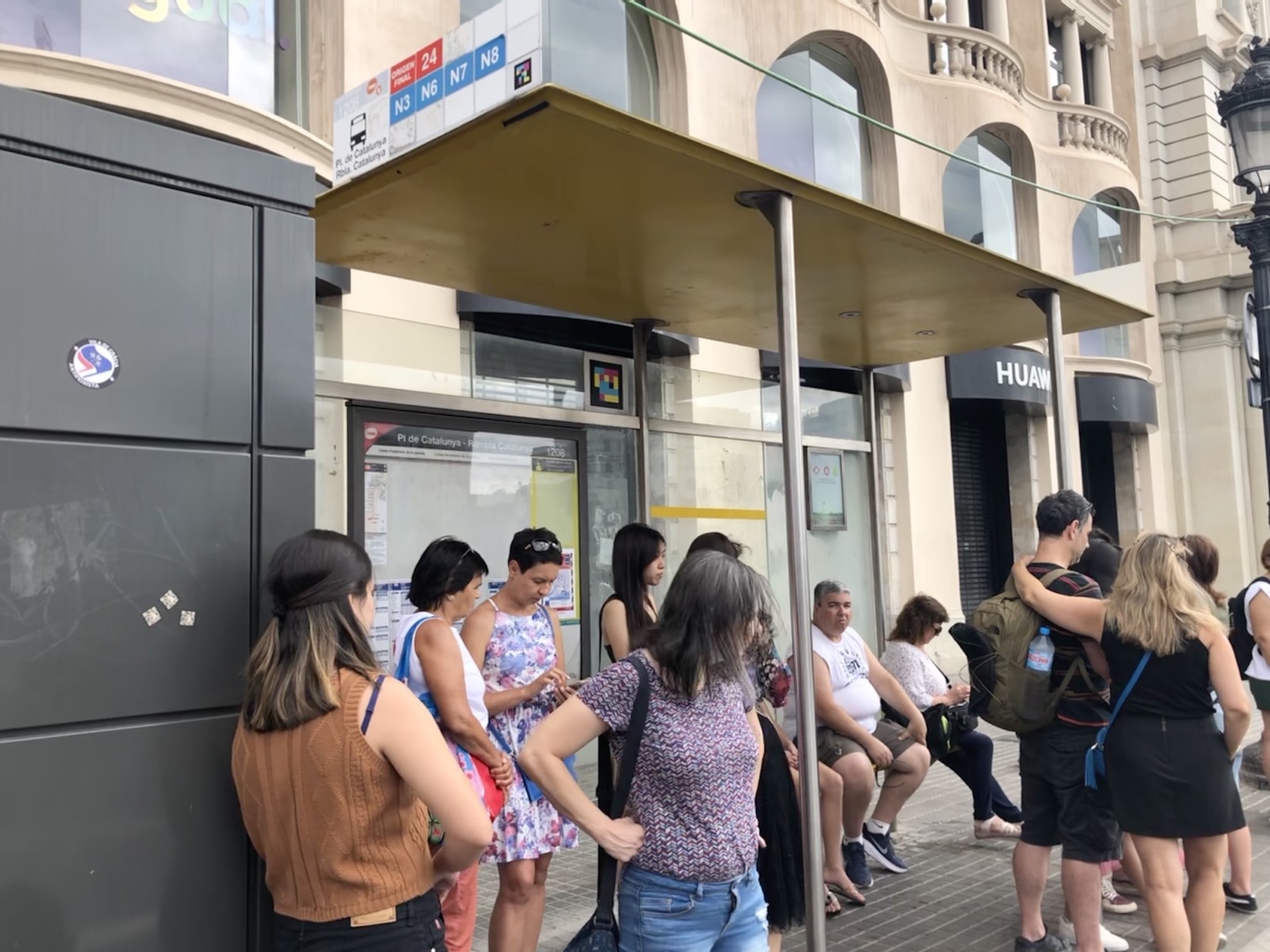
3263 The bus (a regular city bus, not a pre-arranged one like Friday\’s) that I tried to take in the morning was quite late, but it did eventually bring me with a couple blocks of...
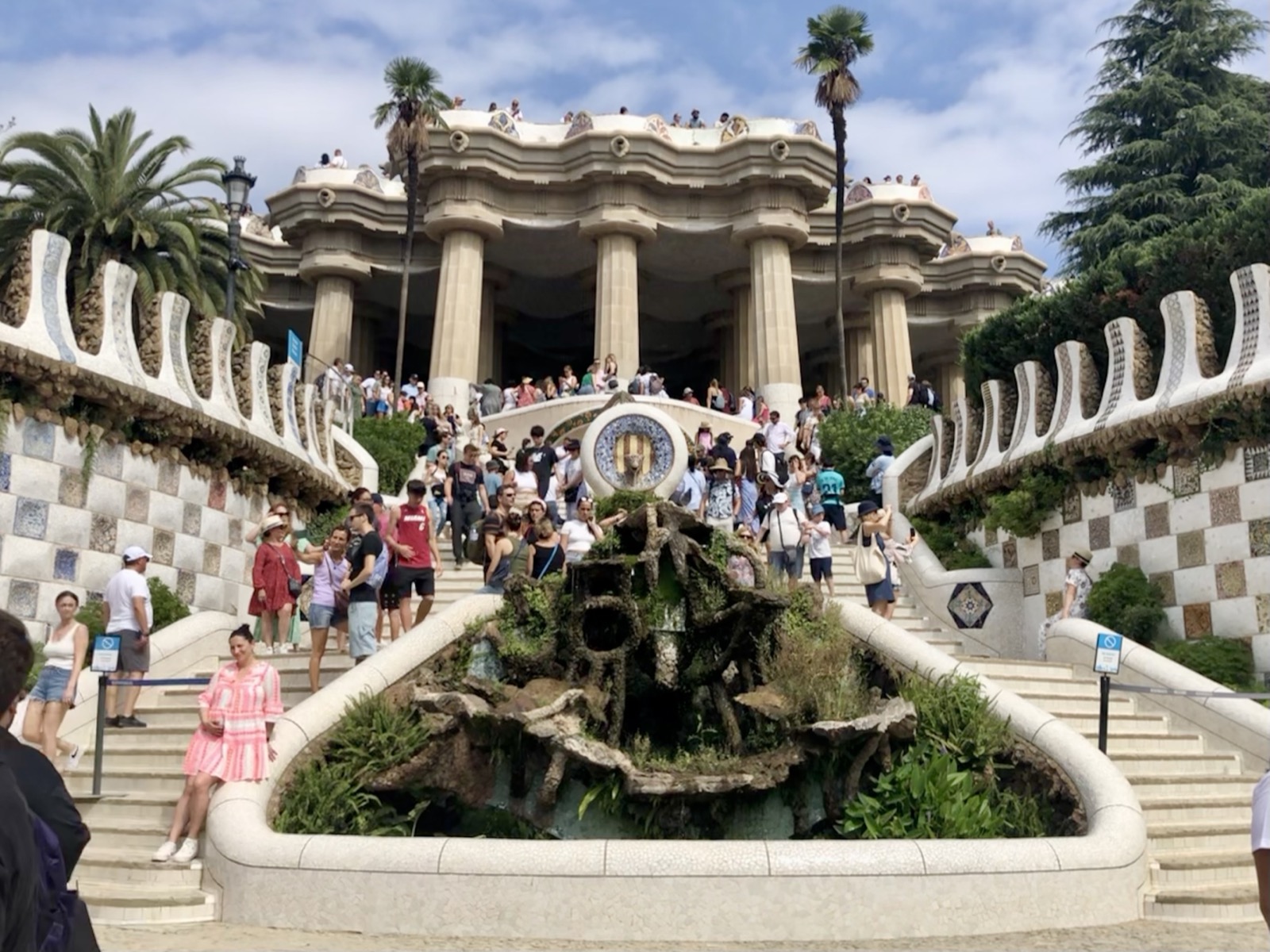
3303 ... Park Güell. Starting construction in 1900, Eusebi Güell planned to have 61 houses for well-to-do families, with shared green spaces between them. Eventually he decided to sell it to the city of Barcelona instead, and it became a public (ticketed) park in 1922.
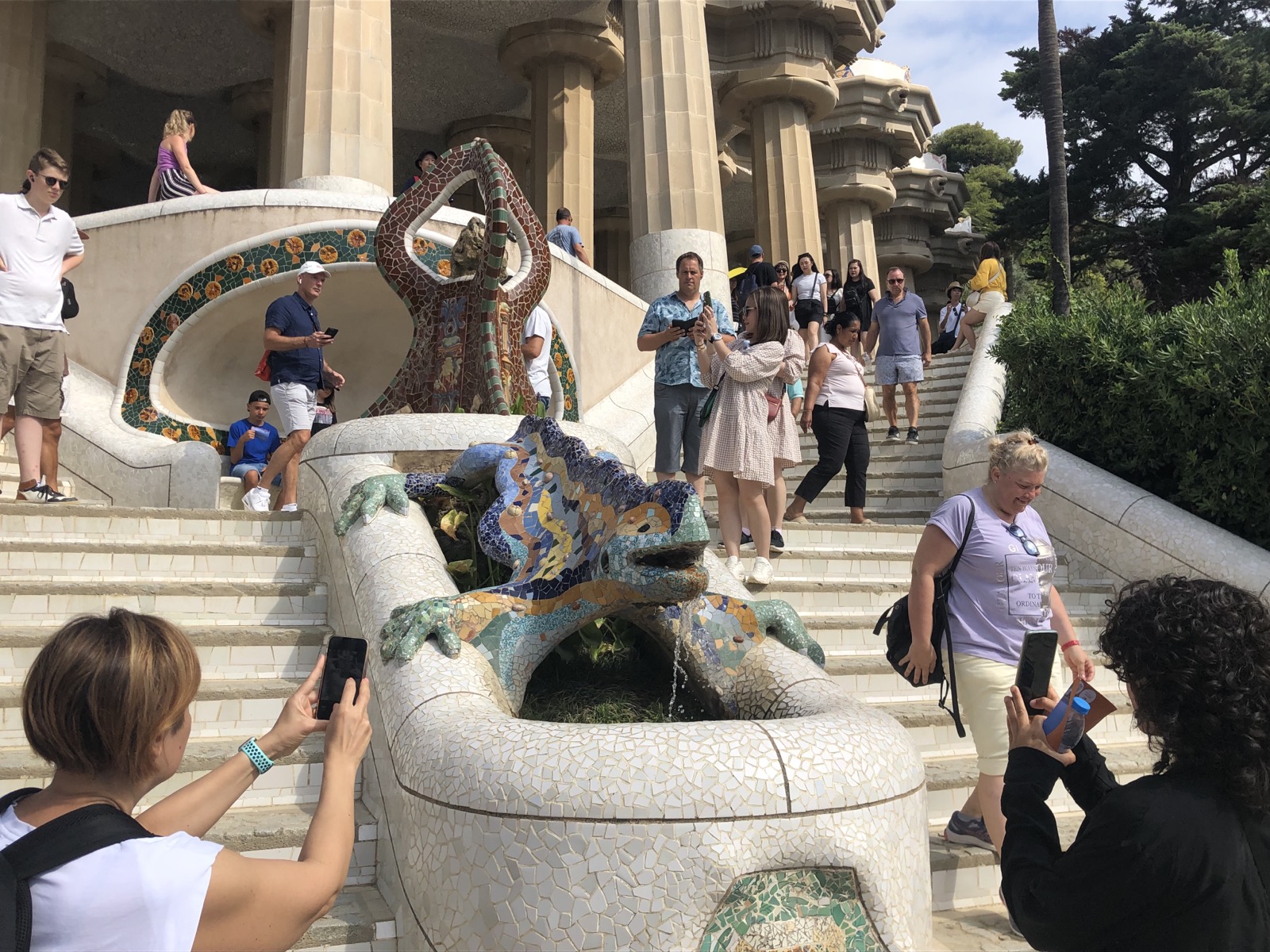
3284 From the beginning, Güell worked with Antoni Gaudí to design the park. His signature mosaic style (actually called trencadís—more on this later) is used in several features, including this piece that is variously called a dragon or a salamander or a lizard.
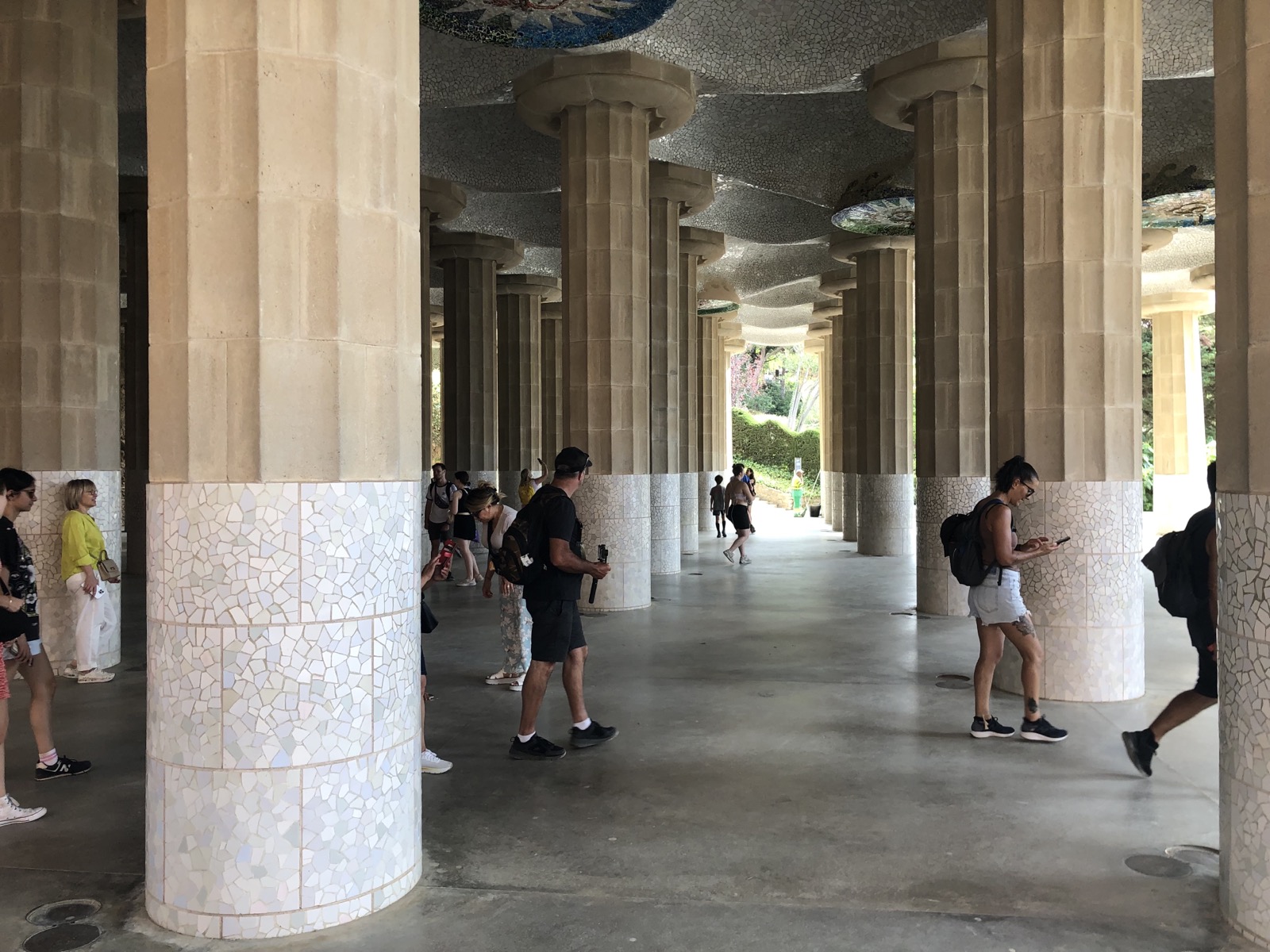
3282 At the top of the stairs is the Pillared Hall. My photo shows just part of two circular patterns on the ceiling (one cut off at the very top, and one partly blocked by a pillar).

3270 Above the Pillared Hall is a large standing/seating lined with benches. From certain angles you can look out over most of Barcelona.
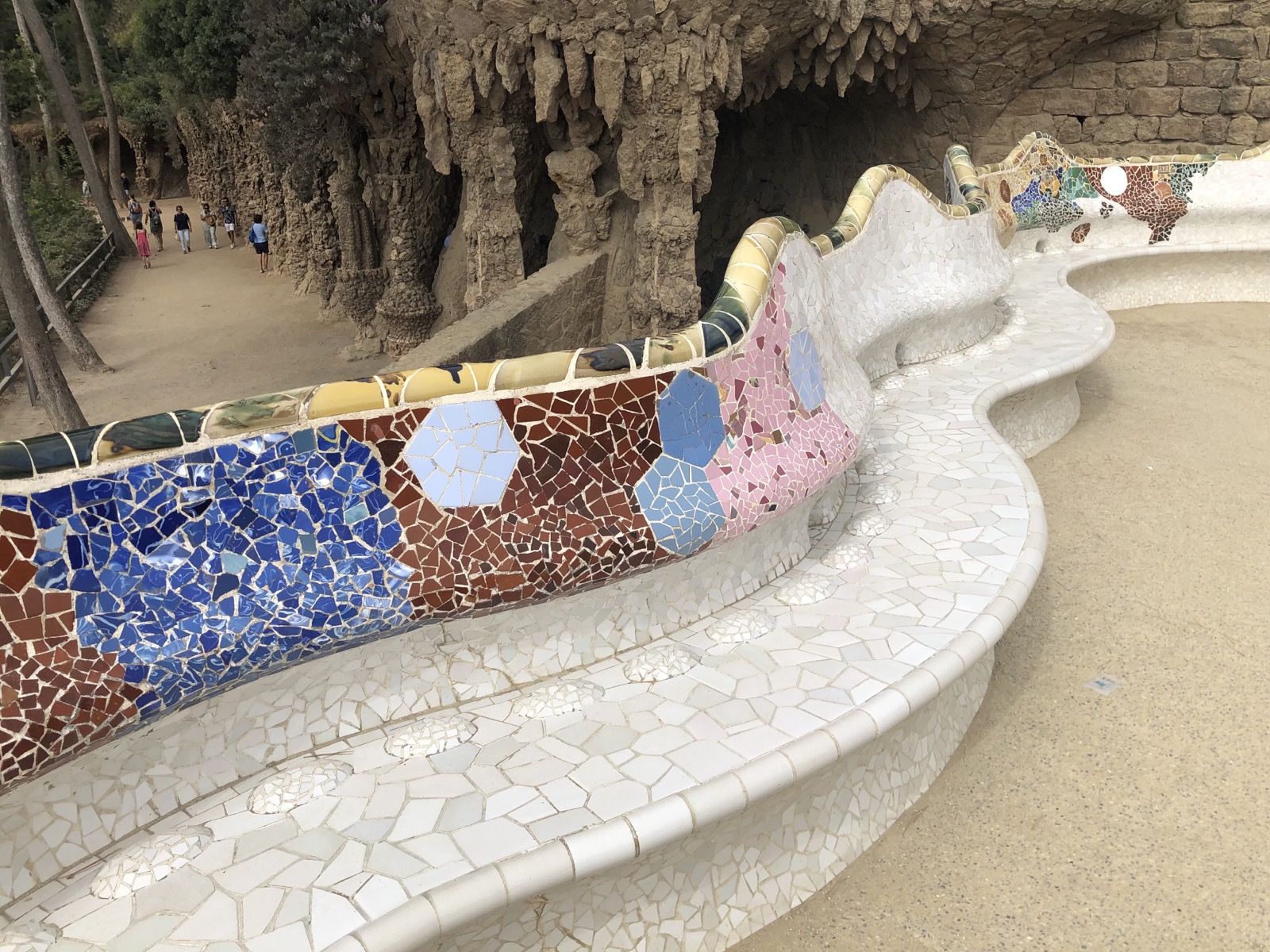
3275 The benches are beautiful too. Behind them you can see the entrance to a stone hallway of sorts, one side formed from brown columns. The top of the entrance resembles stalactites from a cave or teeth from a giant beast.
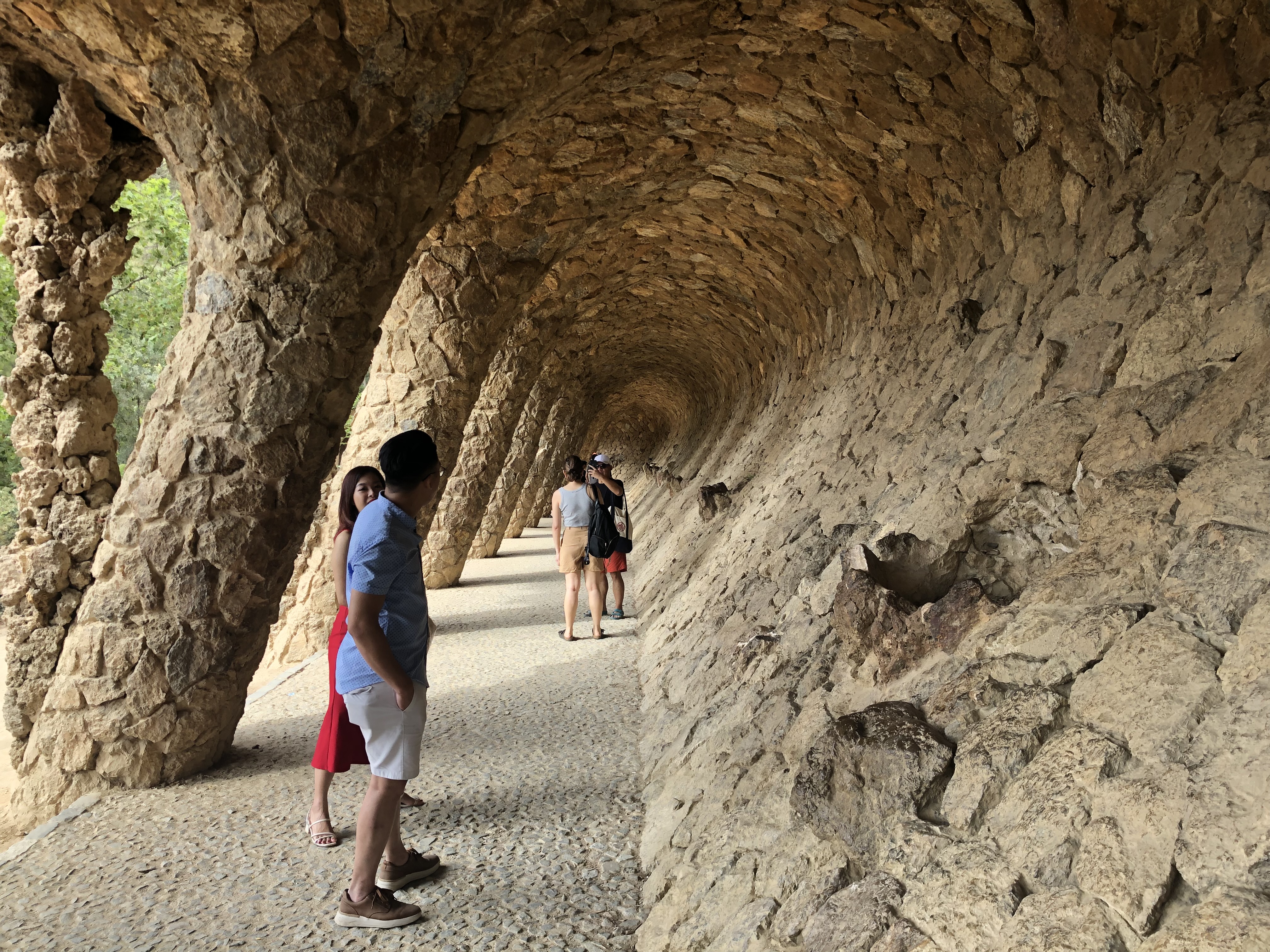
3276 The hallway/walkway from the background of the previous photo.

3279 Further along the path, the columns twist more as the walkway goes around a corner.
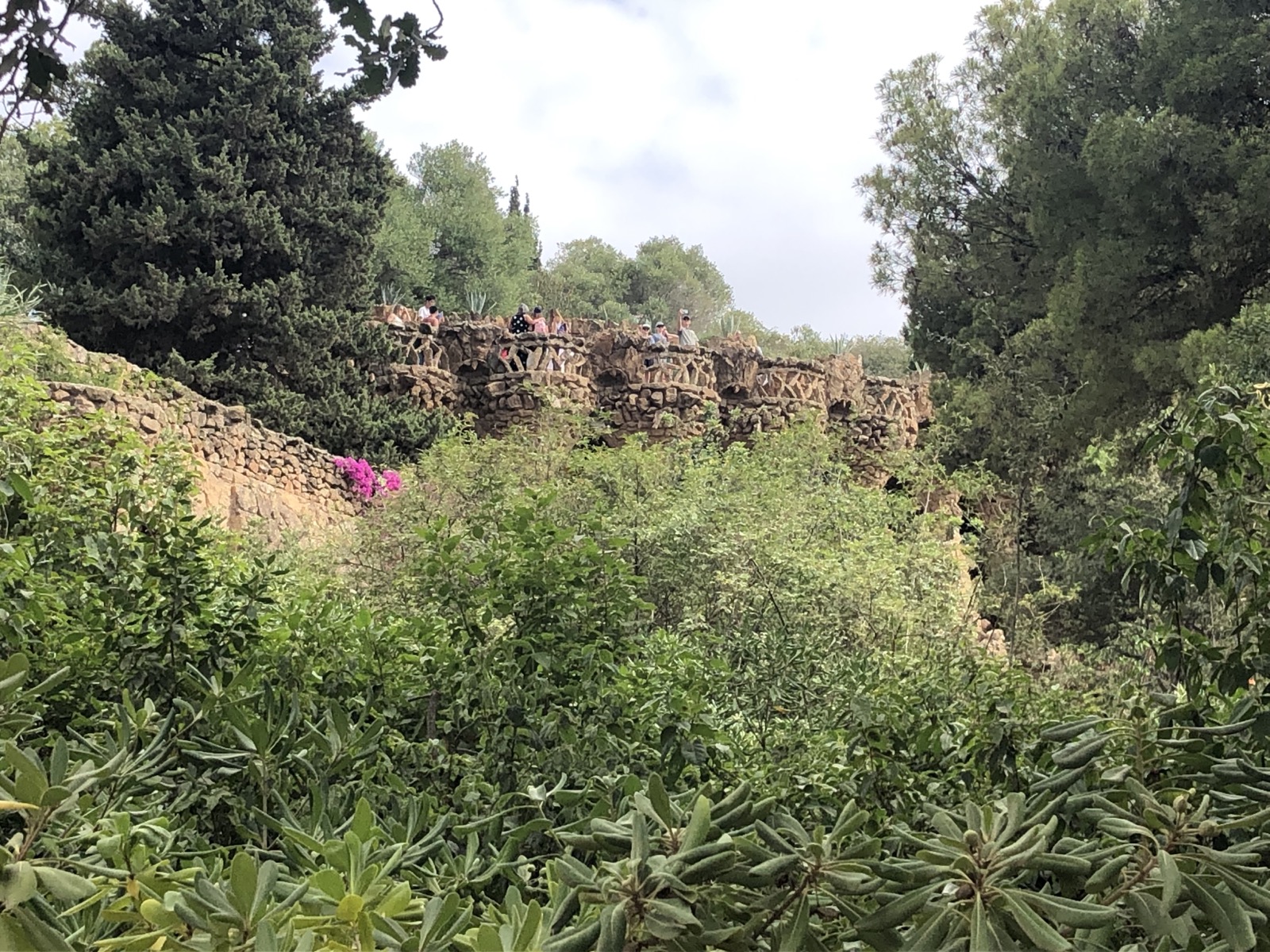
3267 The park is huge. When walking around you can often see people in a different path in the distance.

3307 However, navigating it can also be confusing. There are maps, but they do not show the presence of several gates that effectively require you to go in one direction around the central monuments, sometimes walking in a very large loop to reach a spot just on the other side of a gate.
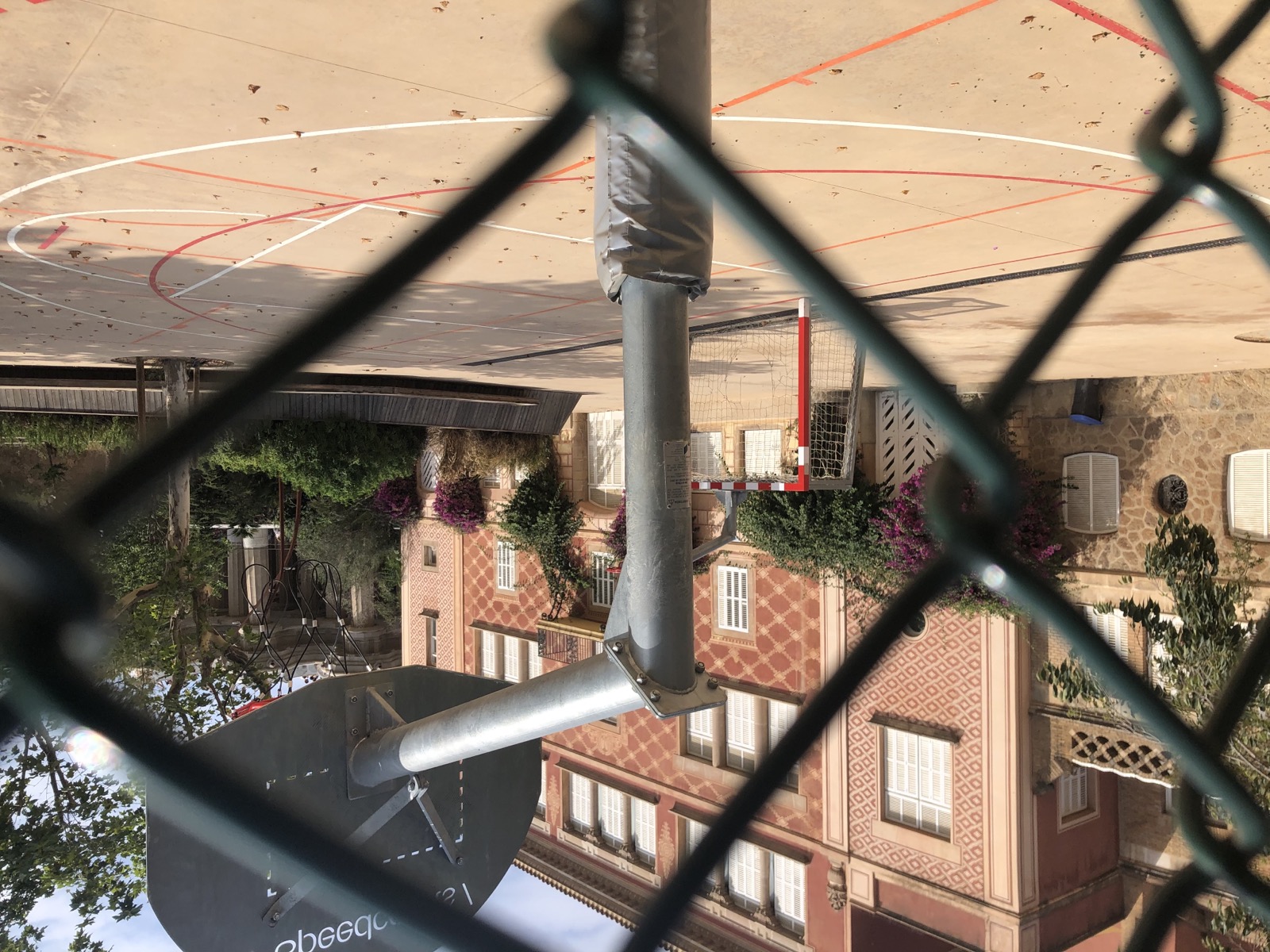
3299 Eusebi Güell lived in this house, although it was owned by the Can Muntaner de Dalt family. After the city took over the whole park area, this building was converted into a public school in 1931.
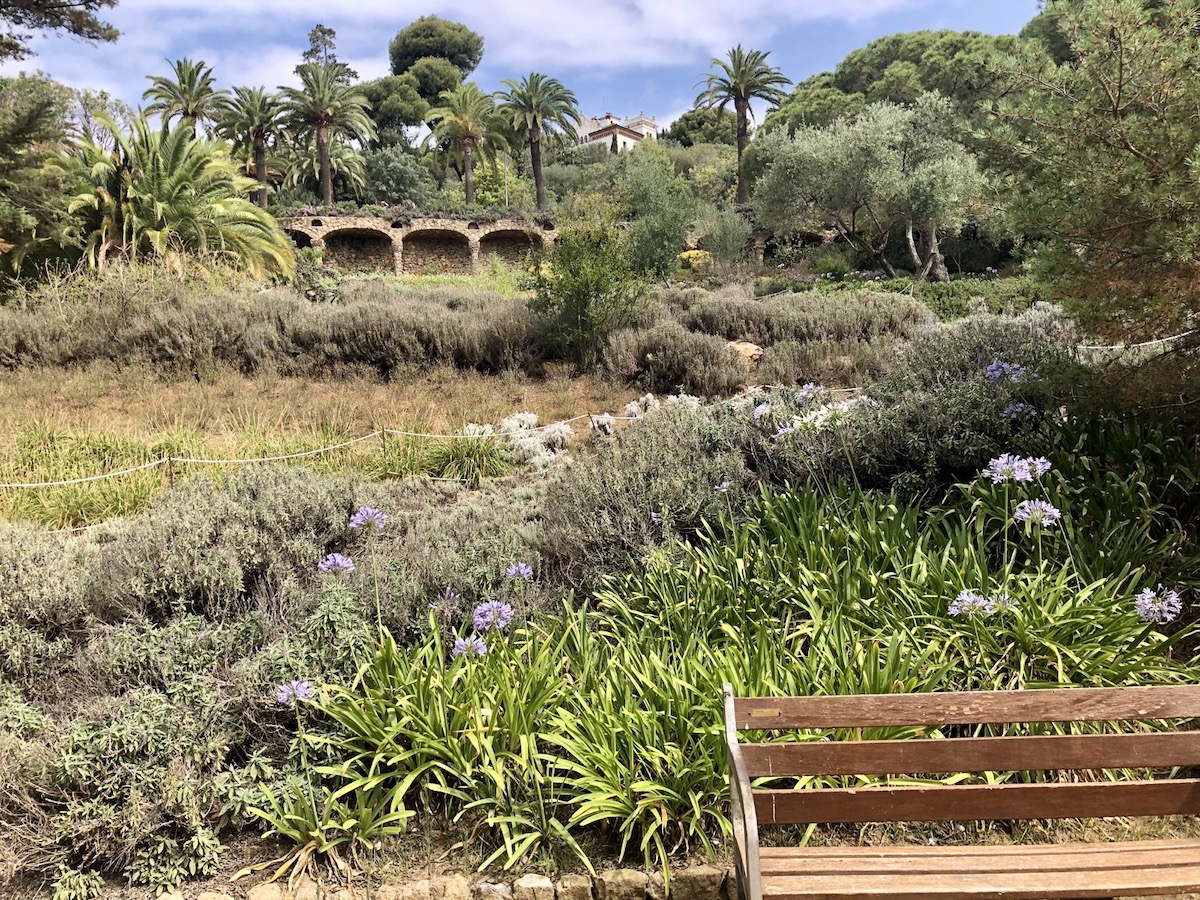
3305 The Austria Gardens (so named because many of the plant species come from Austria) was, similarly, originally a private garden for a house within the park. Today it is a municipal nursery.
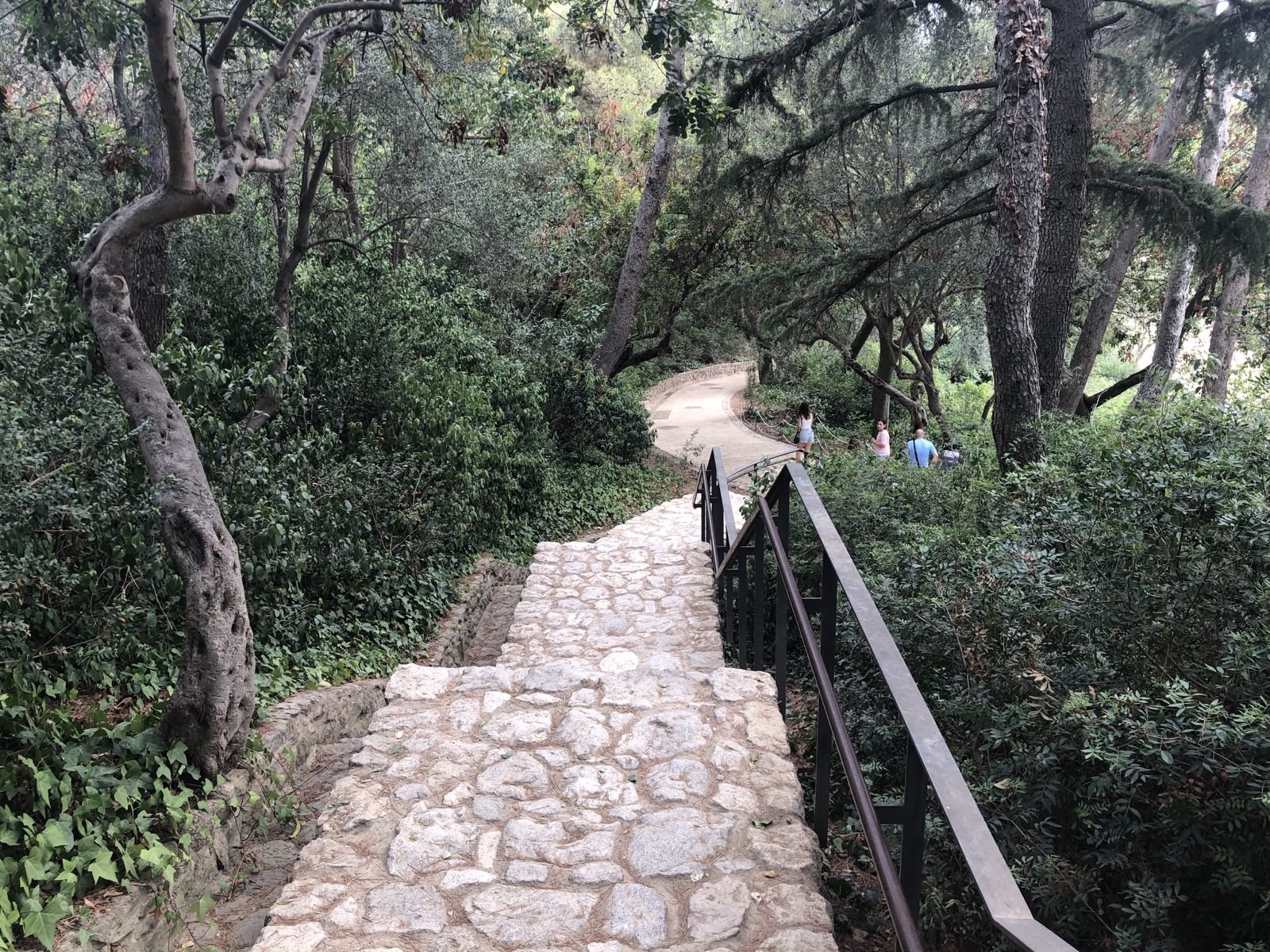
3272 Again, it’s a big park.
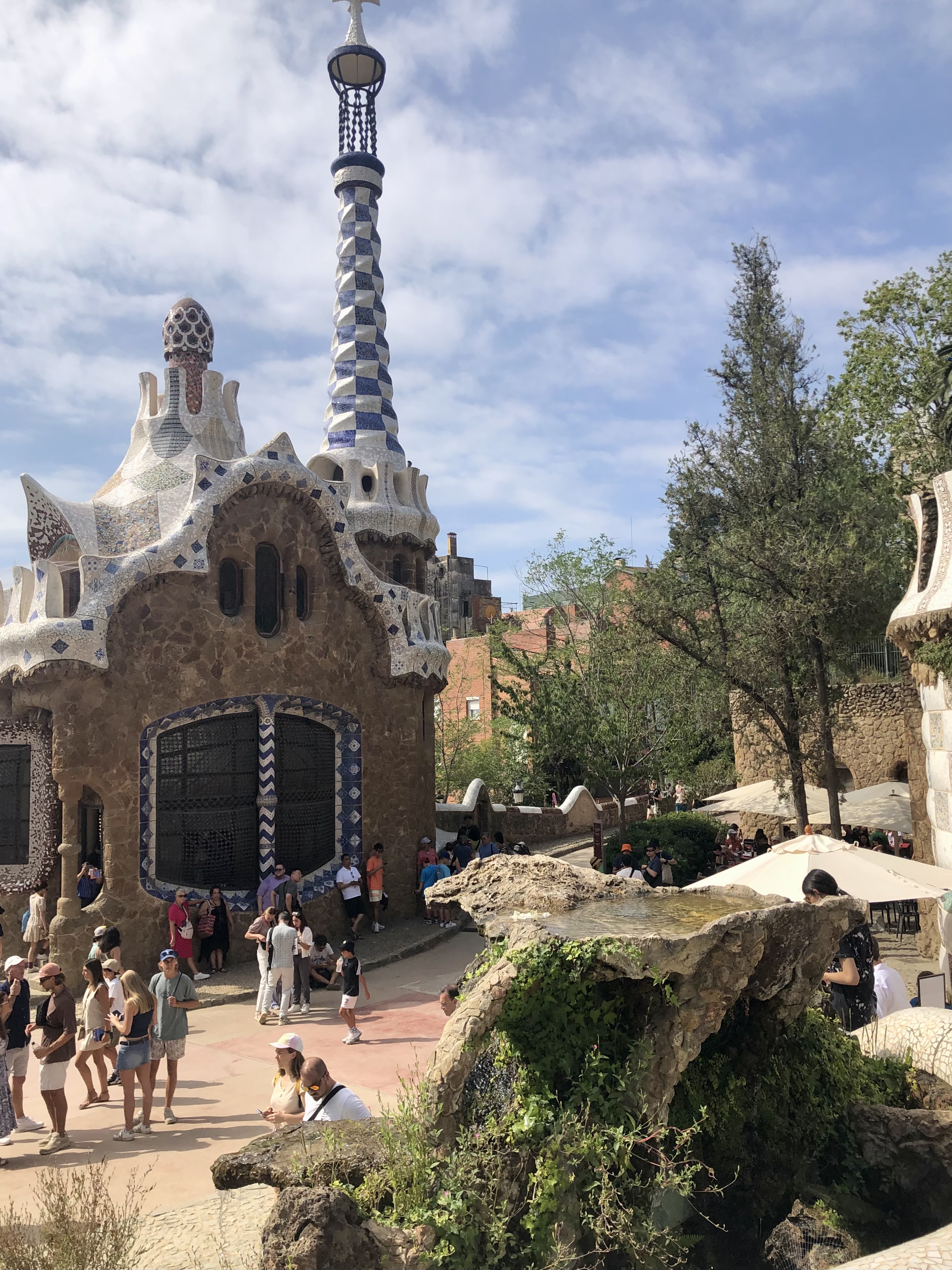
3291 One of the most recognizable buildings (near the bottom of the main stairs) is actually the gift shop.
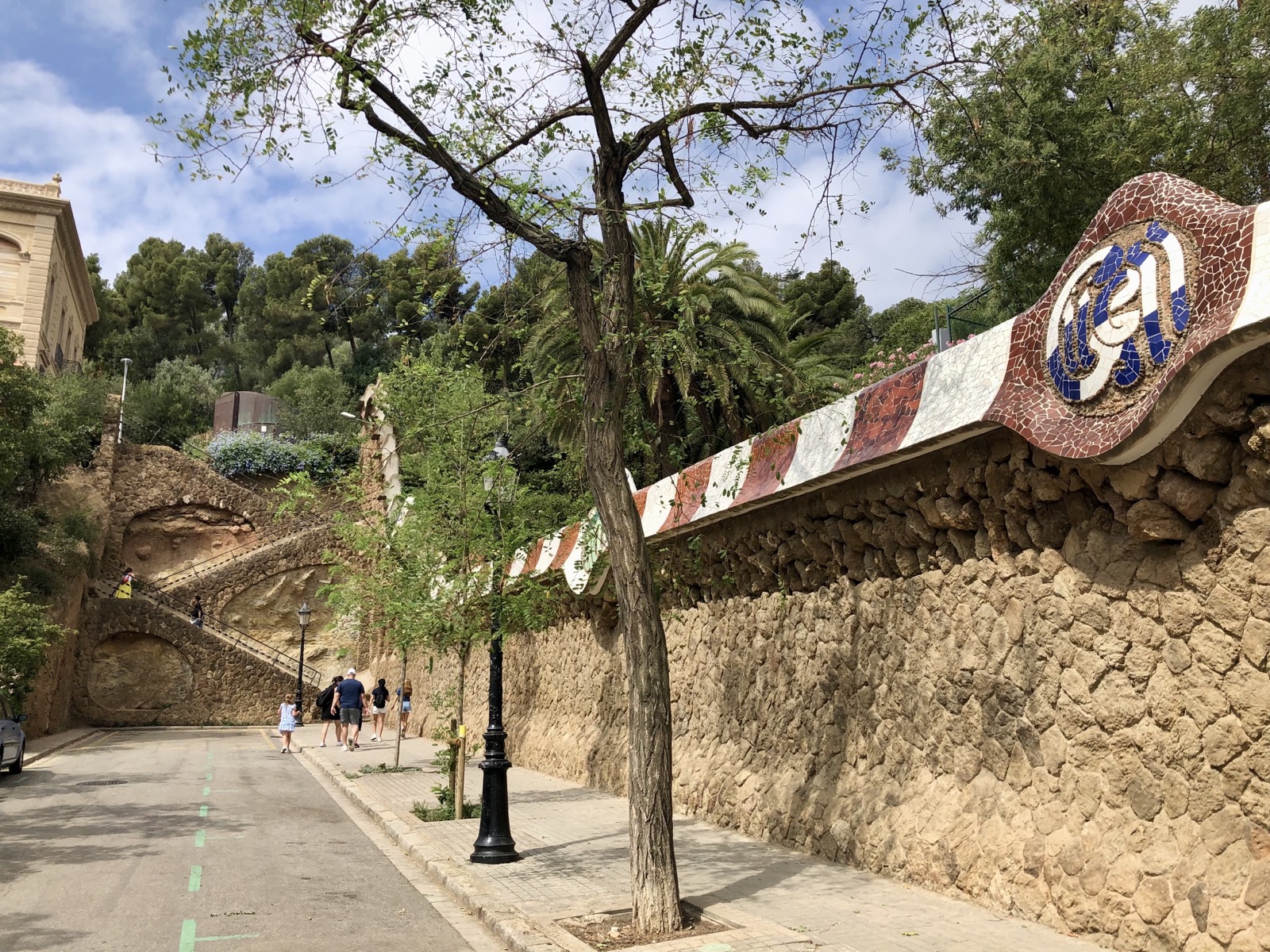
3313 The street just outside the park. The wall with periodic circular bumps can be seen in the previous photo too.
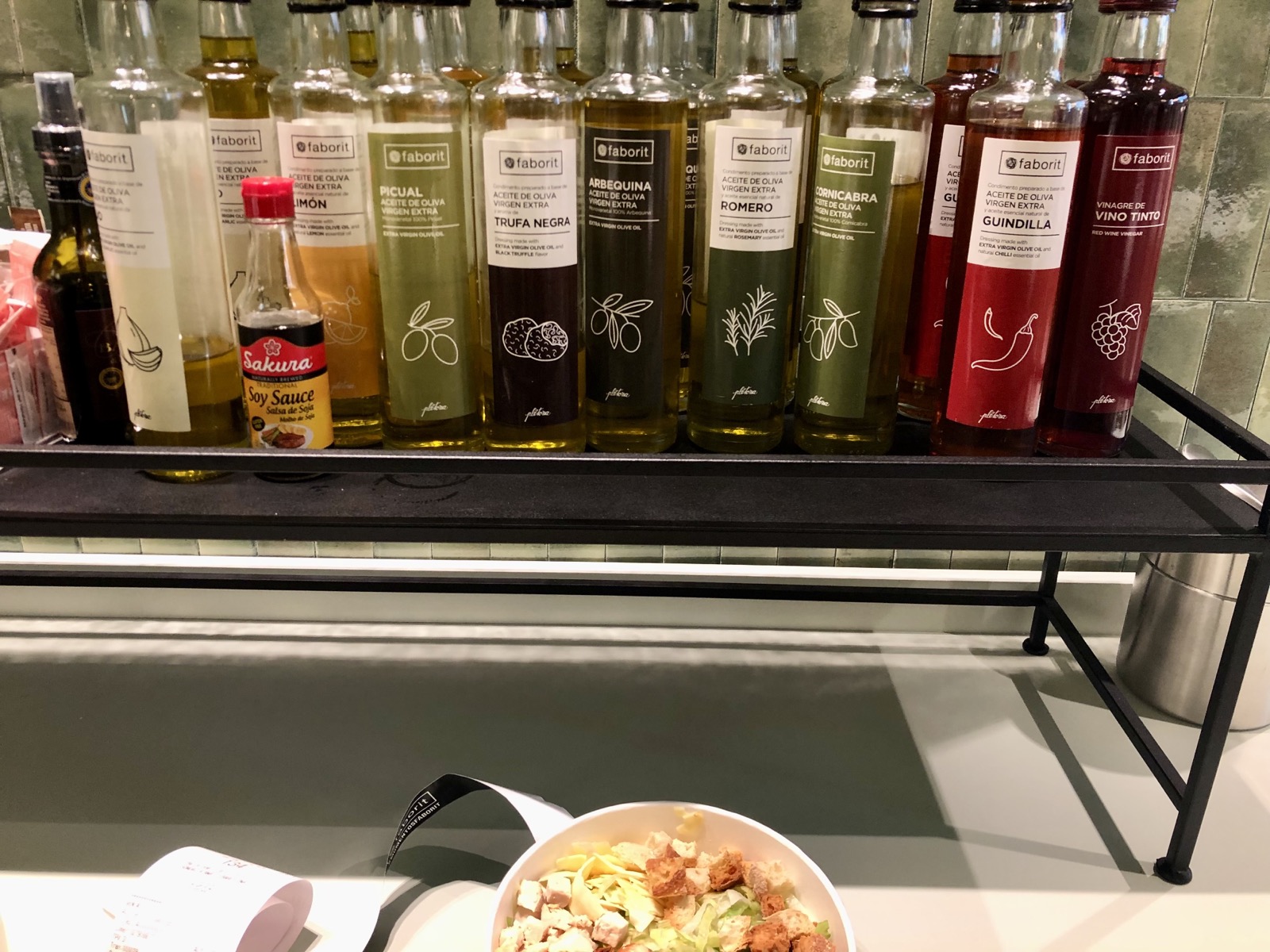
3330 Lunch after walking around the park. I realized that I had a lot of sandwiches and paella over the last several days, so a salad would probably be good for me. I was not prepared for the variety of oils and vinegars available.
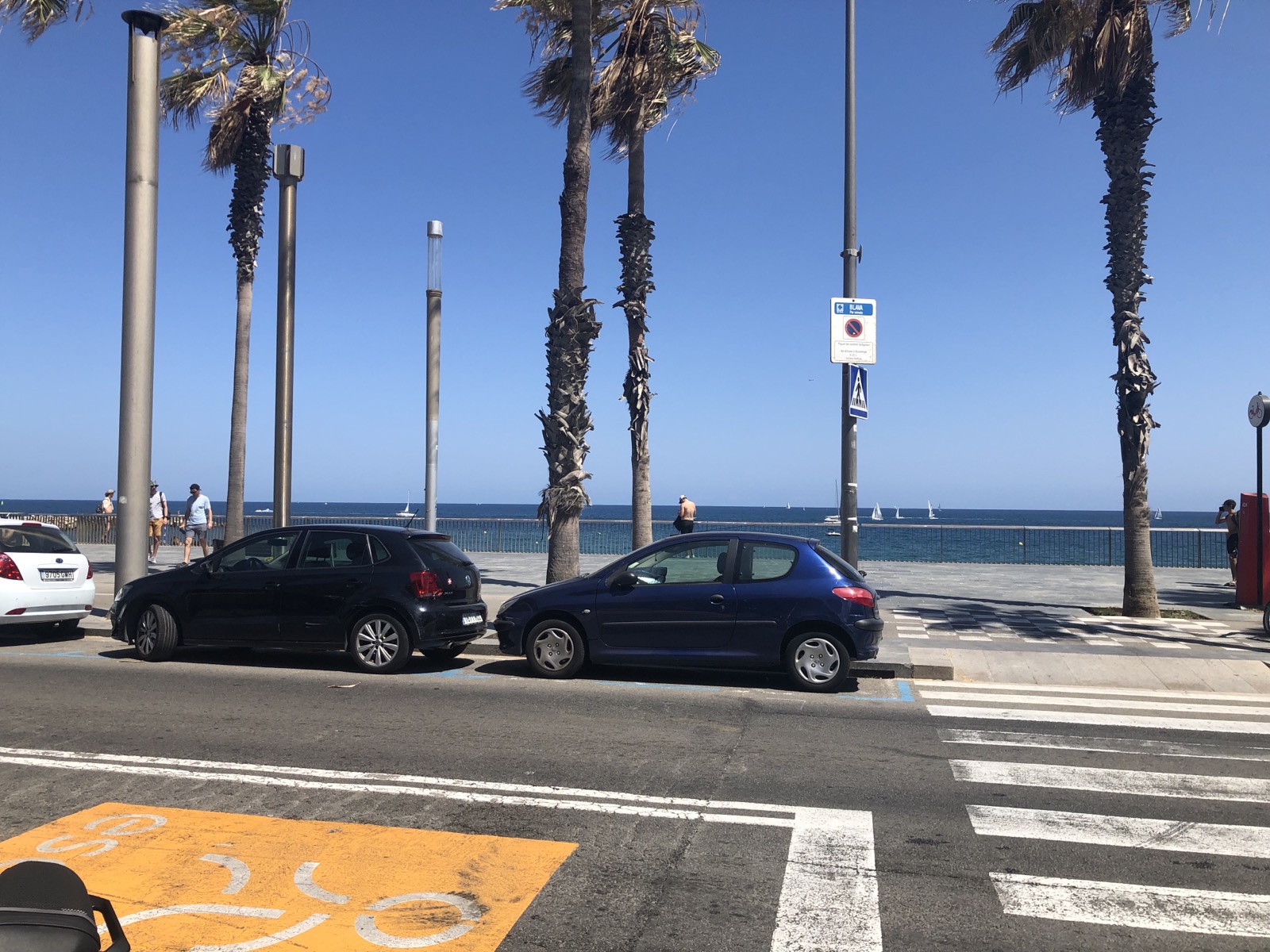
3221 For the afternoon I decided to go to the beach. Unlike in Porto, there are beaches very close to the city (in fact I walked from my AirBnB, about 30 minutes).

3218 Of course there are also docks.

3211 And also a lot of palm trees.

3223 I expected the beach to be crowded on a weekend in the summer. But I still wasn’t expecting it to be quite this full.
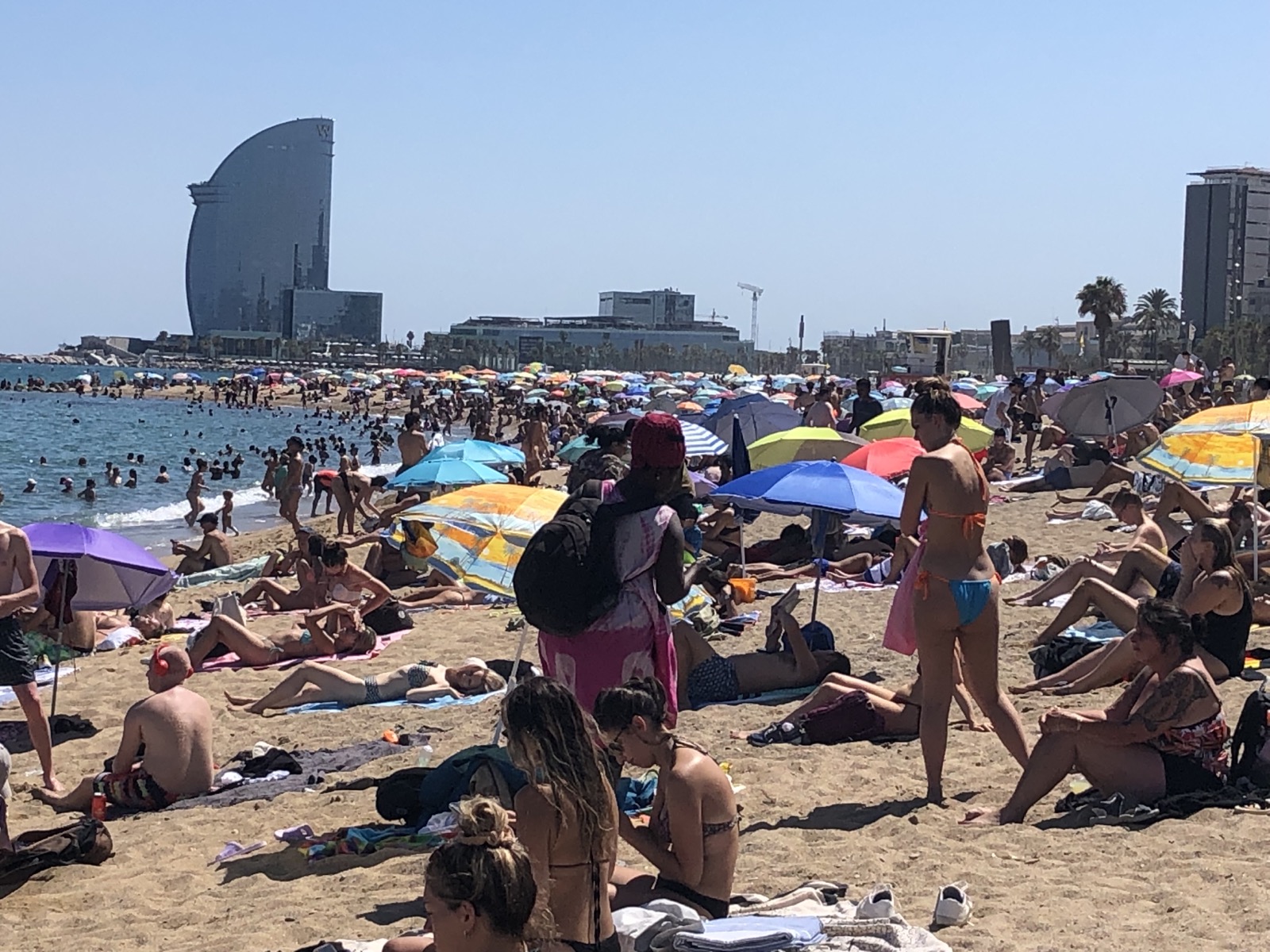
3229 A little further down the beach (you can still see the huge group of umbrellas in the distance) it was much better.

3230 And once I was actually in the water it was not too crowded at all. I’m not sure whether this is because of the location or the specific day, but the water here was also much warmer than at Matosinhos.
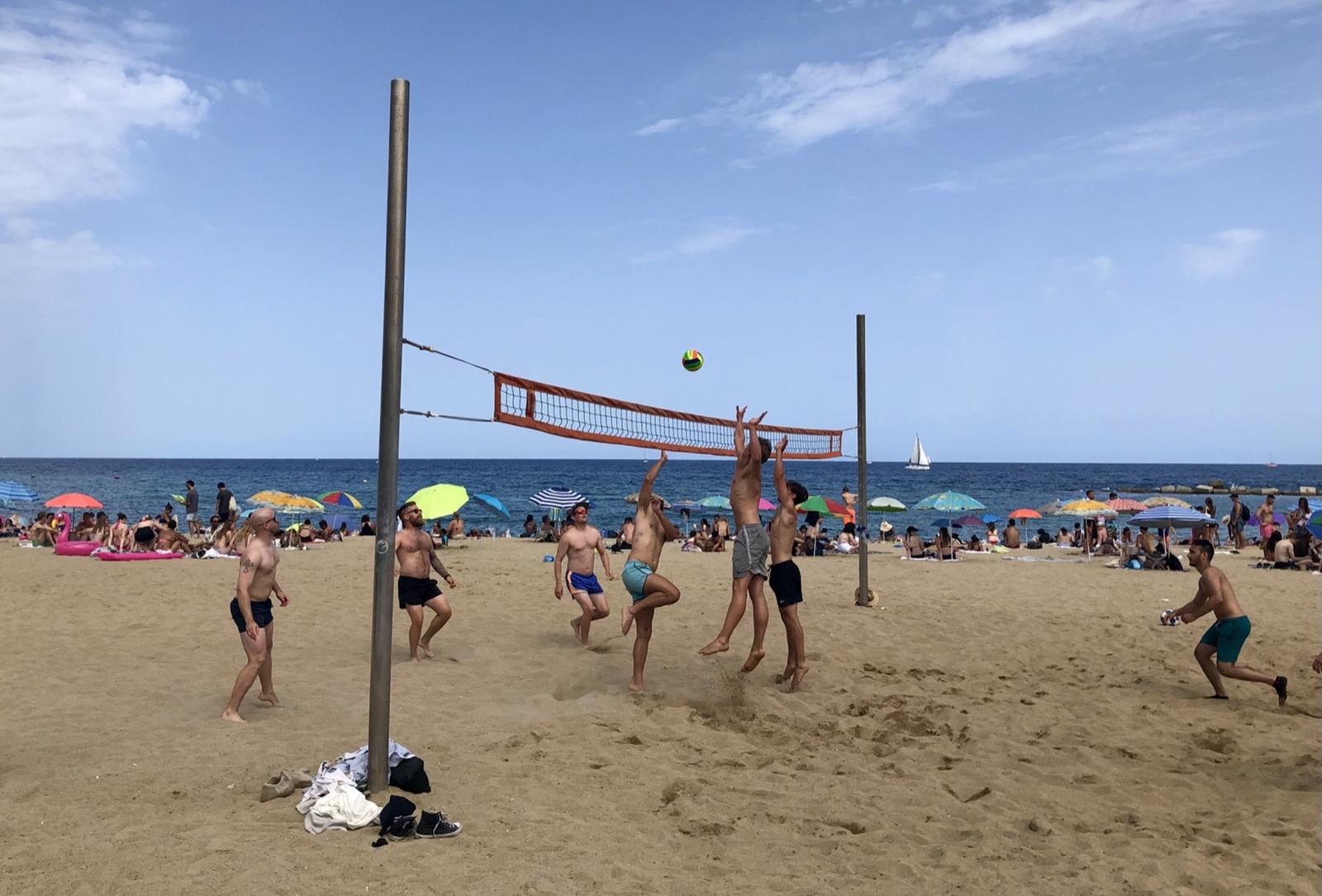
3522 While I was mostly there to swim, many people were sunning and some were playing volleyball.
Sunday, 16 July 2023

3343 The entrance to the Palau (Palace) Güell, where the previously-mentioned Güell family lived, is relatively unassuming.

3356 By contrast, the main hall of the Güell Palace is quite ornate.

3358 The same hall viewed from the balcony on the left of the previous photo. This was where musicians would play live music when the Güells were entertaining guests.

3354 The dining room, which is barely visible through the lower-level door in the photo from the musicians’ area.

3352 Across from the dining room was a smoking room with an impressive window. The center pane is acid-etched and shows Spanish soldiers. It is a reproduction of part of Manuel Ferrán Bajona’s painting “Antonio Pérez Liberated by the People of Zaragoza in 1591”.
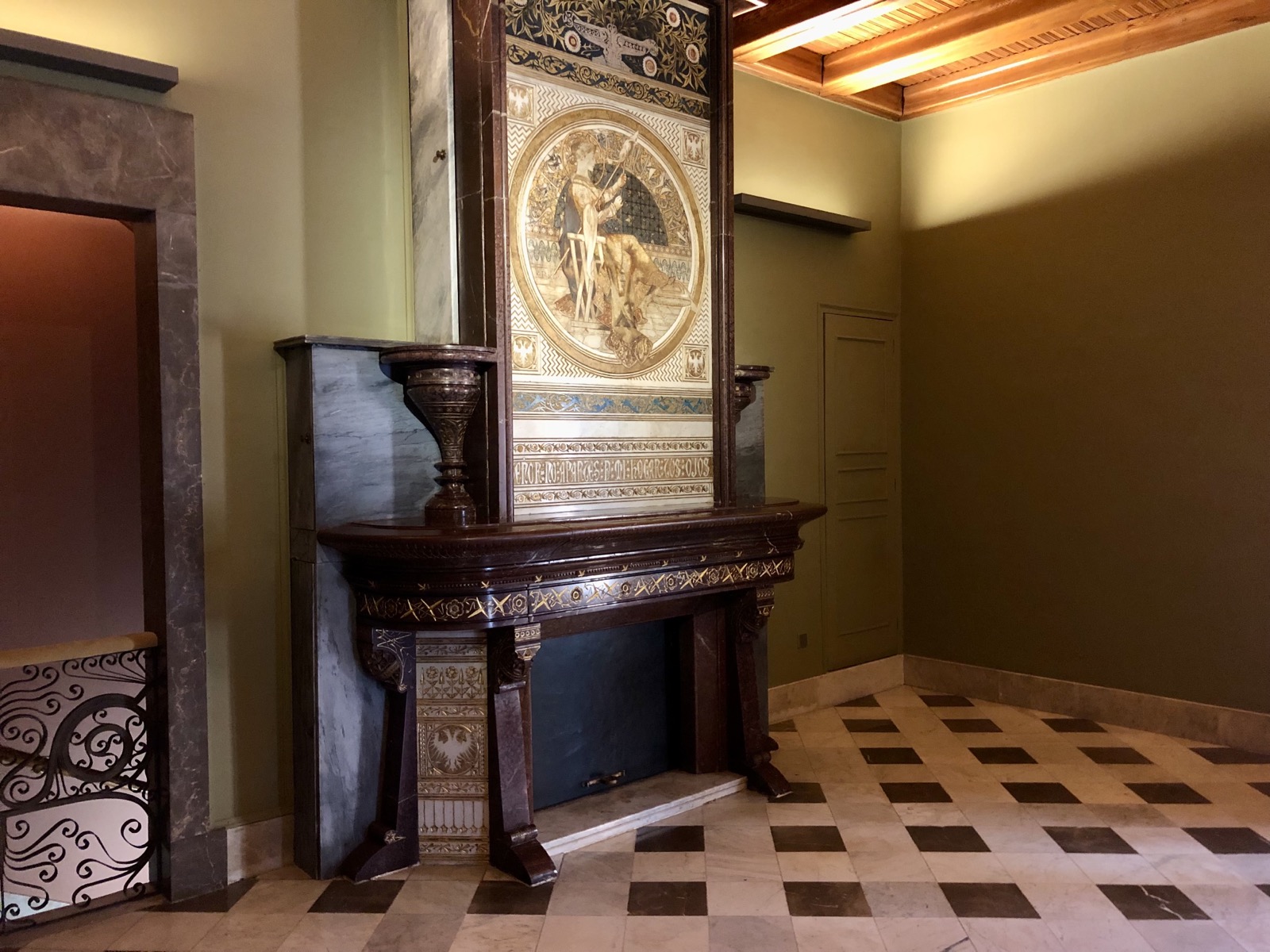
3367 Upstairs are several bedrooms, each of which has its own fireplace. That requires a lot of chimneys, as we’ll see later.

3370 Bathrooms. The Venetian-style sandstone tiles are known as ojo de perdiz (lit. eye of partridge).
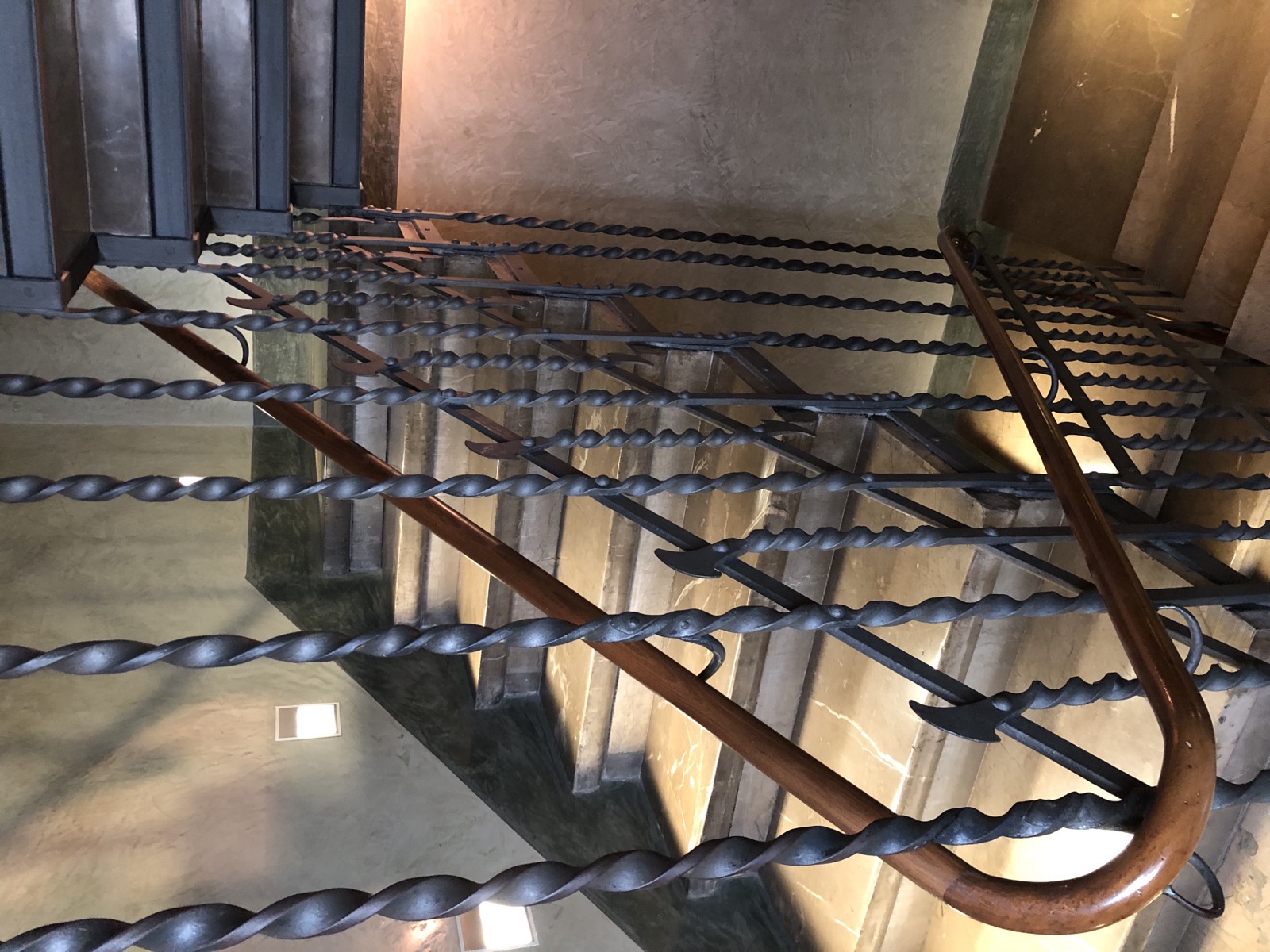
3372 This staircase was mainly for servants and is the only one that reaches all floors of the house.
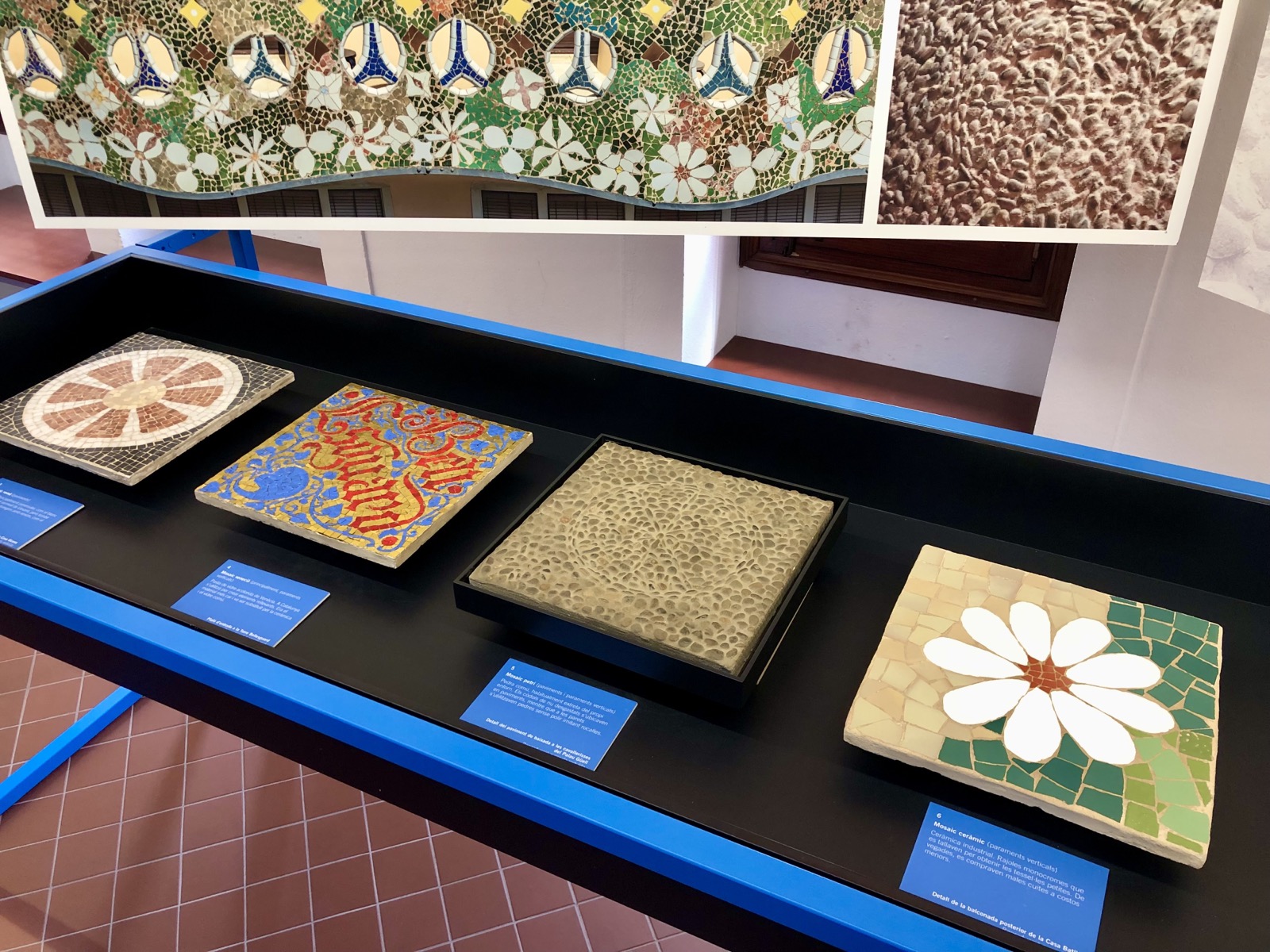
3380 The top floor of Güell Palace is a small exhibit about trencadís mosaics. Made from irregular pieces instead of a regular square grid, trencadís became one of the most recognizable features of Gaudí’s artistic style.
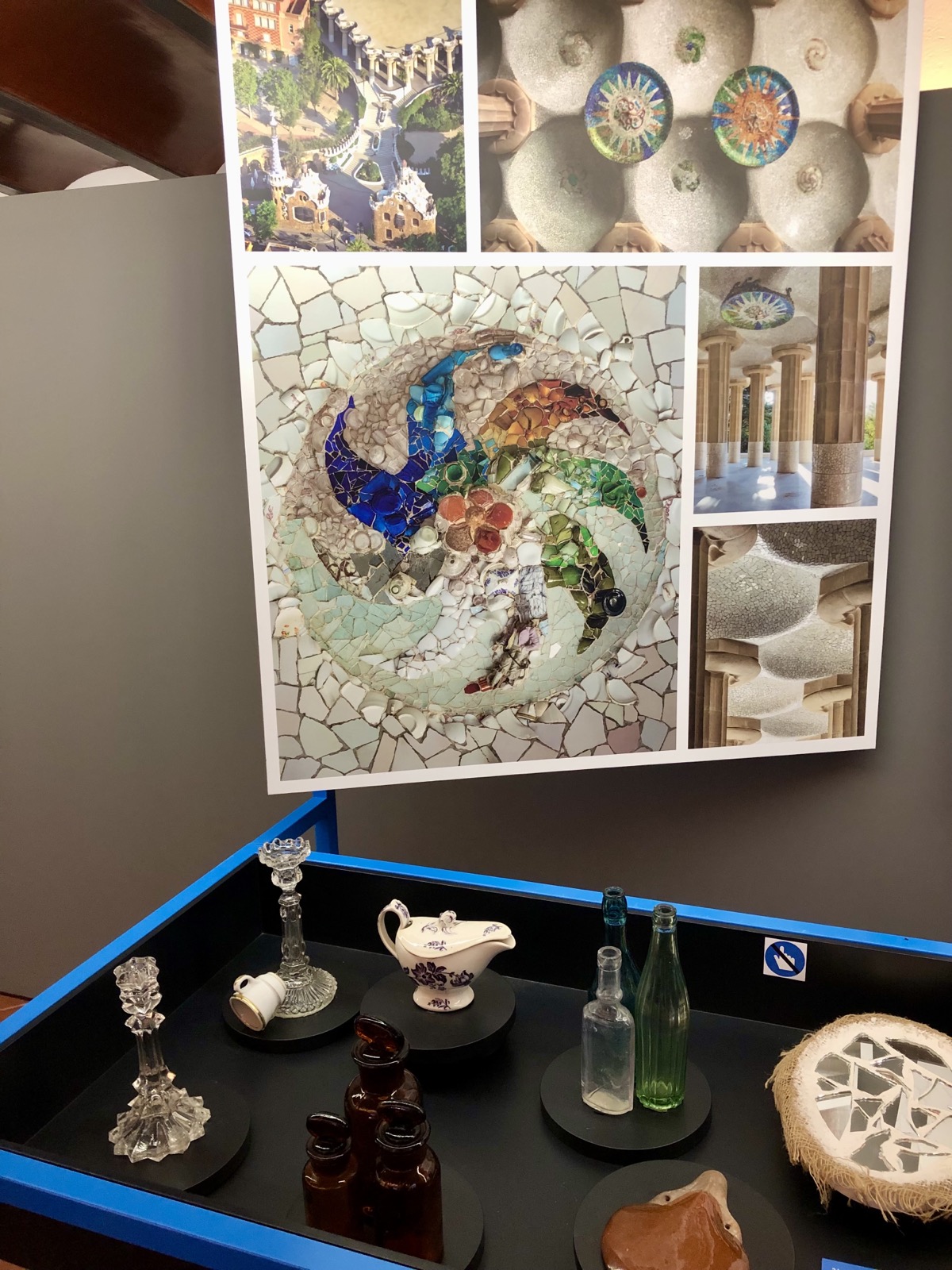
3384 Many of the trencadís tiles were made using recycled material, such as colored glass bottles. The spiral sun design by Josep M. Jujol is from the ceiling of the Pillared Hall at Park Güell.
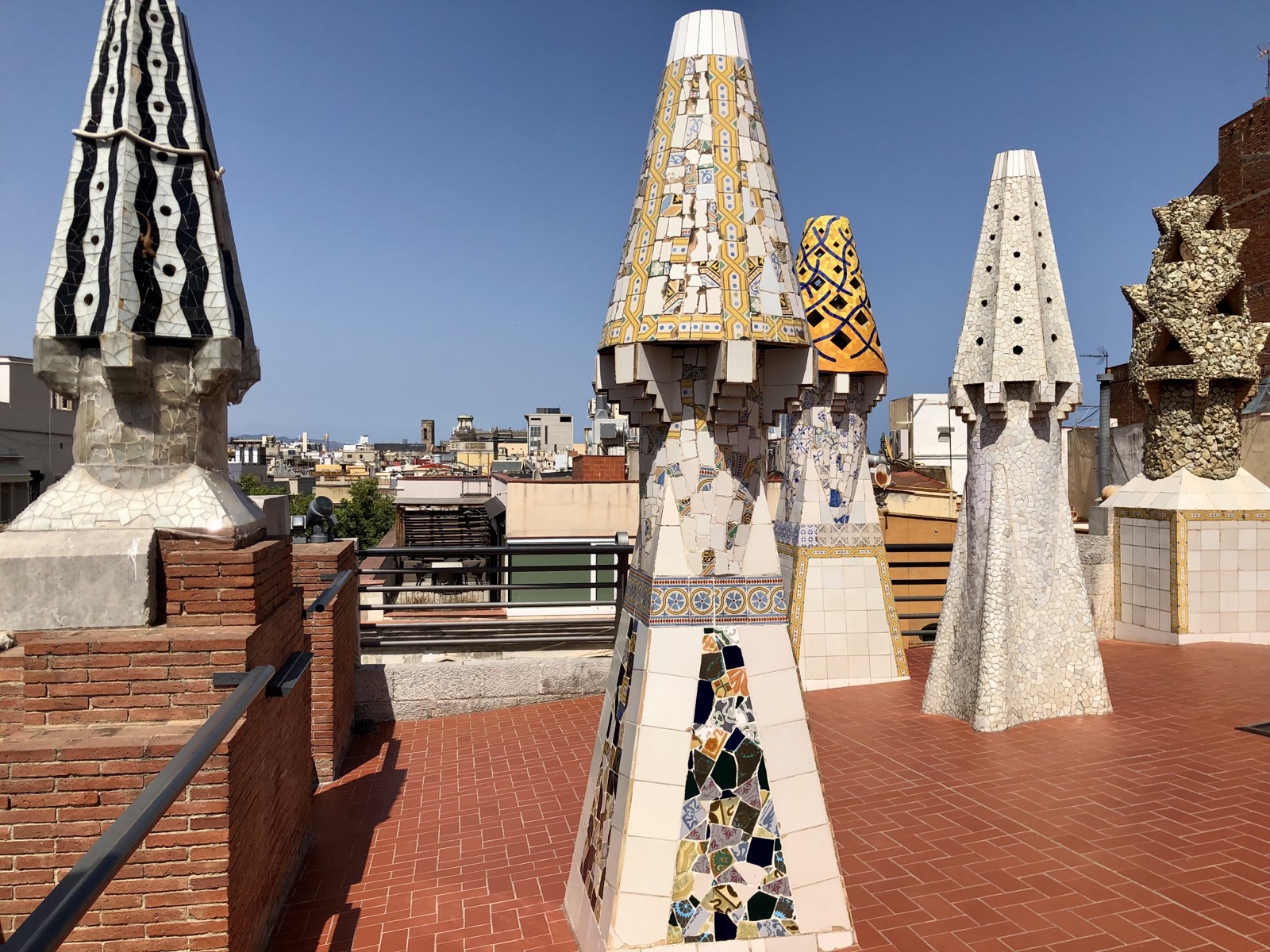
3390 The roof of Güell Palace is undulating, rather than flat or uniformly slanted. It is also full of beautifully-decorated chimneys, 15 of which serve the fireplaces mentioned before. The others are exhaust for the kitchen.
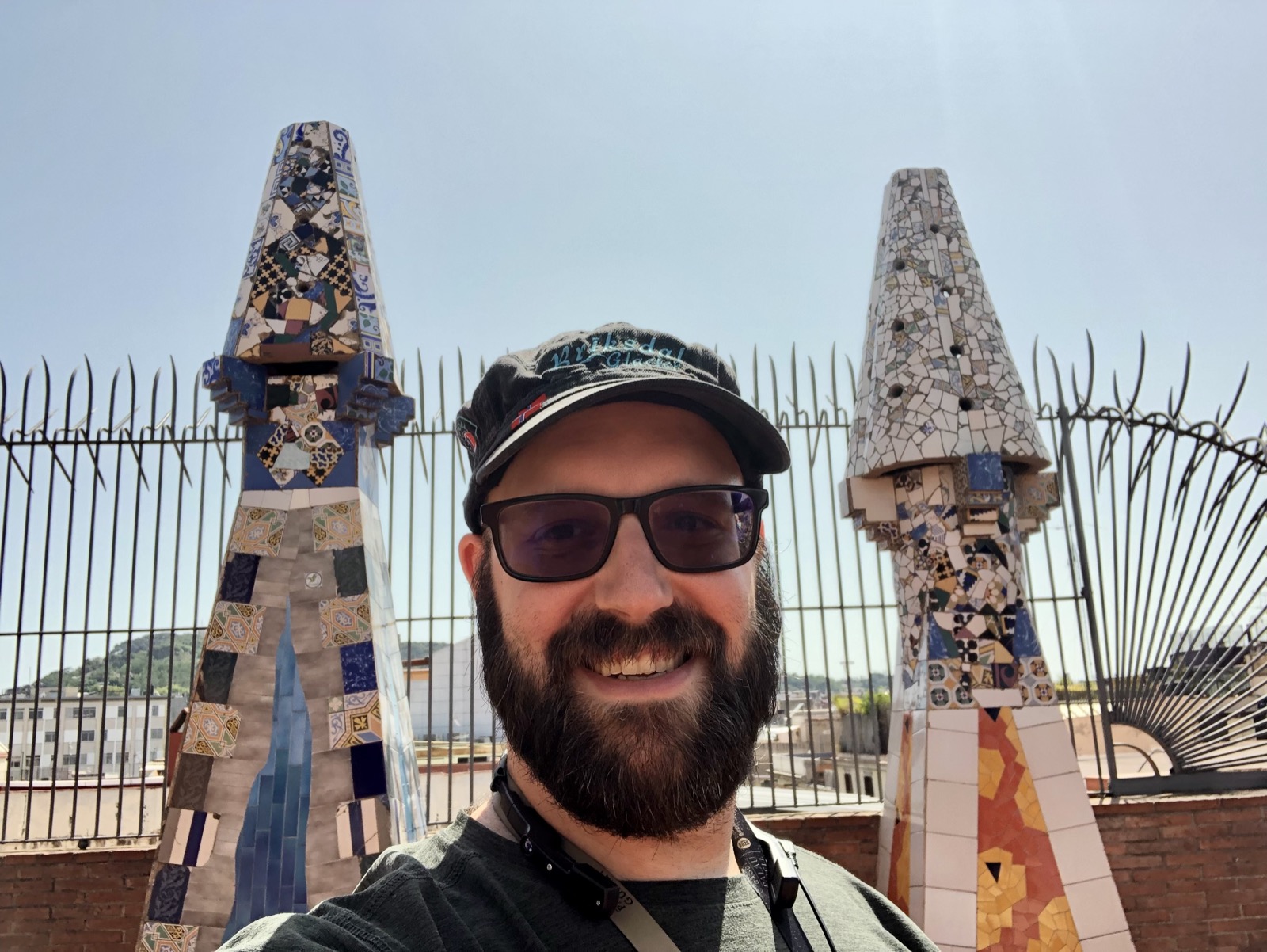
3402 More chimneys, and of course me.
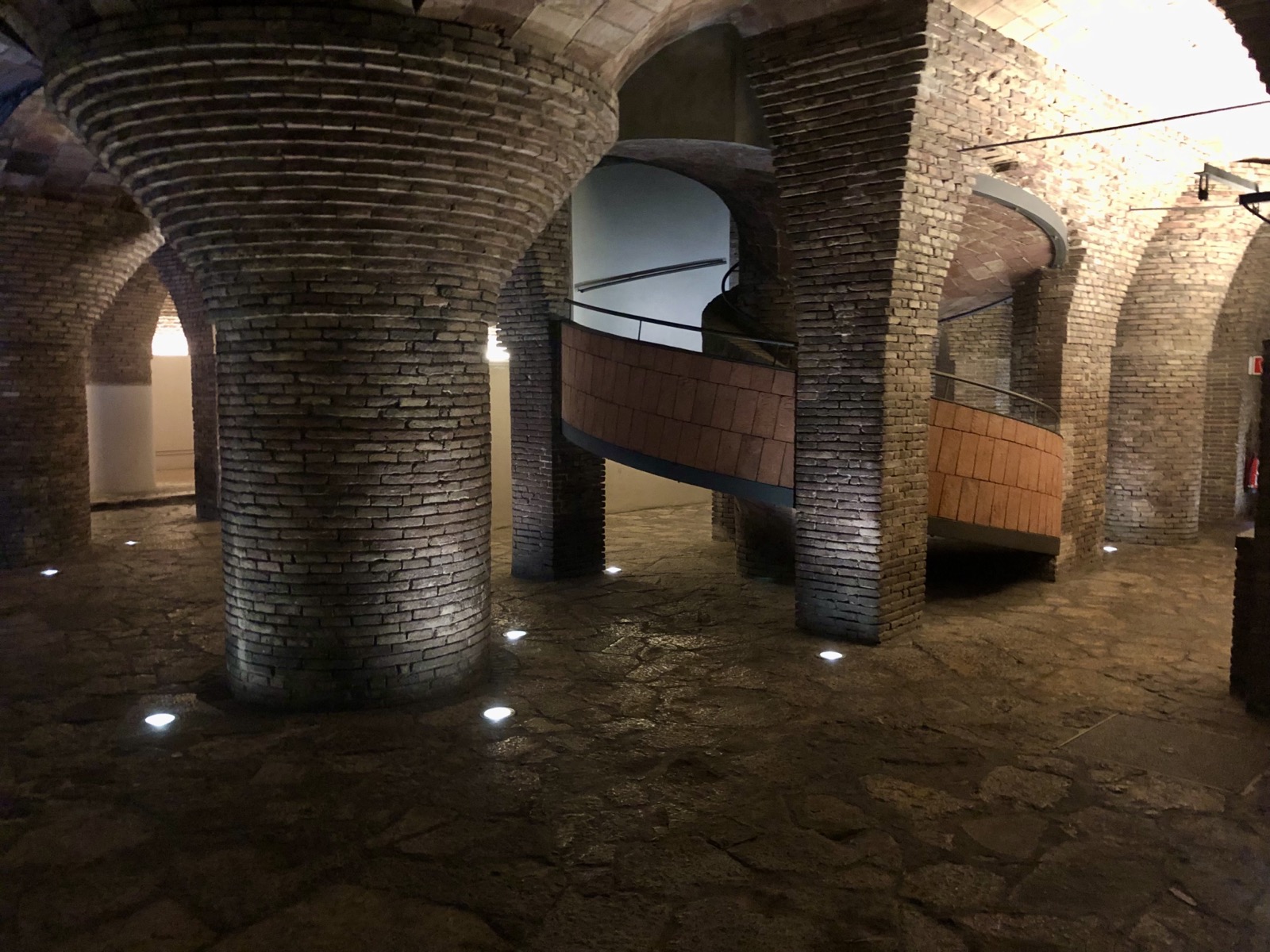
3346 The bottom floor of the Güell Palace was a stable for horses. I assume there was an entrance/exit from this floor in the past, but now is a basement below the entrance floor.
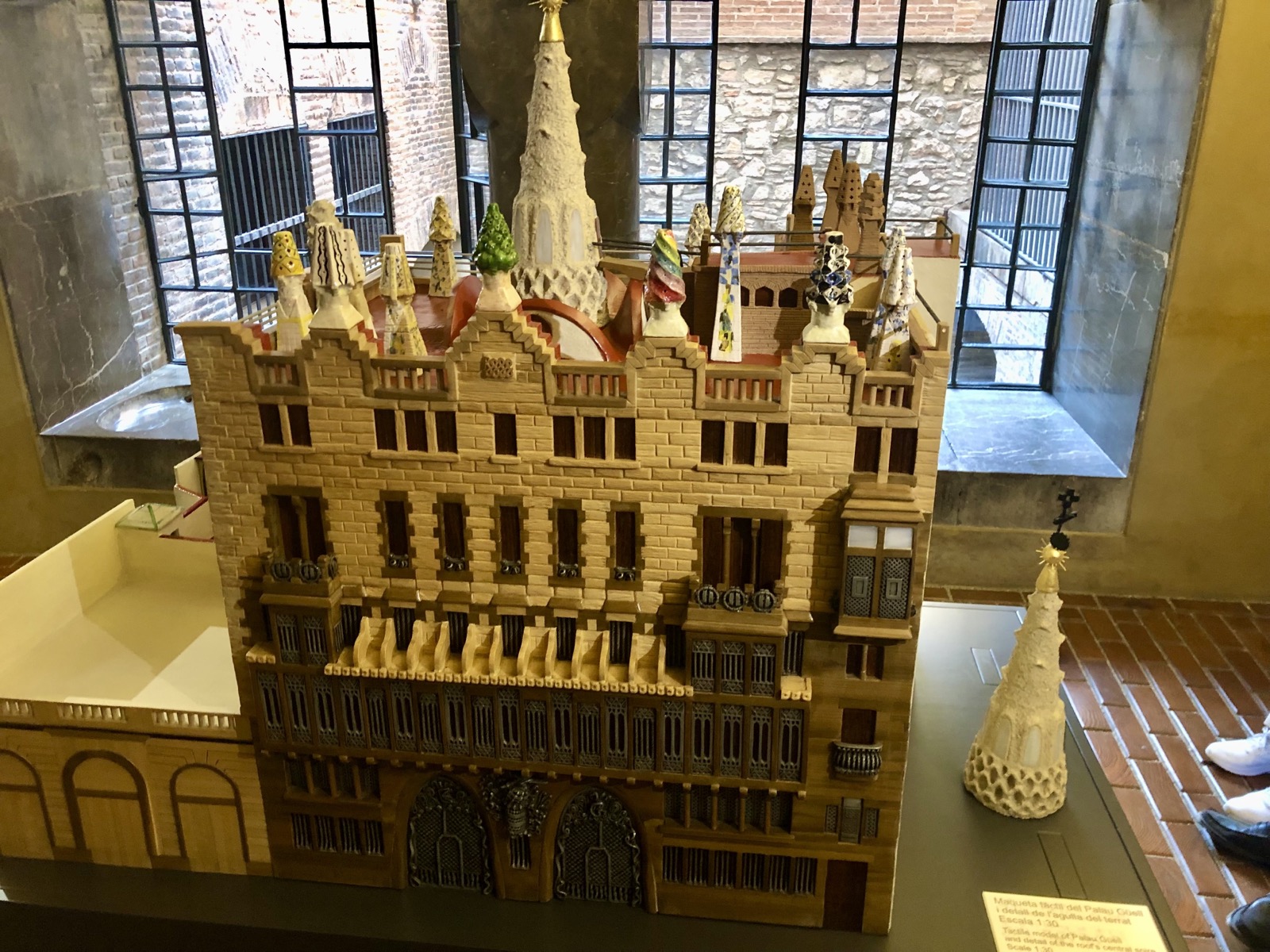
4345 Near the gift shop there is a large &ldquoltactile model&rqduo; of the entire Güell Palace.
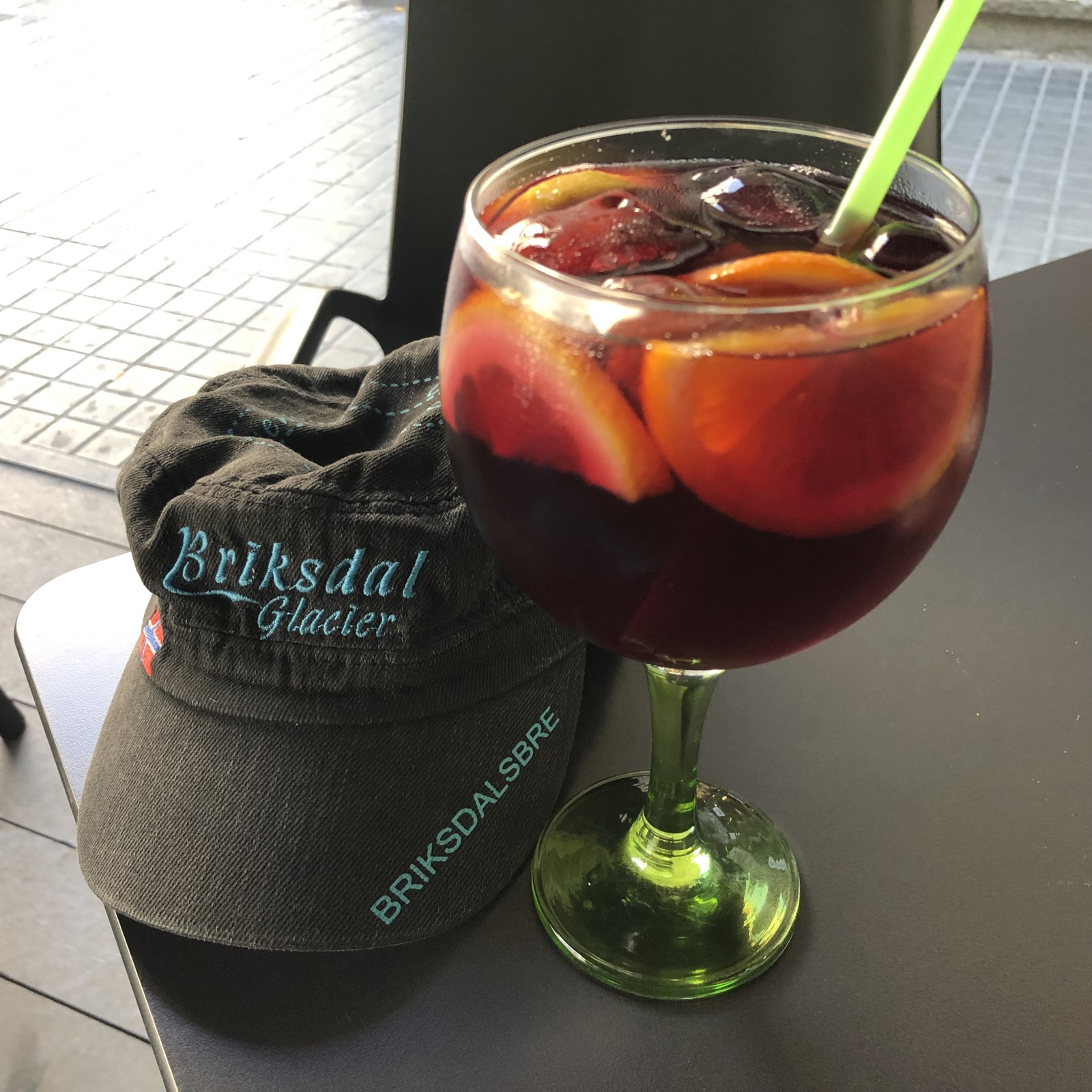
4420 The hat from Norway was not doing enough to make me feel cool in the heat. Fortunately the Sangria did the job.

3258 I heard this Sunday afternoon Hare Krishna procession from several blocks away.
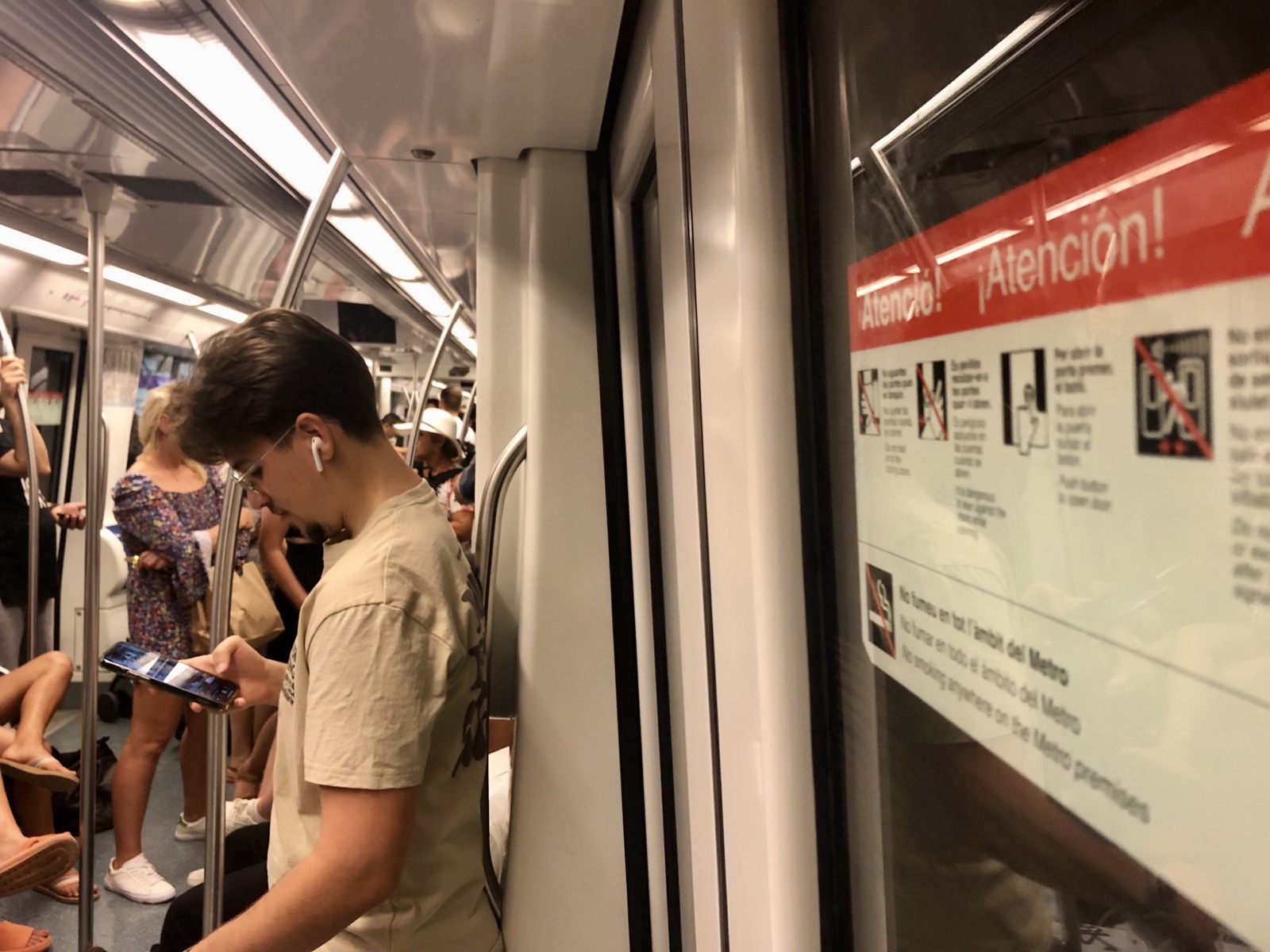
3428 Although I walked from my AirBnB to Sagrada Família as part of a walking tour on Thursday, I took a metro this time. Notice that the signs—like most I saw throughout the city—are in Catalan first, then Spanish, then English.
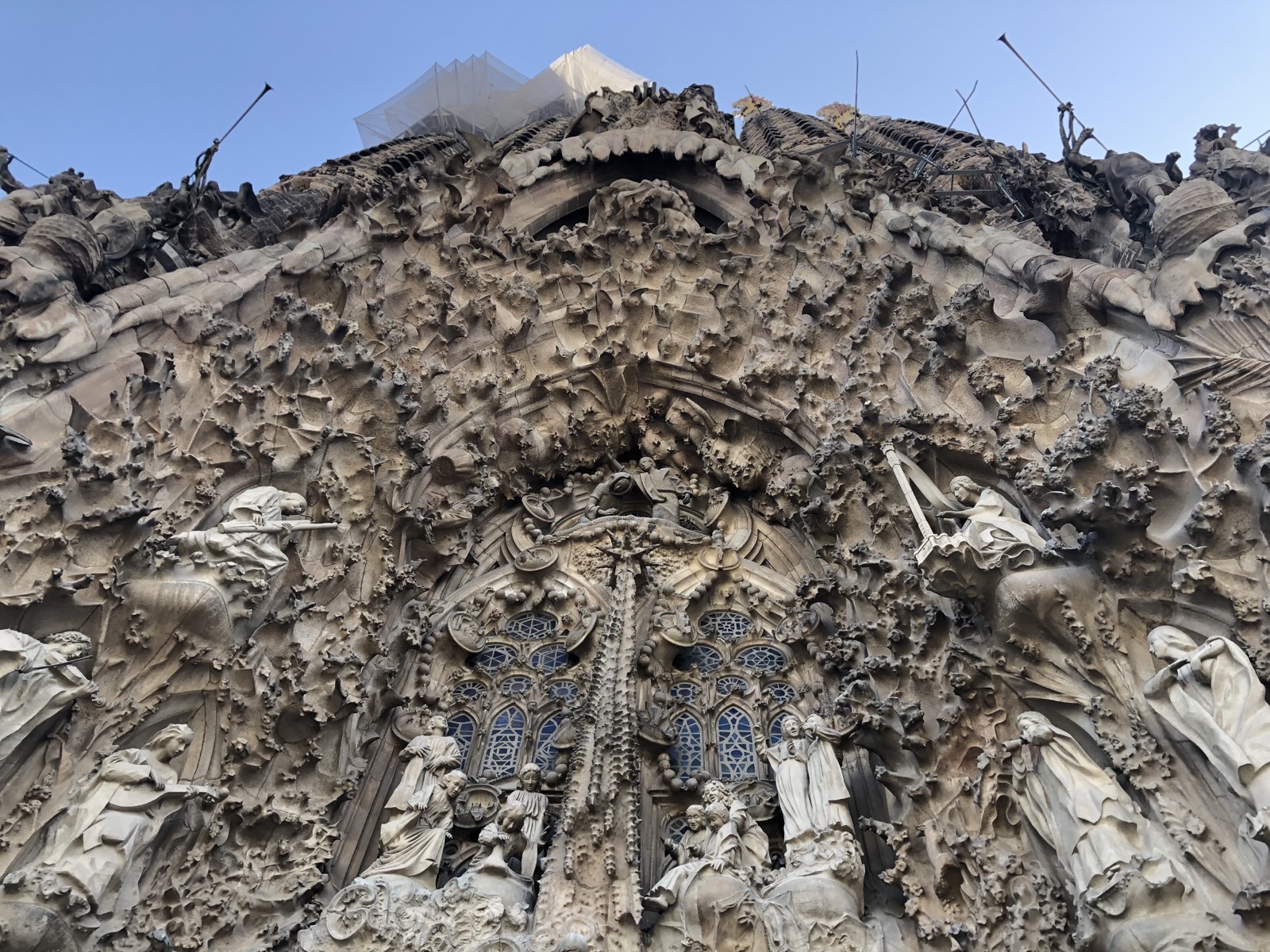
3431 A view of the Nativity Façade from directly below. On the top left is Joseph, and on the top right is Mary. Together with Jesus they form the titular “Sagrada Família”, or Holy Family.
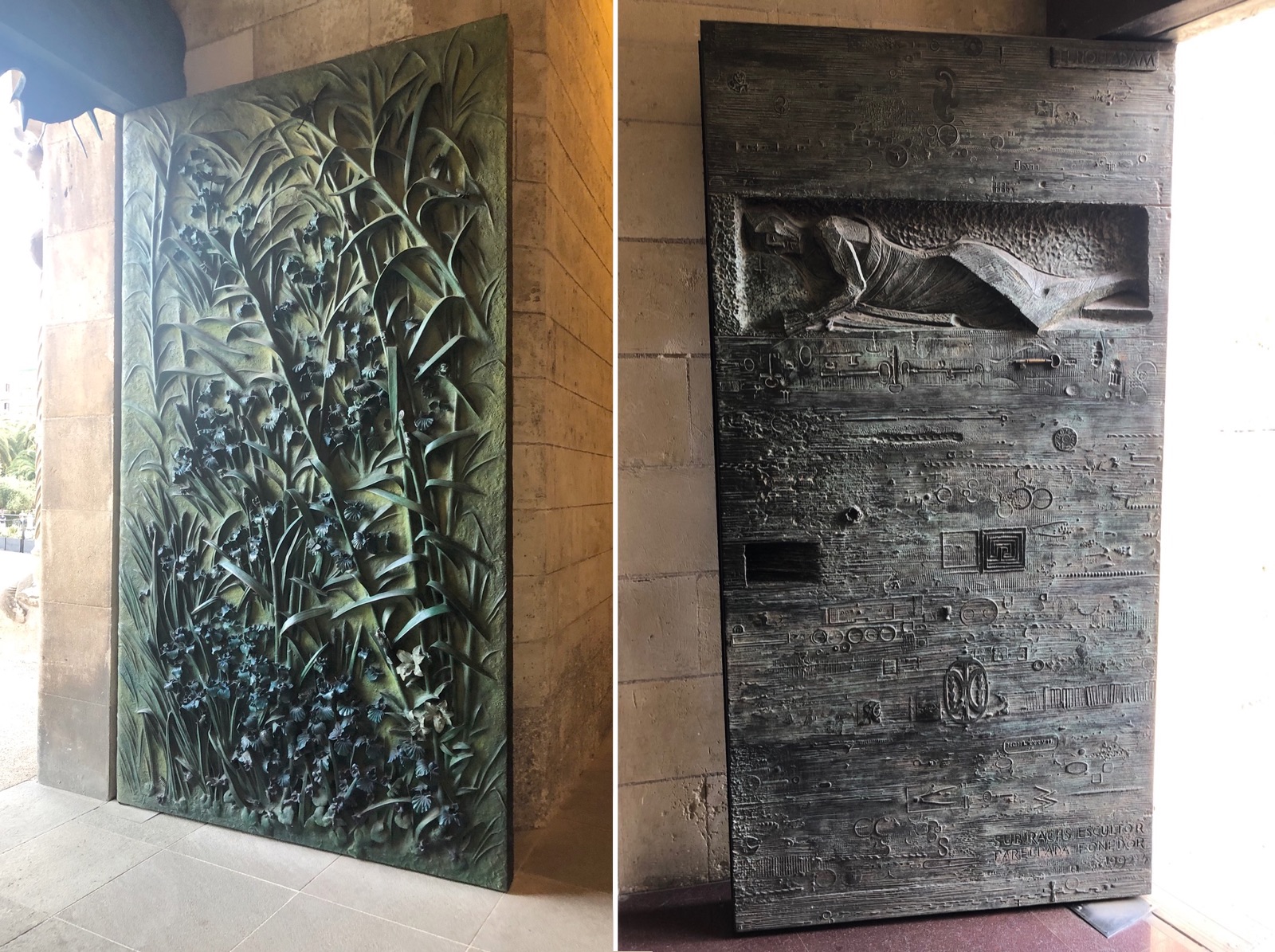
3499d Two doors from opposite sides of the building. As with the façades (Nativity and Passion, respectively), the entrance is associated with birth and life, while the exit is associated with death.

3434 Once inside Sagrada Família, you immediately see many of these enormous and colorful stained glass windows. These ones were designed by Joan Vila-Grau, following guidelines from Gaudí.
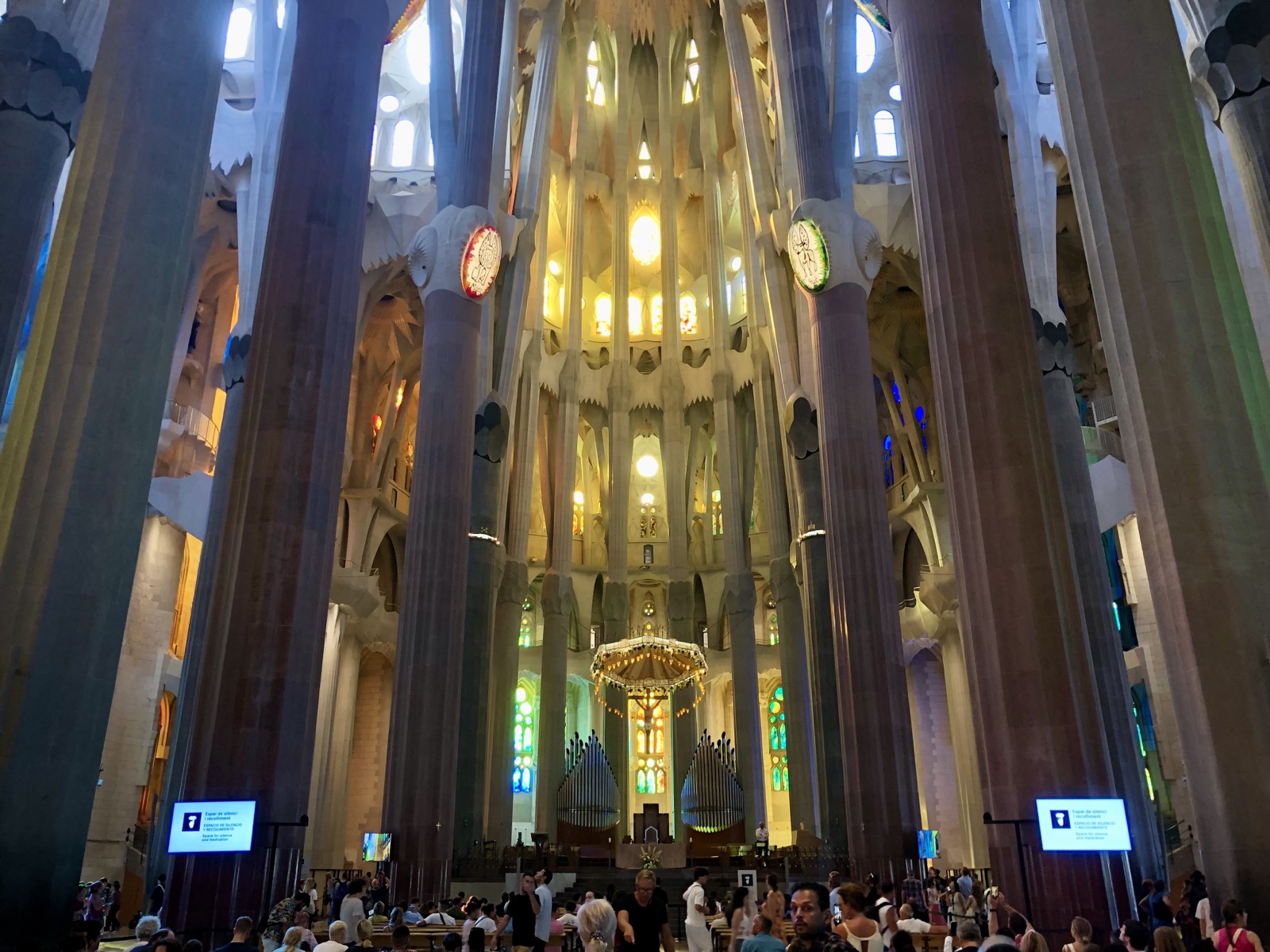
3441 Gaudí was frequently inspired by nature. The interior of Sagrada Família is meant to feel like a forest, with columns as the trees. In the background is the Glory Façade, focusing on Jesus’ life.
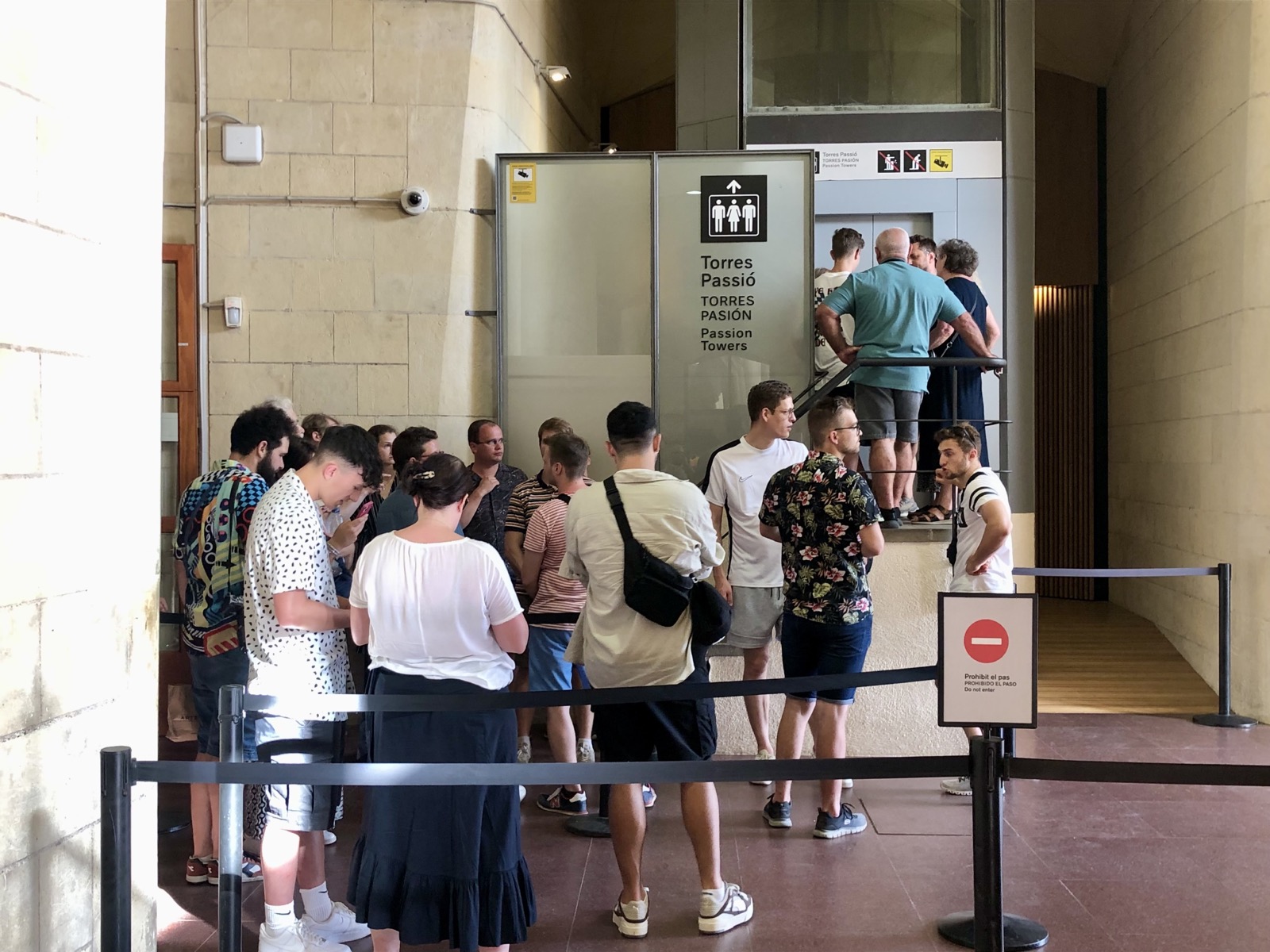
3445 On recommendation from a friend, I payed extra to be able to go up one of the towers. Part of the trip up is by elevator; more towers should do this!
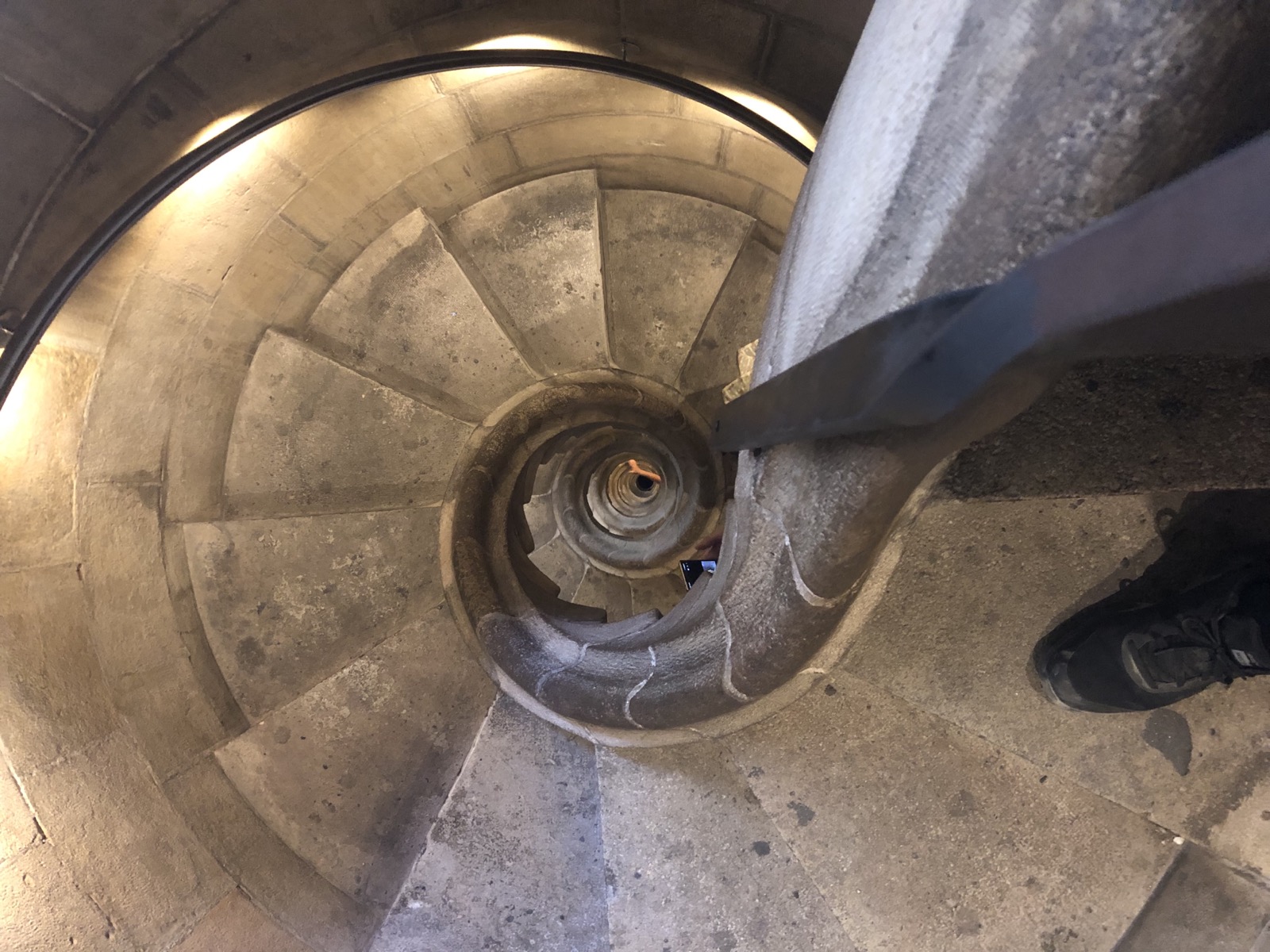
3488 Of course the higher parts of the towers are too narrow for elevators, so there are also stairs.
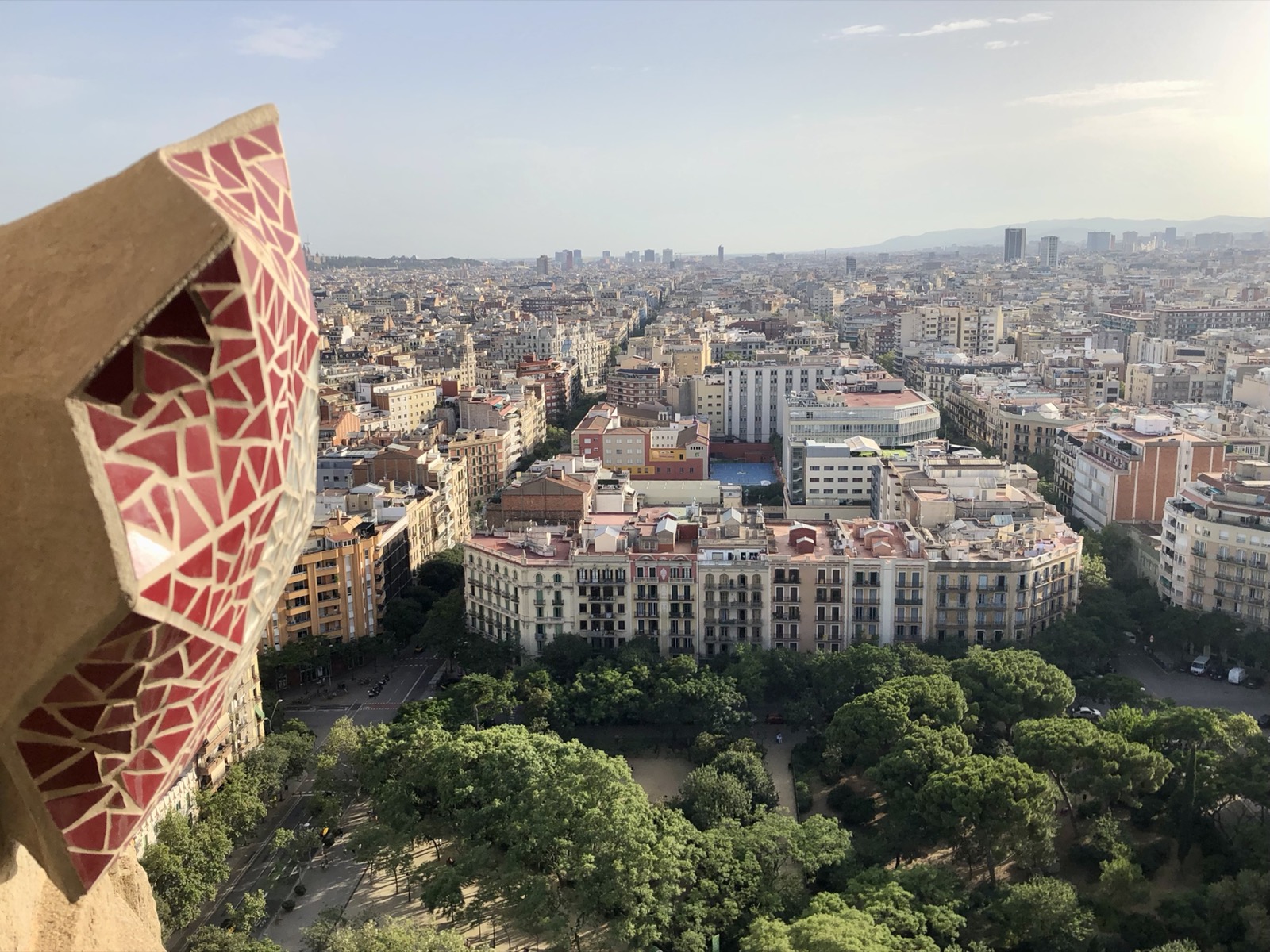
3467 A view from near the top of the Passion tower. By the way, this video has a nice explanation of Eixample’s unusual grid system.

3464 Another view from the tower. By the way, Sagrada Família’s highest point (not pictured) will be 172.5 meters when complete. This is just half a meter lower than the tallest nearby hill because Gaudí wanted to emphasize that G-d’s creation (that is, nature) is always more important than man-made creations.

3479 The trip down the tower was entirely by stairs, not elevator.
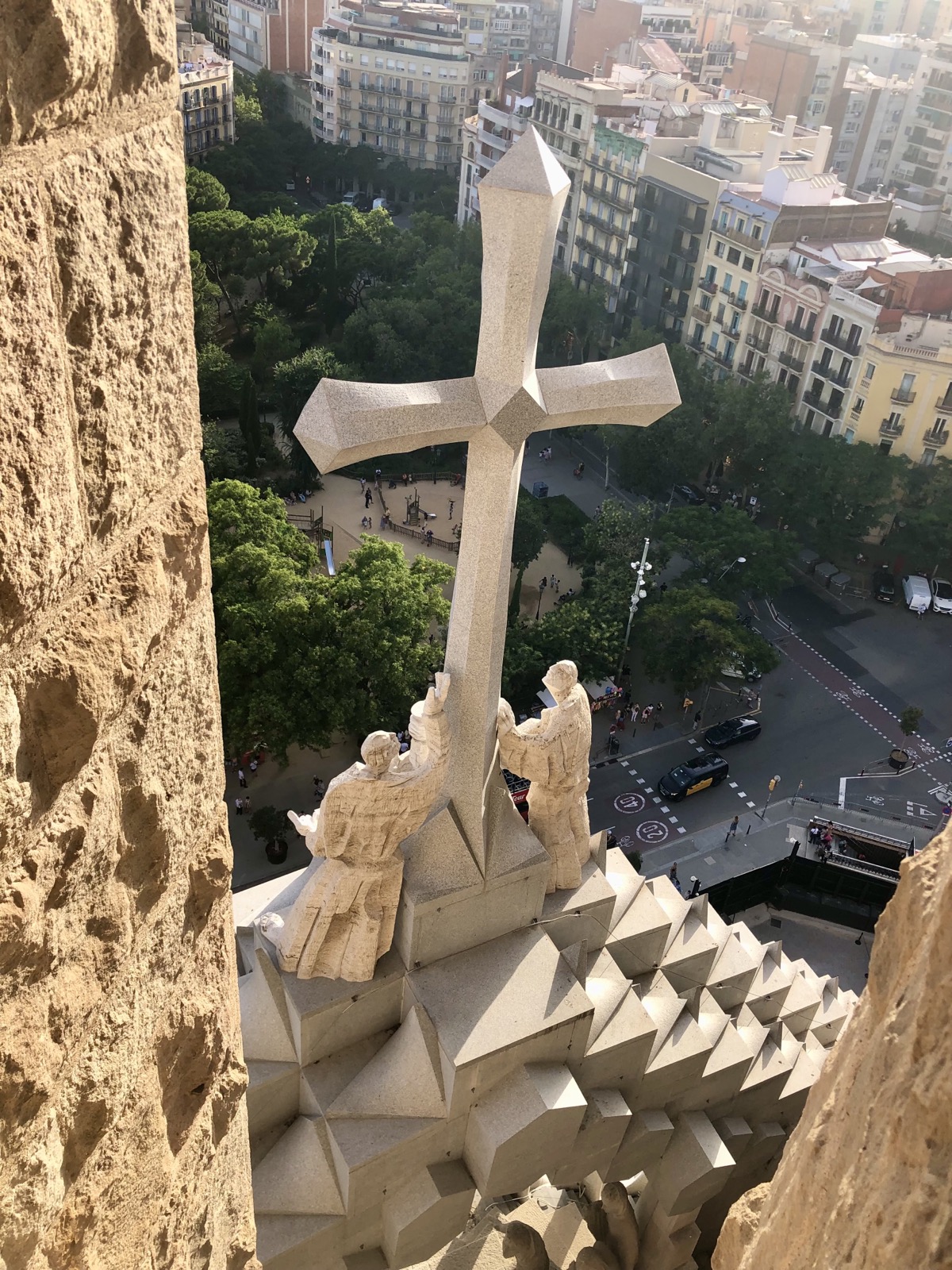
3484 Partway down I had a great view of the back of the pediment with the cross. The front can be seen in my photo from Thursday.

3450 Back on the main floor, there is small exhibit of wooden furniture also designed by Gaudí. Some of these pieces were damaged in 1936, at the start of the Spanish Civil War, and have been restored.
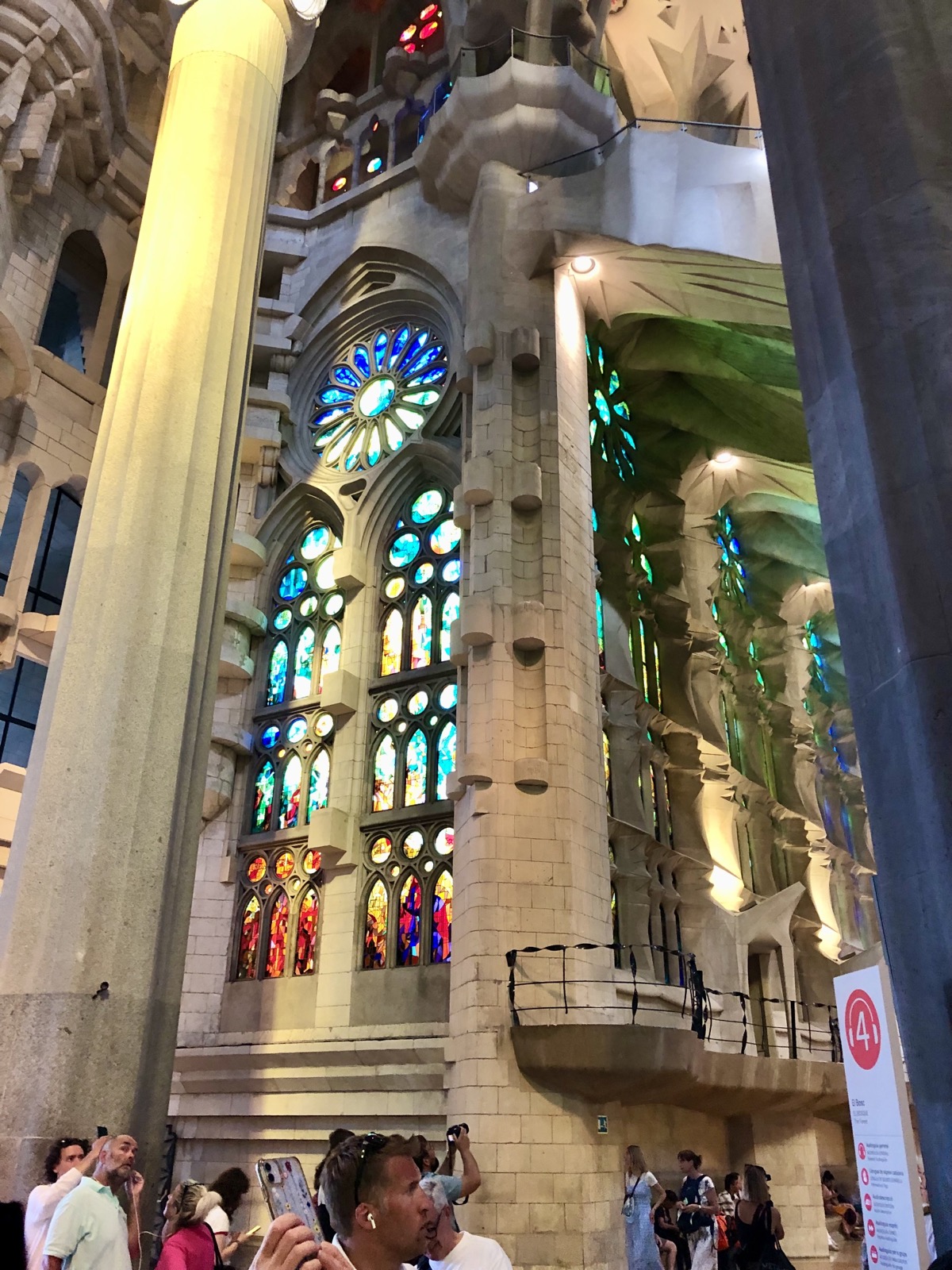
3432 The design of the black railings are meant to resemble a musical staff and notes, although they do not encode any particular song.
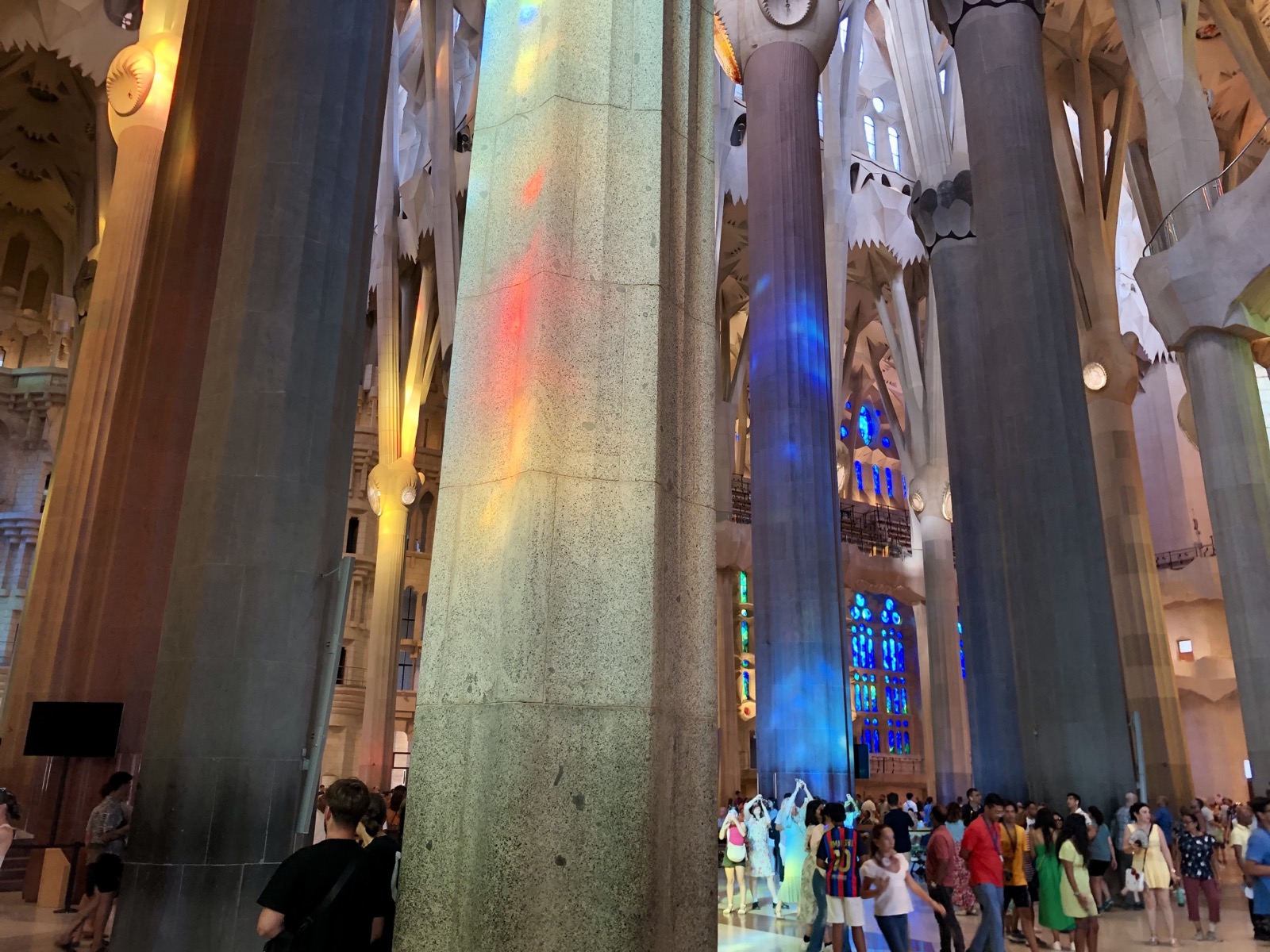
3452 Seriously, this place is beautiful. I have never felt the phrase English phrase “bathed in light” more-so than right here.
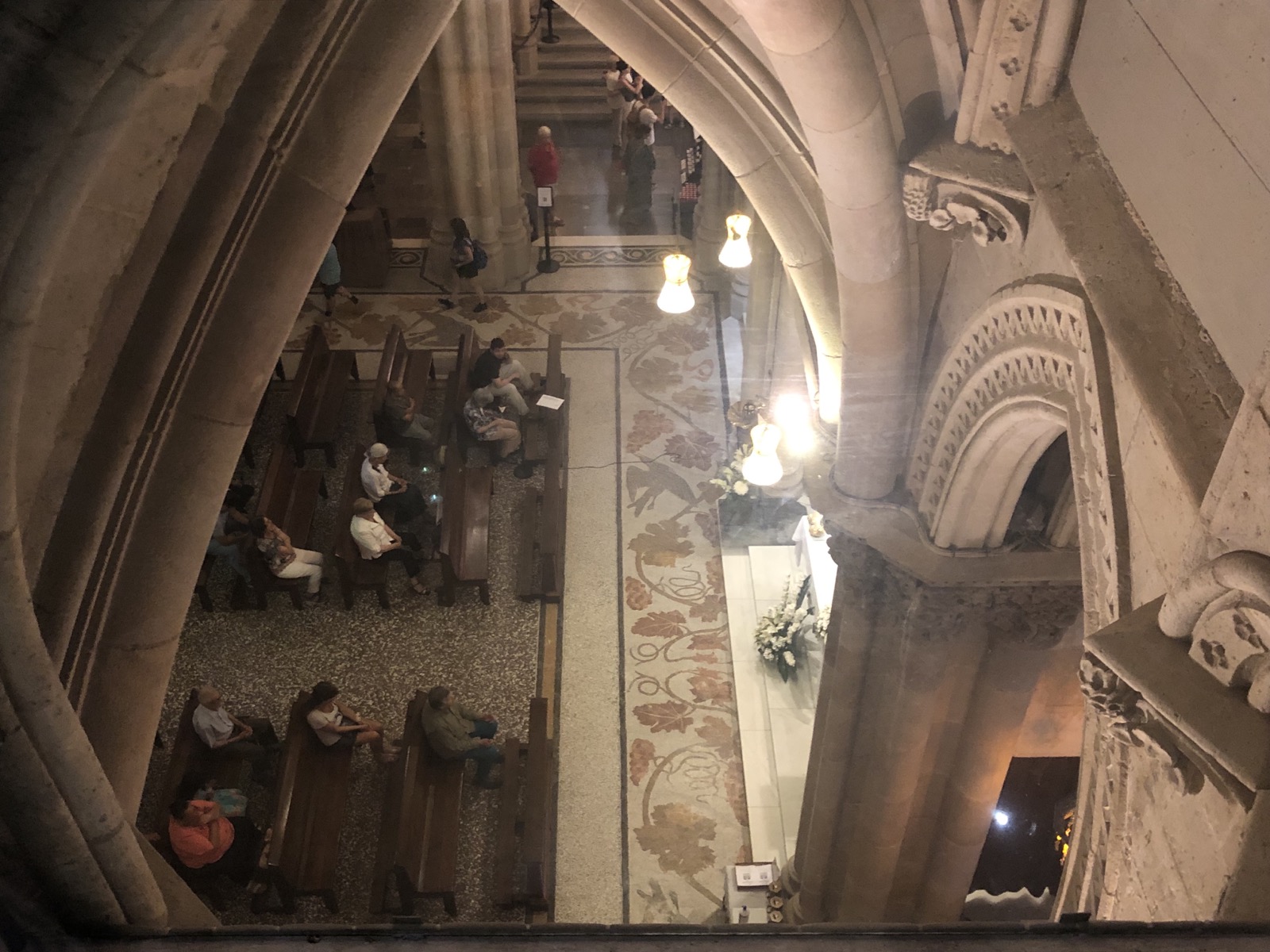
3492 Parts of the church are reserved for those who are actually in prayer.
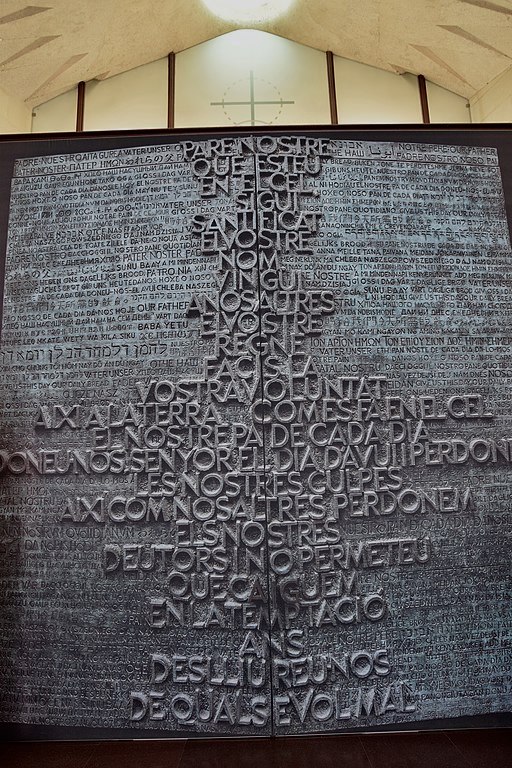
3500d These central text is the Lord’s Prayer written in Catalan. The rest is the phrase “Give us this day our daily bread” in 50 different languages.
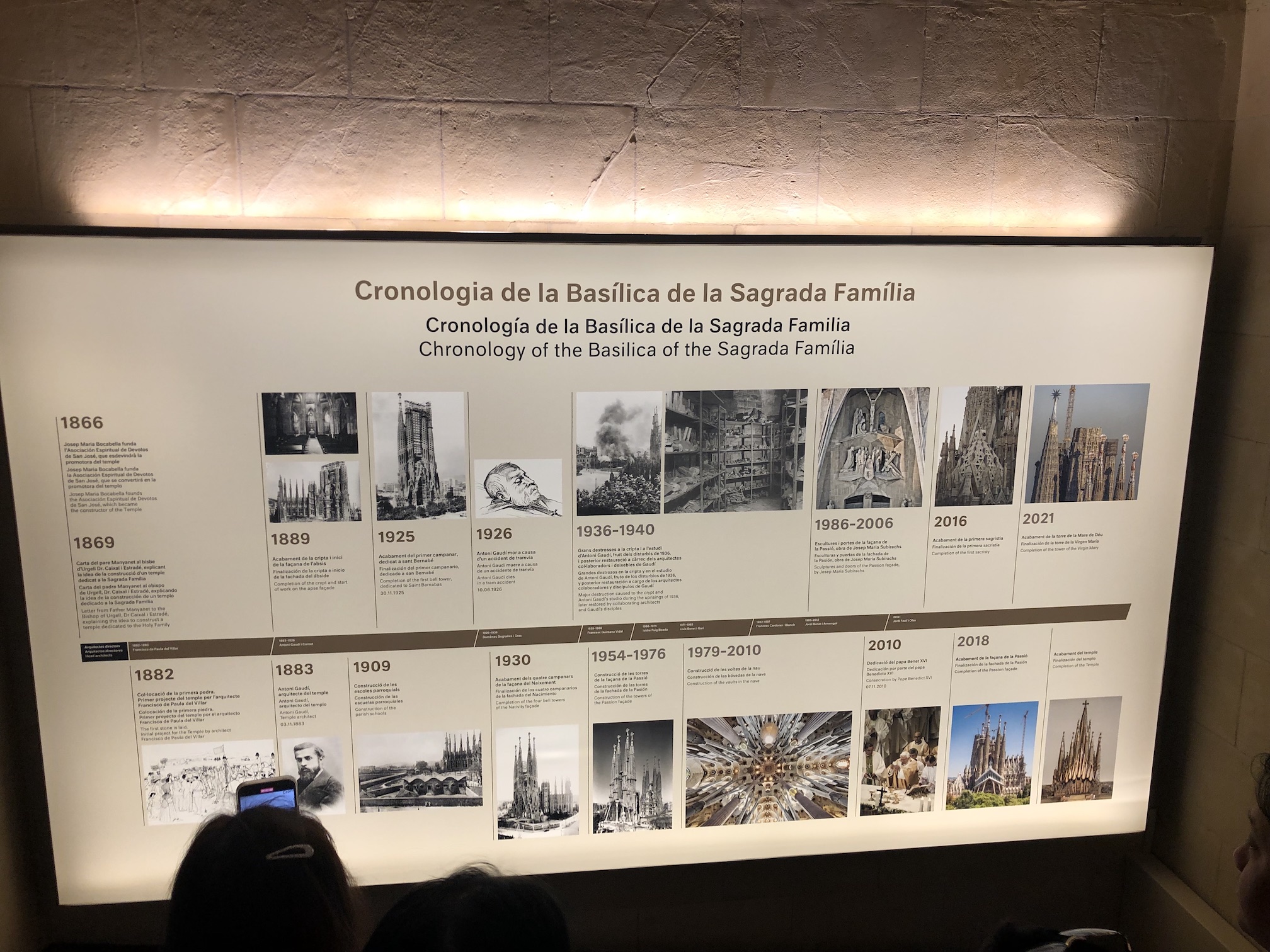
3496 There is a small museum in the basement. When construction began in 1882, the lead architect of Sagrada Família was Francisco de Paula del Villar. He left after just one year, and Antoni Gaudí took over.
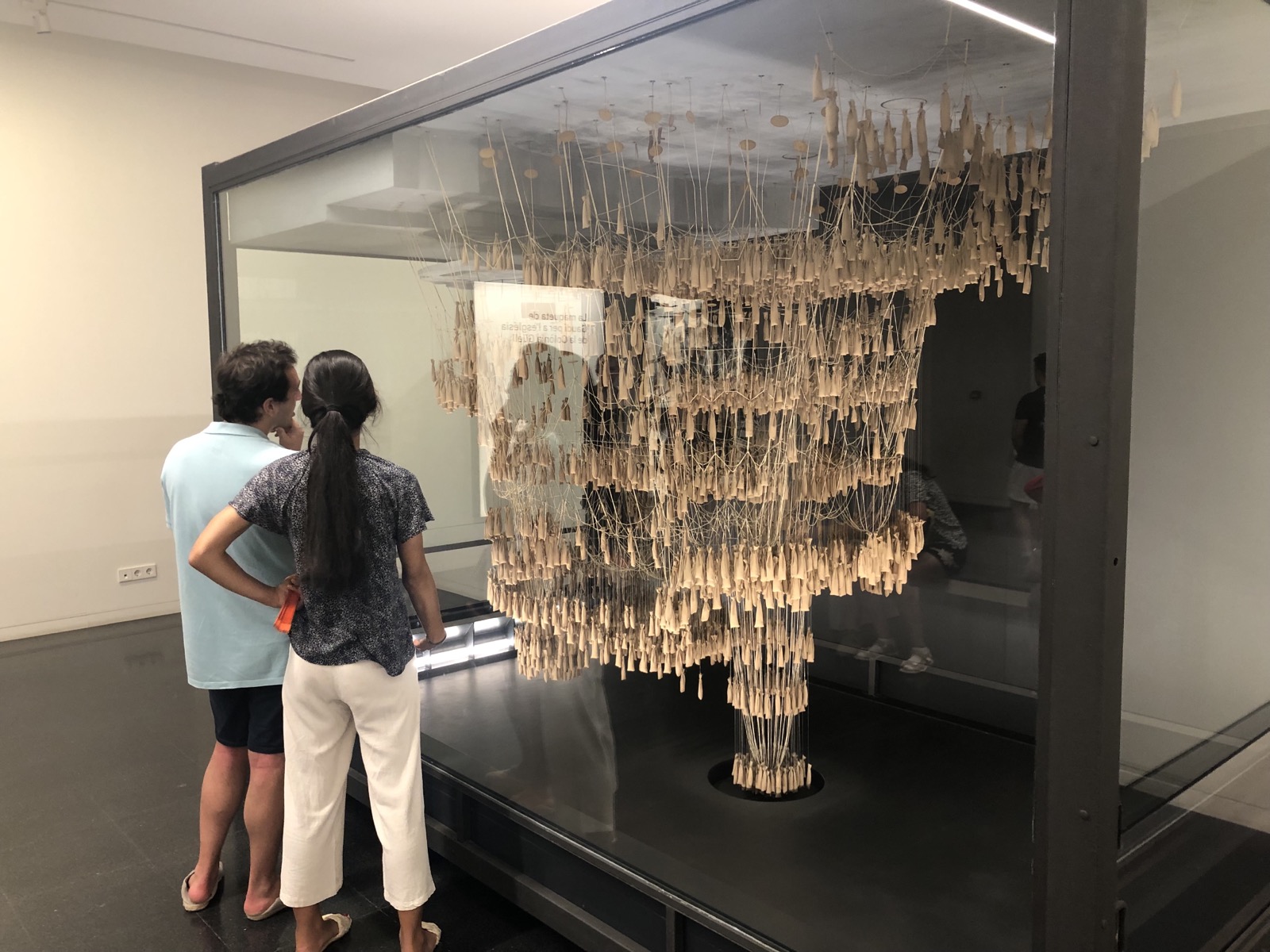
3503 This inverted weight system was used to understand the physical stresses involved in the building. Such structures had been used by architects before, but never for such a large project.
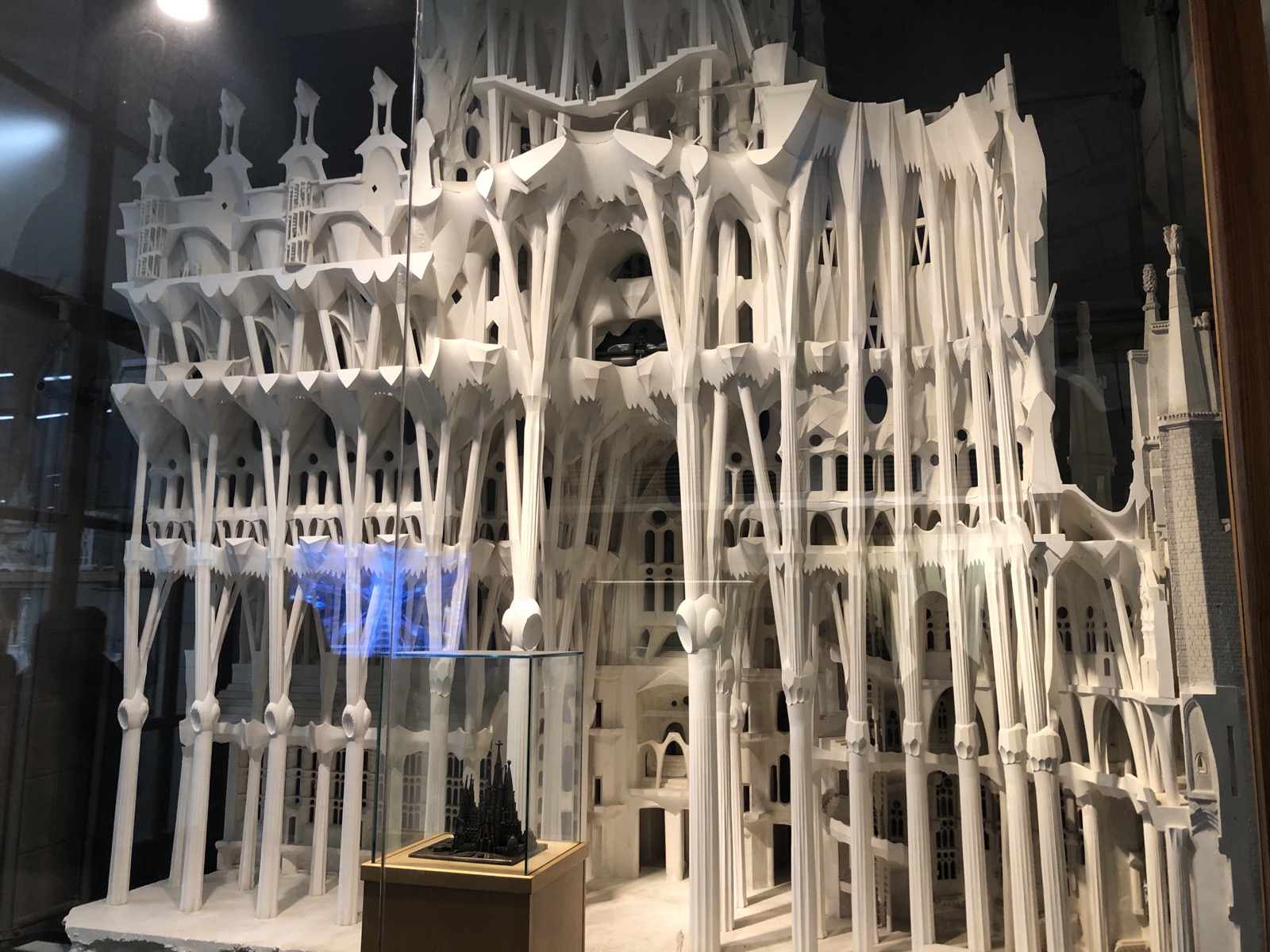
3504 Gaudí knew the project would not be finished before his death, so he made several models and sketches for future architects to use. In the early 2000s there was hope that Sagrada Família would be finished by 2026, the 100th anniverary of Gaudí’s death, but it’s now clear that it will not be.

3511 You might not have noticed the magic square in the Passion Façade on Thursday, but I certainly did at the time. Here is a poster from the gift shop showing various rows, columns, and other portions that each add to 33, the supposed age of Jesus at his crucifiction (the layout of this square is a modification of one from painter Albrecht Dürer, in which the sum was 34 and there were no repeated numbers).
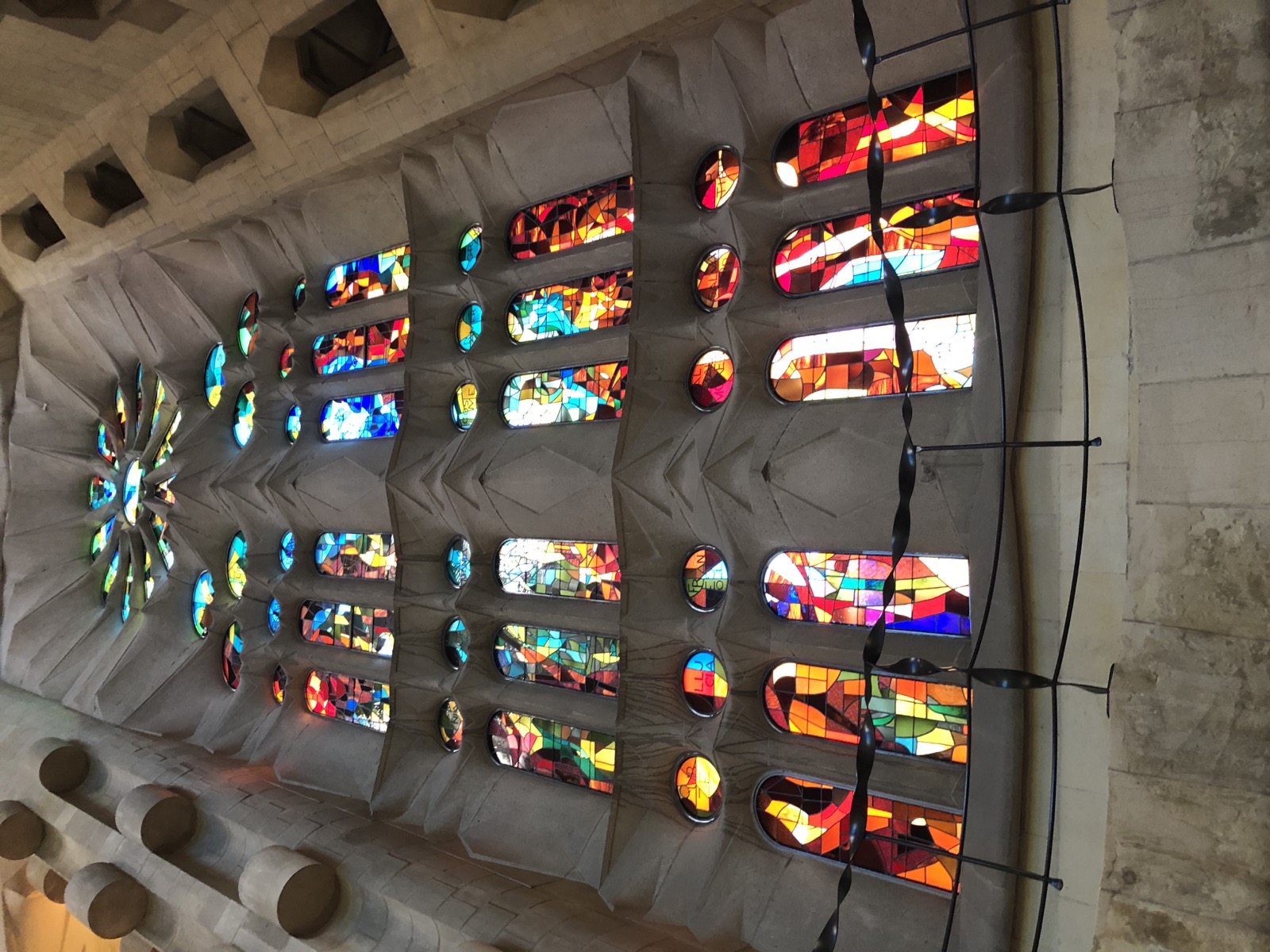
3456 One more window photo for good measure! By the way, you can see this pattern—the six columns with the large circle at the top—from outside in photos like this one, but you have to look for it. For me at least, the hundreds of statues on the exterior make the windows much less noticeable.
Monday, 17 July 2023

3537 I was not originally planning to tour the inside of Casa Battlo, but after seeing some other Gaudí projects I decided it would be worth it to see one more while I was in town.

3538 I bought a ticket online on Sunday. Even so there was a bit of a line.
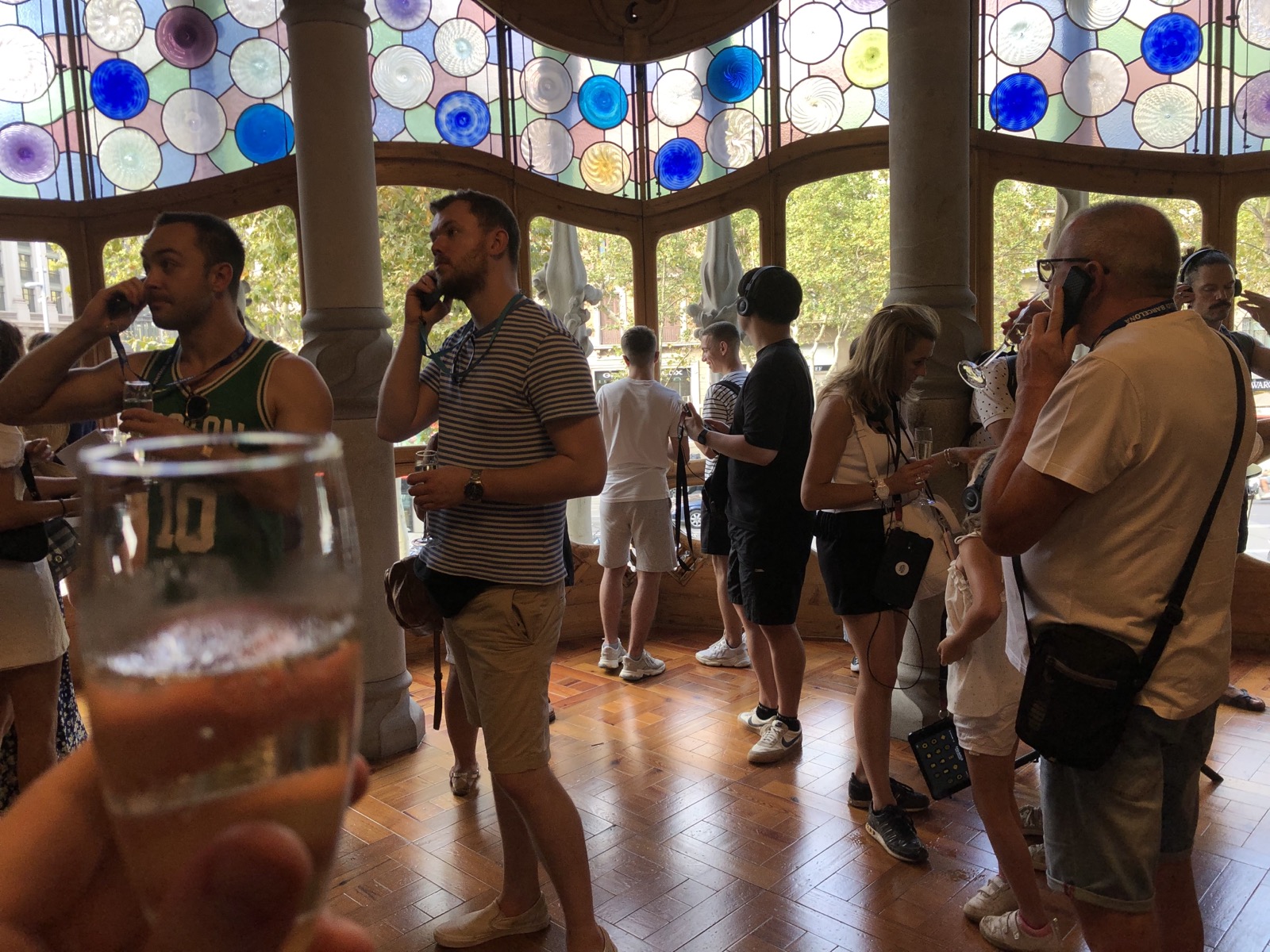
3549 Depending on the time of your entry, some Casa Battlo tickets include a free drink of cava, a Spanish sparkling wine.

3559 The patio/garden/courtyard at Casa Battlo is curved, like the Palau Güell roof. It also has several small skylights, one of which you can see at the bottom left.
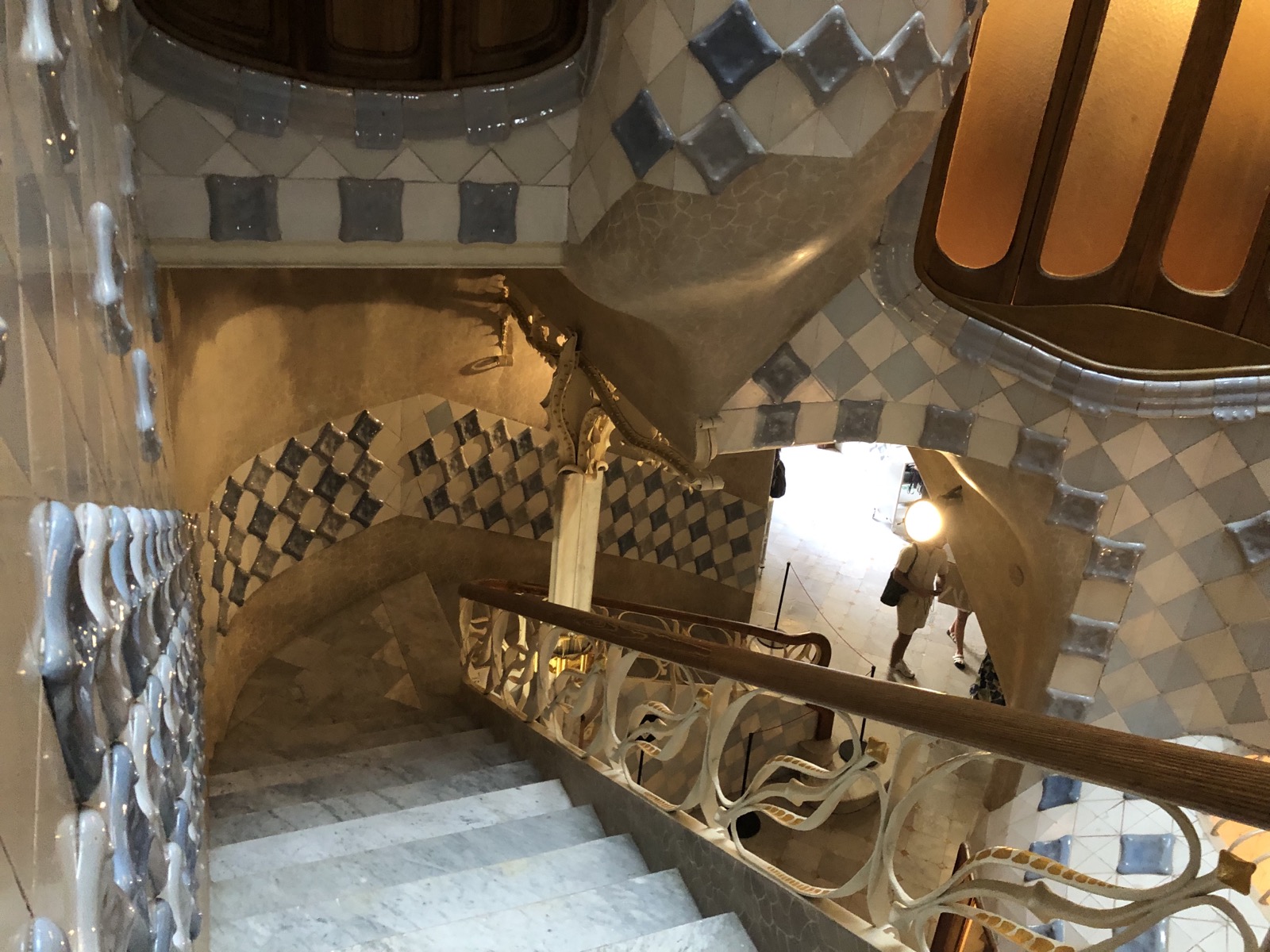
3563 The main staircase. The tiles are light blue at the bottom and darker blue higher up.
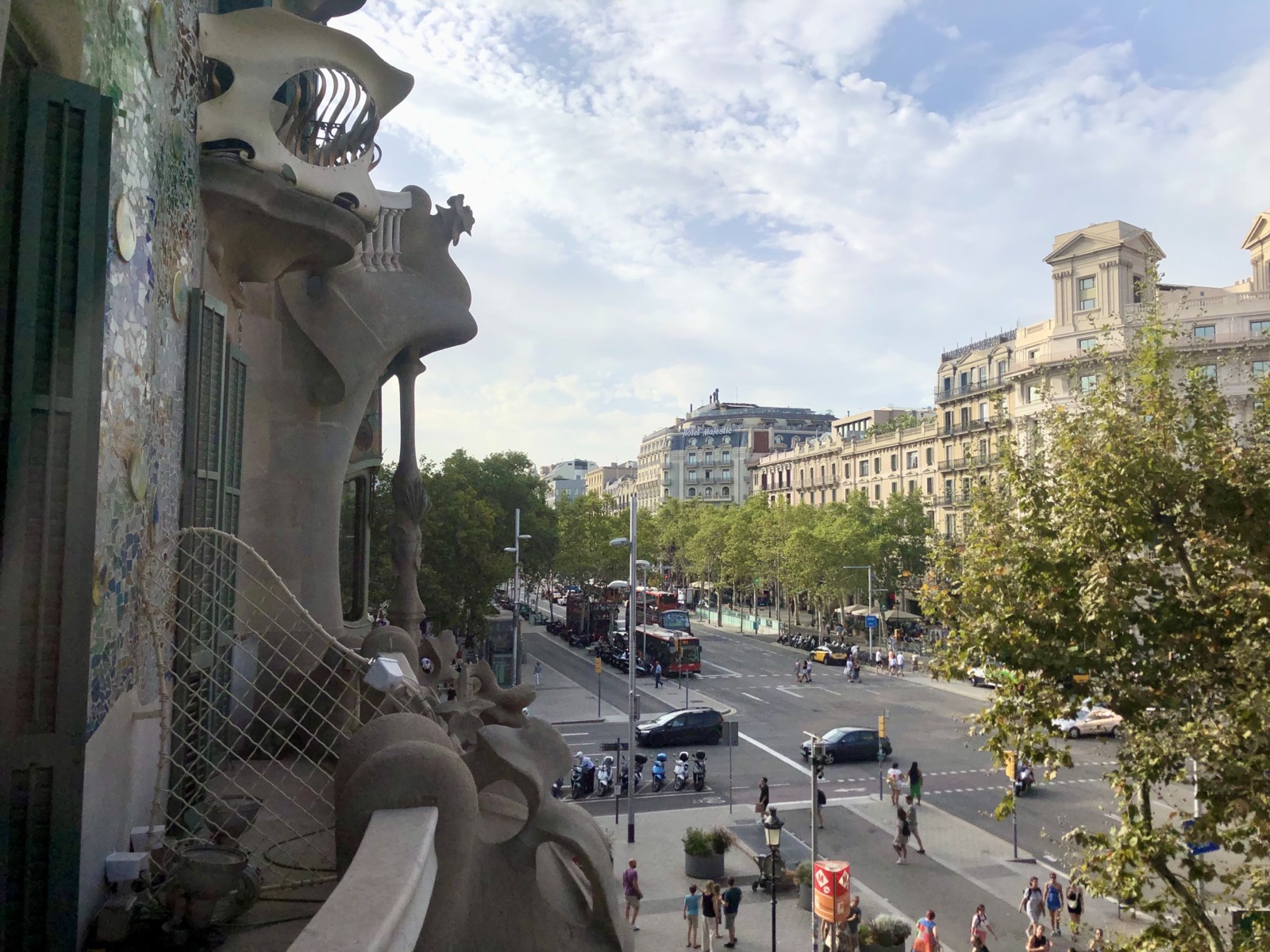
3568 Visitors cannot stand on these balconies, but I was able to poke my phone out to get a different perspective of the famous façade.
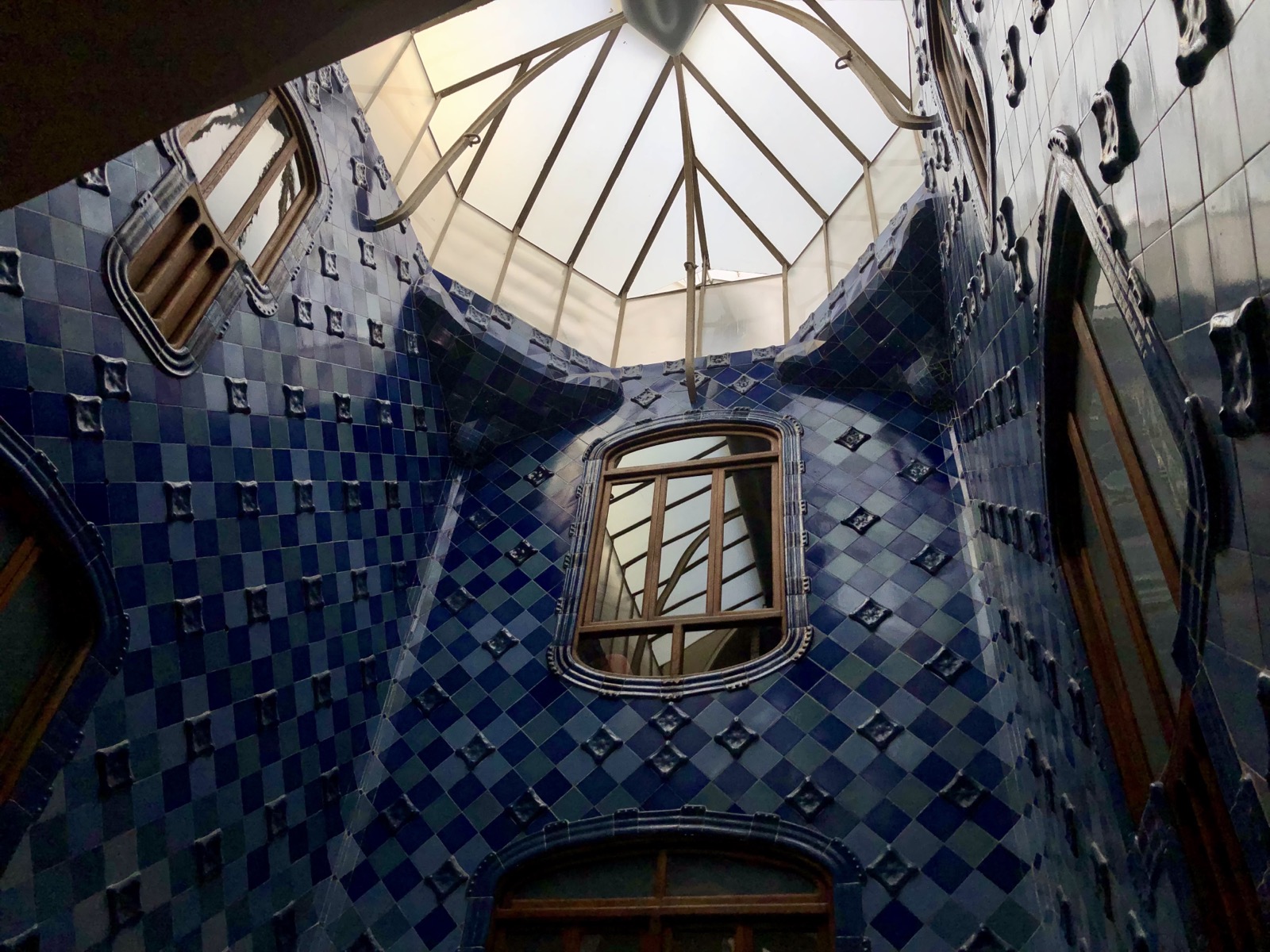
3571 The staircase is lit from above by a really large skylight.
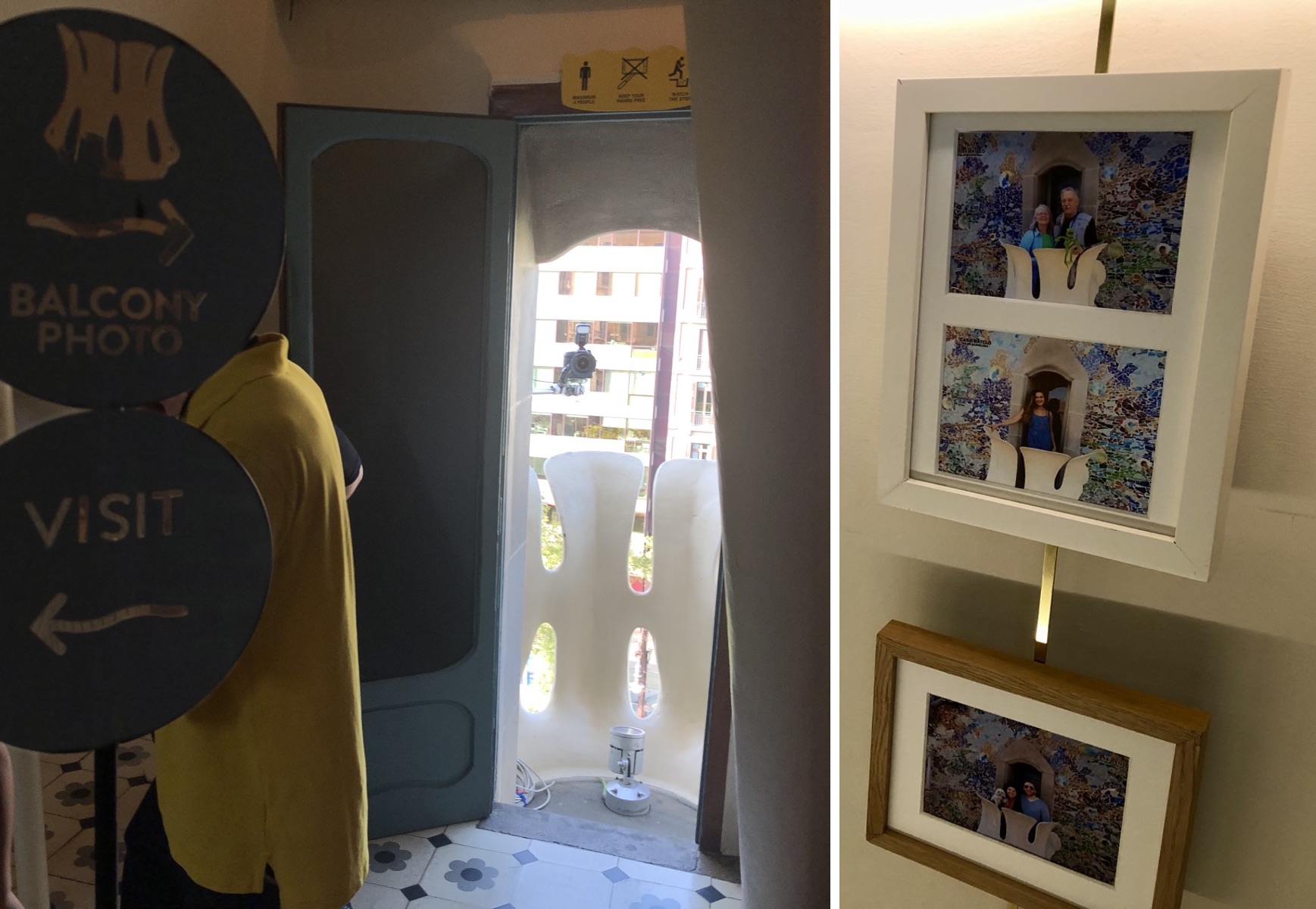
3586b There is one balcony that is accessible to visitors, where a mounted camera will take a photo of your group for a price. Didn’t seem worth it to me, but they are admittedly pretty cool photos.
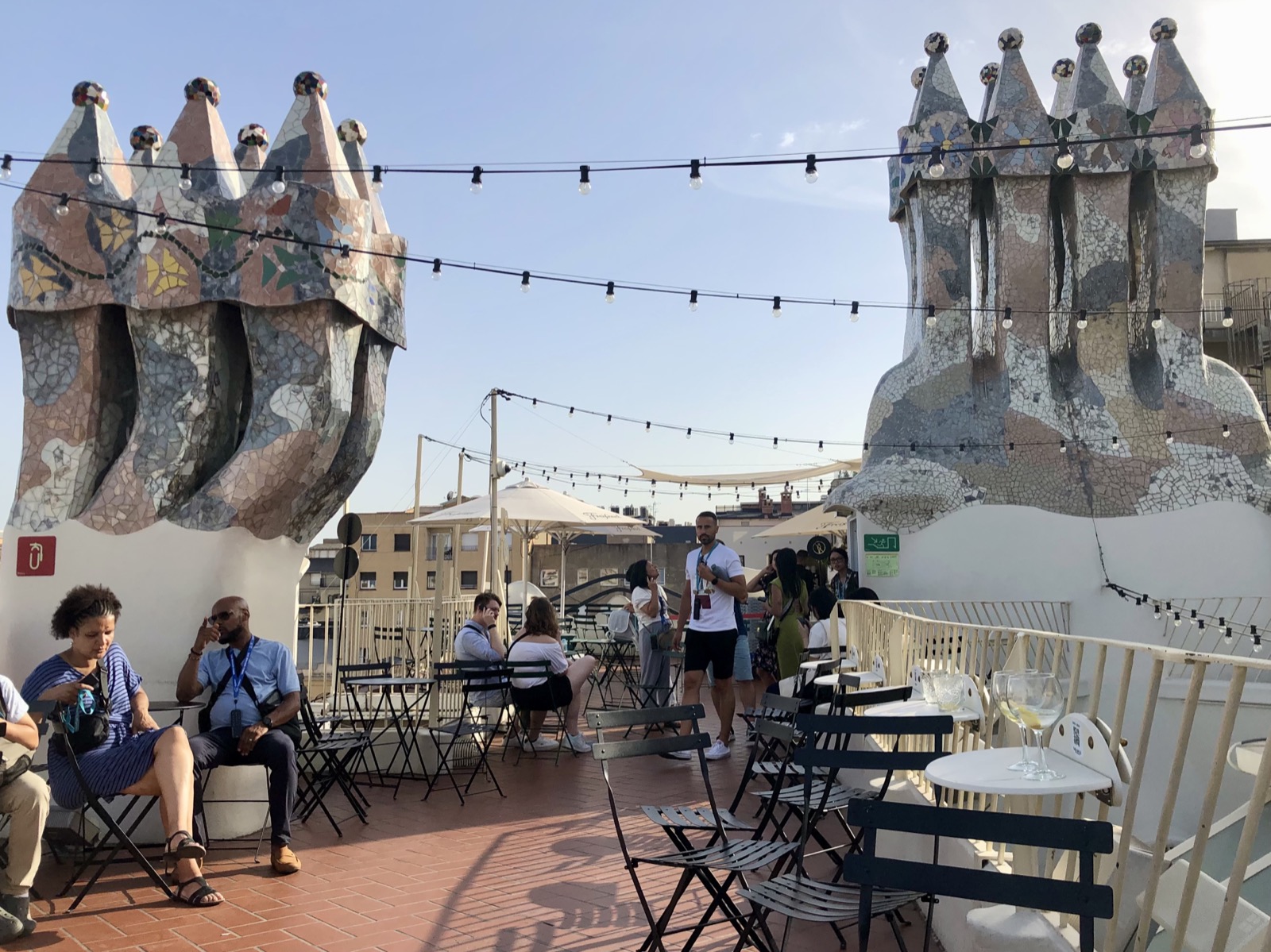
3575 While the roof of Casa Battlo is not nearly as curved as Palau Güell’s, it does share an abundance of decorated chimneys.
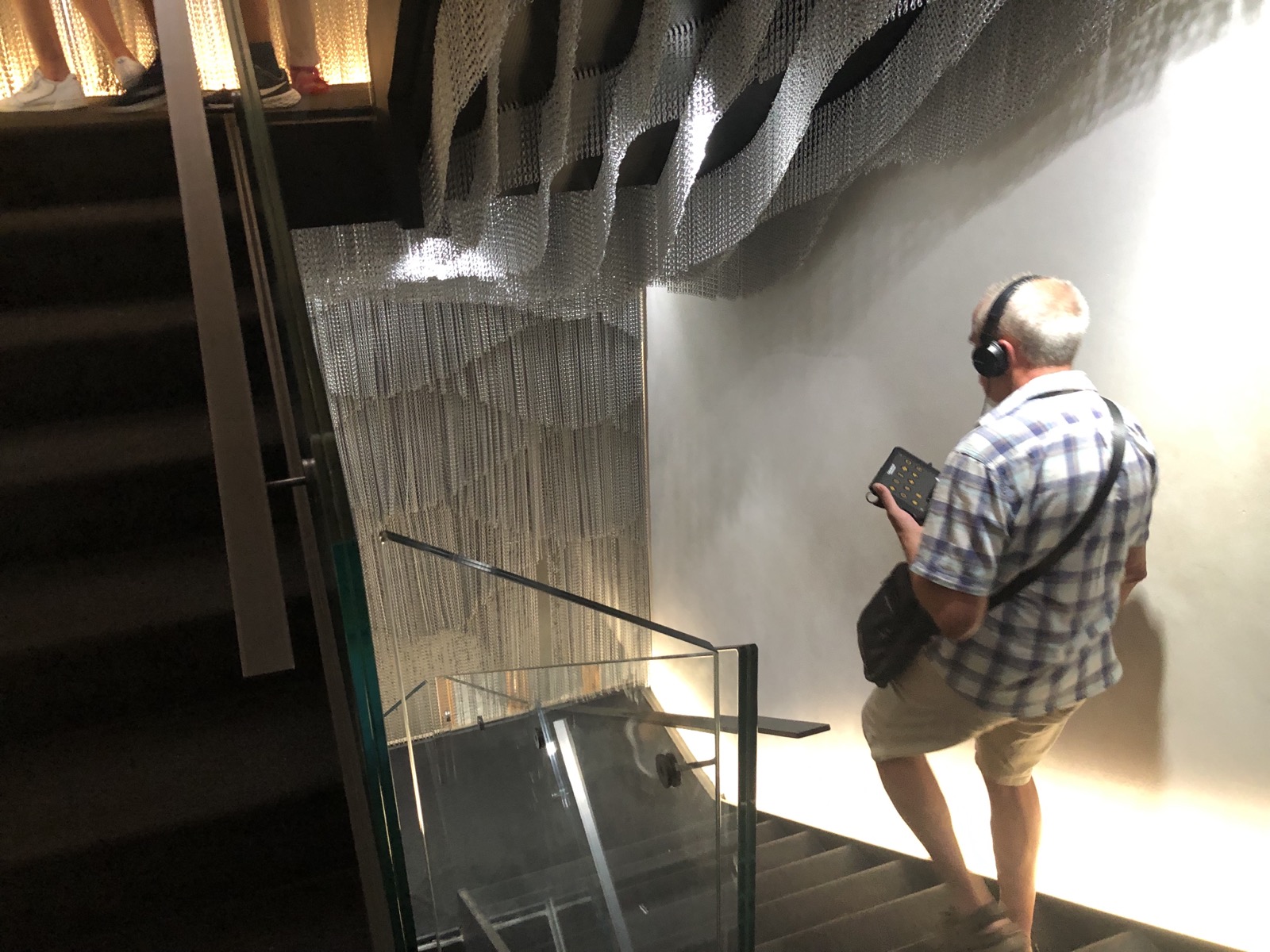
3592 These stairs, leading from the roof down to the exit today, are not designed by Gaudí but rather by a current Japanese artist.
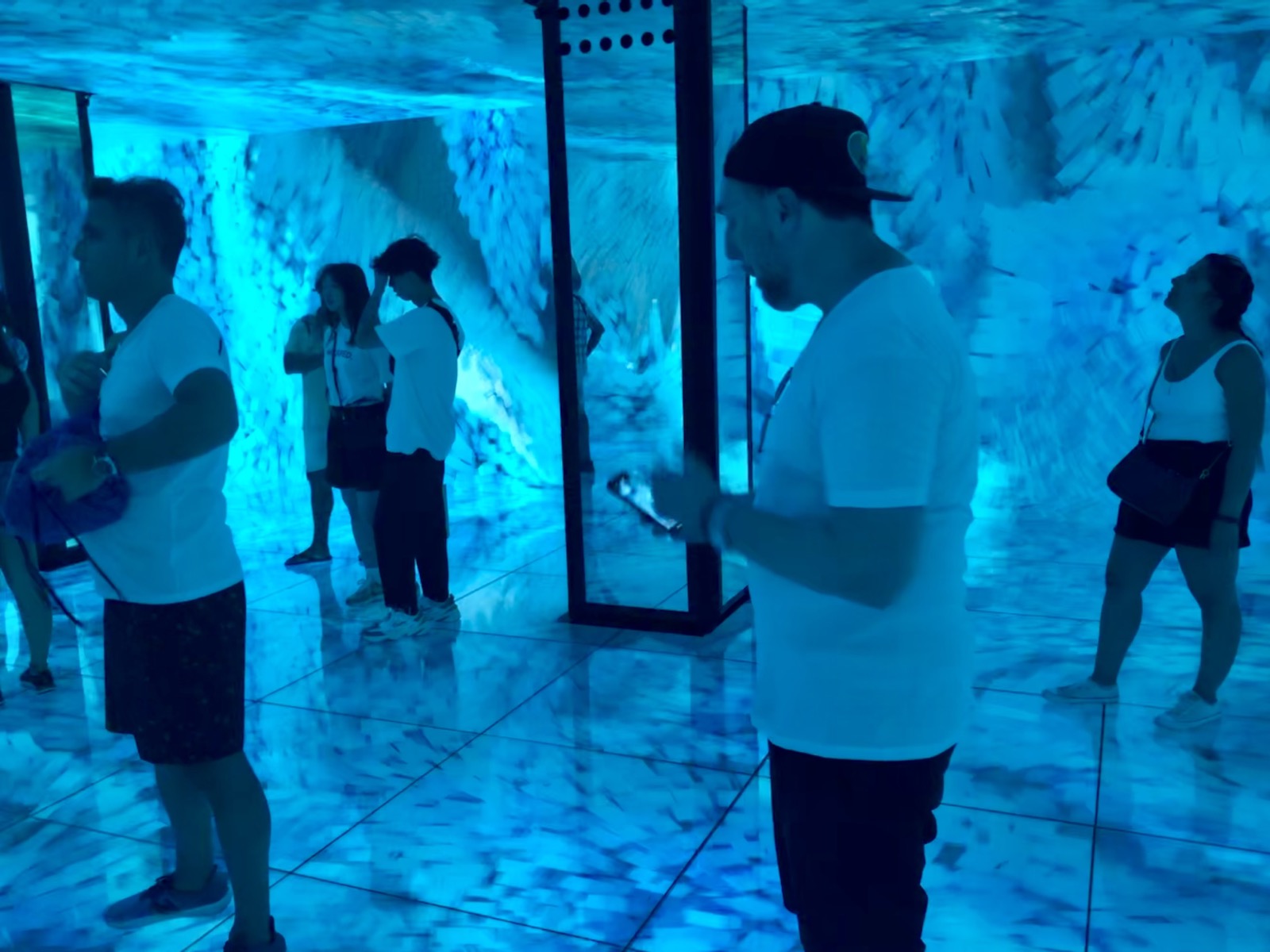
3621 The final part of Casa Battlo is the “Gaudí Cube”, an immersive multimedia room showing imagery from various Gaudí projects.
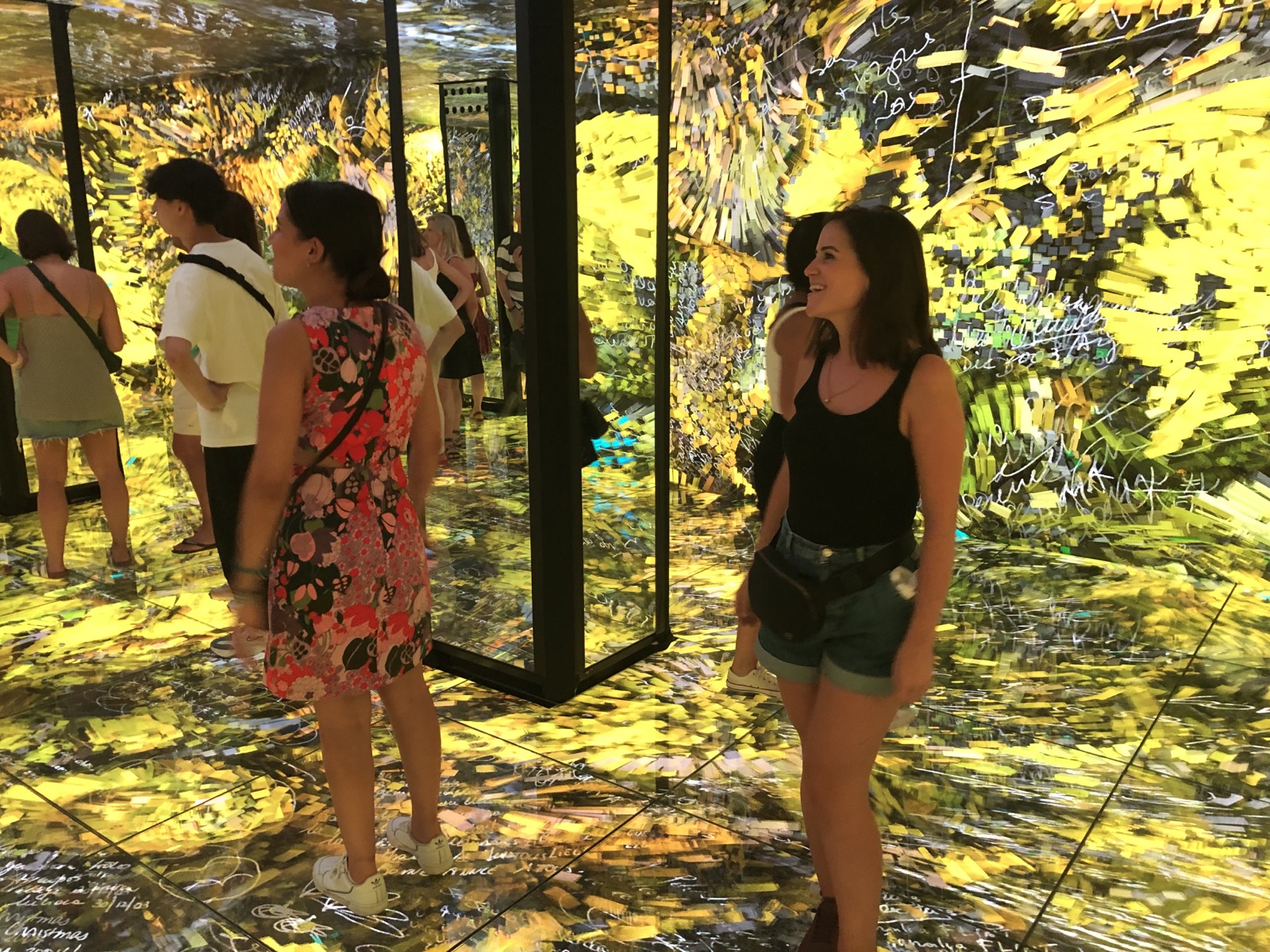
3626 While I wouldn’t visit the Gaudí Cube by itself, its inclusion in the museum is nice, in my opinion.
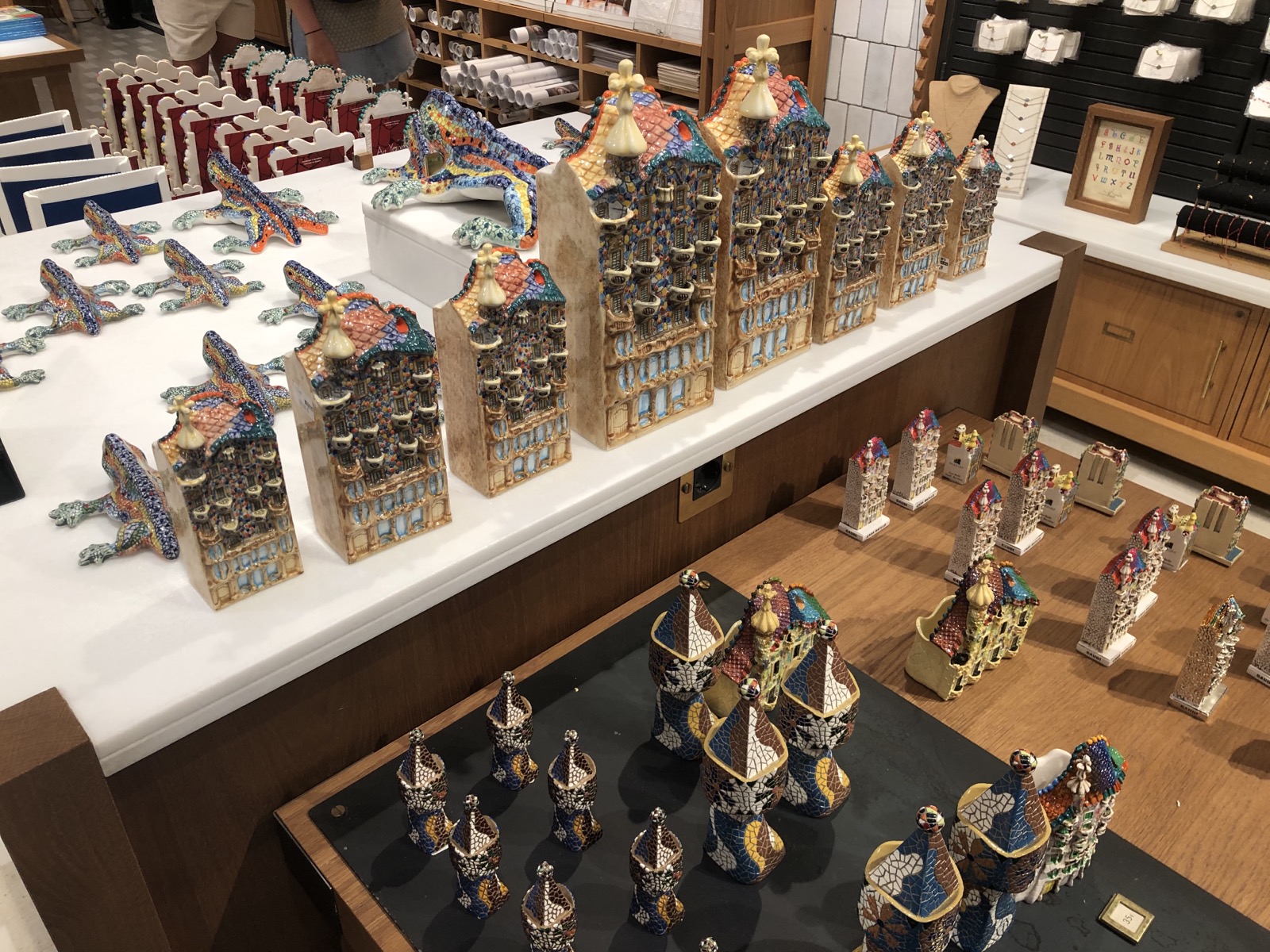
3631 The Casa Battlo gift shop has models of the house, some specific chimneys, as well as other Gaudí pieces such as El Drac.

3635 Sidecar tours are an interesting idea. These ones were stopped right outside Casa Battlo.
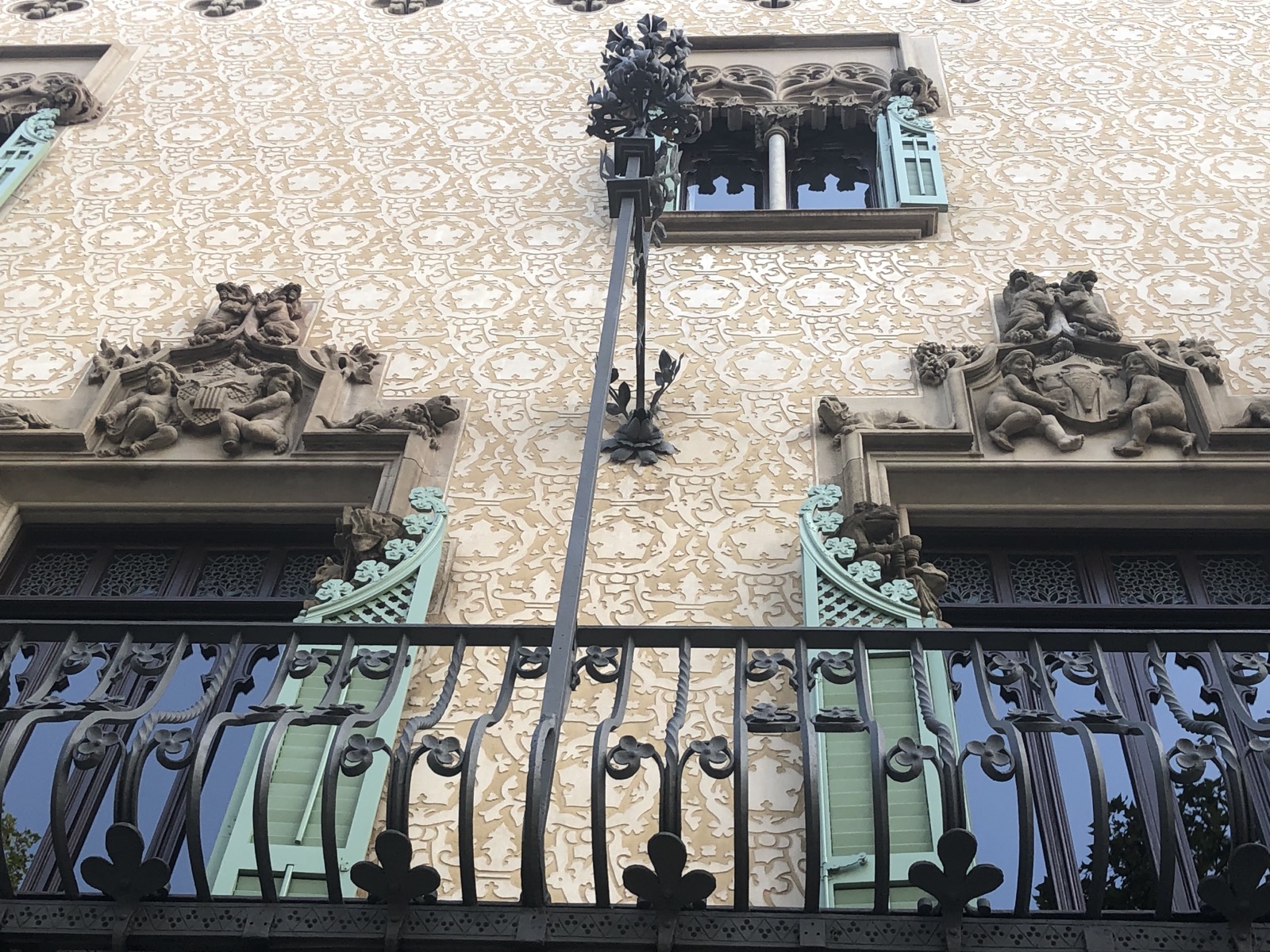
3536 Casa Amatller is immediately next to Battlo. Architect Josep Puig i Cadafalch has a very different style than Gaudí, but it’s also quite beautiful.

3331 Antoni Amatller was owned a chocolate company, and the non-ticketed part of the ground floor of Casa Amatller includes a chocolate shop.

3527 I returned to beach one last time before my vacation was over. It is noticeably less crowded on Monday. (Compare to this photo from Saturday, which has the same semicircular building in the background).

3336 Some miscellaneous Barcelona photos to round out this album.... Here is another view of Pl. Catalunya, which was near my AirBnB.
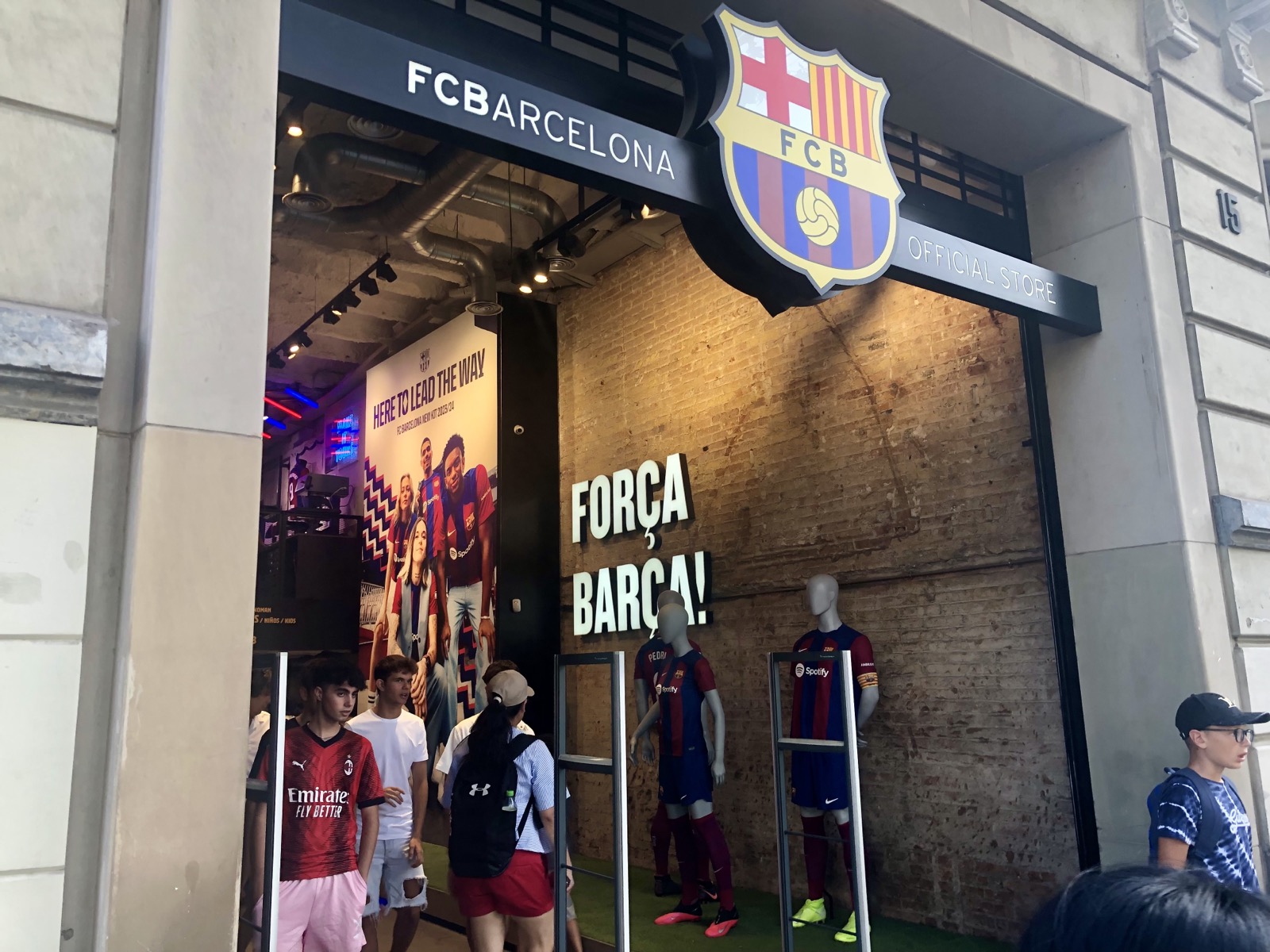
3534 Football, and in particular the home team FC Barcelona, is very popular here.
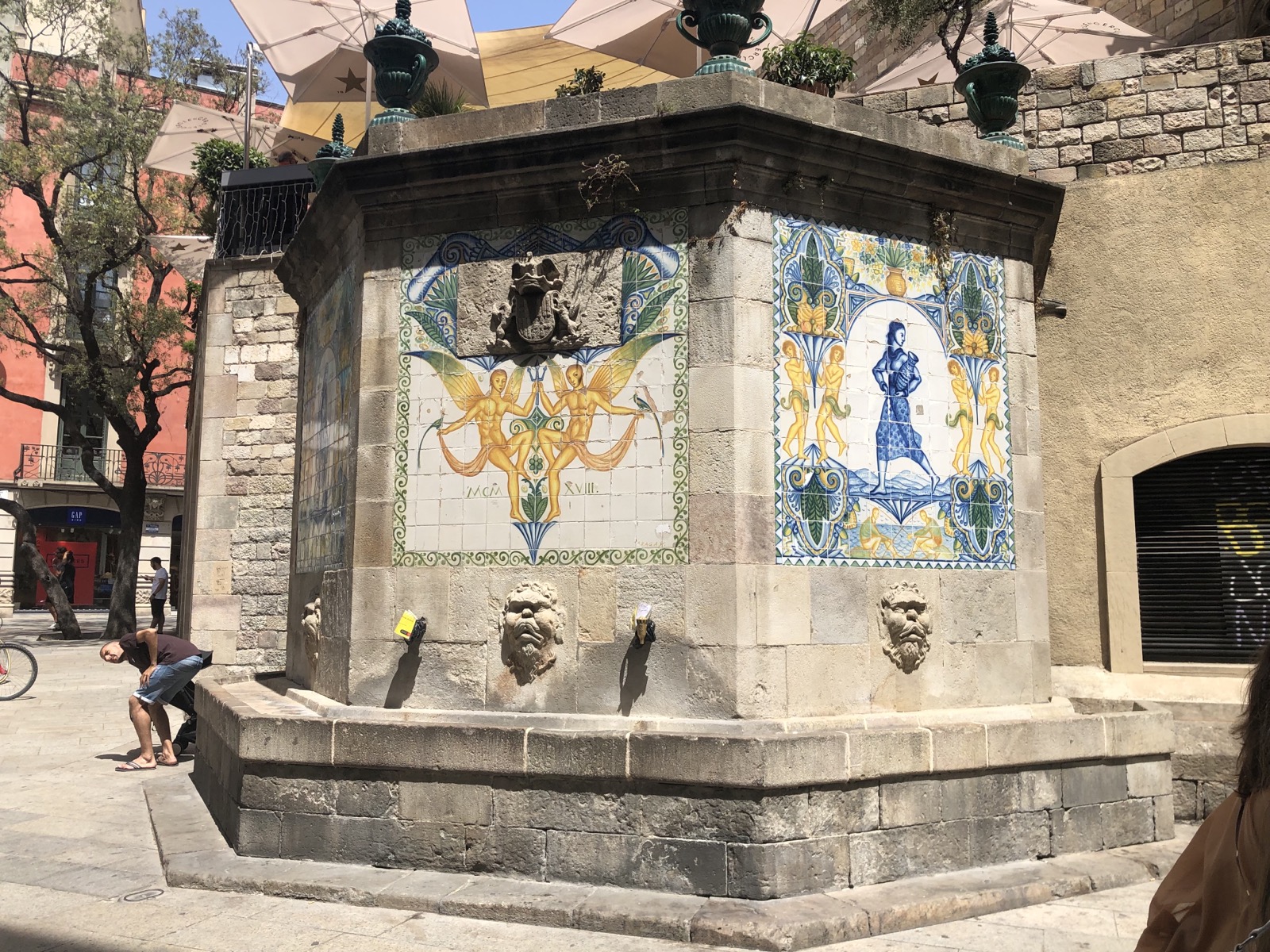
3515 I took this photo with no idea of the history of the fountain. I just liked the look. Some online searching revealed this si El Font de Santa Ana and is one of the oldest fountains in the city. The shape and structure is from 1819, but it was an animal drinking trough in Roman times and human drinking fountain since the 1300s.

3650 Finally it is time to leave. There are standard red busses that also go to the airport, but the light blue ones are express.

3667 The advertisement half of the screen occasionally showed the upcoming departures, which is a very nice feature. Fortunately I had no problems with my flights on this trip. I don’t currently know where my next solo vacation will be, but I hope it will be as enjoyable as this one was!